#(so I might have went to the cinema today and the film inspired me)
Explore tagged Tumblr posts
Text
There was a buzz of activity in the Neighborhood. Neighbors went to and fro as they completed their tasks for the day. If two happened to cross paths, they only stopped to chat for a moment before hurrying on their separate ways.
Wally, the resident known for being very easy-going, was the exception to this. He had taken a basket of items outside to enjoy the nice weather, claiming a large patch of grass away from the hubbub. A large, checkered picnic blanket was spread out underneath him, and one might be forgiven for thinking that he was having lunch. However, instead of a selection of food, there were art supplies inside the basket. Most notable was a large box of crayons, but there were also other items, like pencils, coloured strips of paper, stickers, and a notebook.
He knelt in front of a large art pad that took centre stage on the blanket. Black eyes were focused on the large, empty sheet. A bright red crayon was in his hand as he mulled over what to do. Then, inspiration. The hand went this way and that way, allowing the crayon to glide across the surface. With every movement, the lines began to join together, creating form and shape that went beyond disjointed red markings. An oval for the head, a long neck, an egg shape for the body, four sturdy legs, and... Wings?
Oh! He was drawing a dragon!
#the next episode (open starter)#(<- another tag for non-rp followers to blacklist!)#(open for rp peeps :D)#v; a lovely day in the neighborhood#(so I might have went to the cinema today and the film inspired me)#(if blogs reply to this that don't actually write; I will be ignoring it.)
25 notes
·
View notes
Text
The Chinese Cultural Inspirations for Dragon Ball Z and Super
Journey to the West was only the beginning.

A lot of people are vaguely aware that Dragon Ball was inspired by Chinese culture and Hong Kong Kung Fu movies and novels, but are unaware of how deep and long lasting it goes. The Japanese spent the 1980s fascinated by China, which opened up from being a closed society for decades in 1978; the most famous human being in Japan in the 80s was either Michael Jackson or Jackie Chan.
In fact, a lot of people commonly believe that the Chinese action movie and Kung Fu novel cultural and media influence on Dragon Ball ended very early on. This is untrue. Sure, we started to see qipaos and cheongsams less frequently when they headed to West City, but it absolutely did not finish, because there’s tons of influence to see even as impossibly late as Dragon Ball Super. Interestingly, I don’t think any of these point of inspirations have been pointed out before, mainly because a lot of Chinese adventure novels are simply not available in English.
The Piccolo/Gohan plot was inspired by the Chinese action novel “Heavenly Sword and Dragon Sabre.”
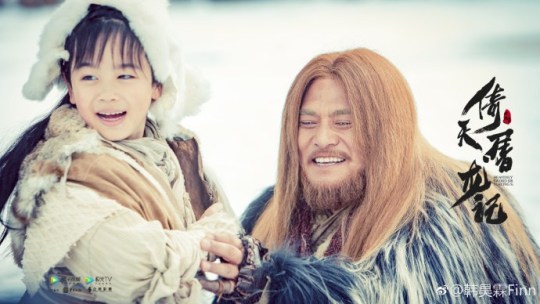
Okay, tell me if you’ve heard this story before: a truly demonic, weird looking monster villain is defeated by a martial arts hero, but by circumstance, is forced into training his greatest enemy’s young son. The villain trains the young boy, the son of his enemy, in martial arts and over time, becomes like a second father or uncle to him and his family, putting the boy in his “evil” sect, and thanks to his love of his rival’s son, this baddie turns over a new leaf and goes from evil to just…grumpy, and becomes a loyal, though gruff, ally of the boy.
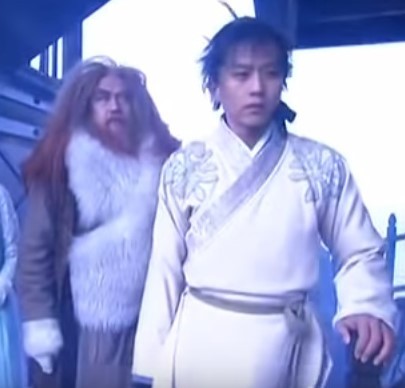
Of course, the events of Heavenly Sword and Dragon Sabre are a bit different from Dragon Ball in details. The Lion King becomes Wuji’s teacher because they are both stranded together on an island after a shipwreck, for instance, and he is blinded and made vulnerable. Also, the Lion King wasn’t so much evil so much as he was misunderstood by the orthodox martial world. However, in broad outlines, this trajectory for a face turn (becomes friends with his greatest enemy’s son, and becomes like a second father to him as he trains him, causing the villain to become a gruff good guy and ally) is essentially from one of the most famous Chinese novels ever written in the 1960s.
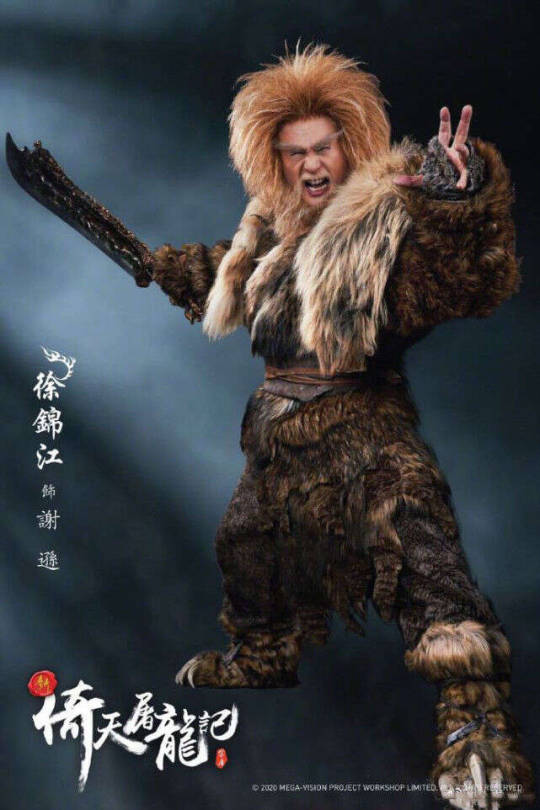
Oh, and while we’re at it, Gohan is likewise inspired by another character from a Louis Cha novel: the Prince of Dali Duan Yu in the Kung Fu novel Demigods and Semi-Devils. The Prince in that novel is a naïve, pacifistic scholar who prefers books to fighting, and who was raised to be timid and avoid combat, absolutely out of step with his family, all of whom are martial artists and warriors. In fact, the beginning of the story is the prince gets incredibly lost in the wilderness, where the hopelessly naïve prince is utterly out of his depth, with all the robbers and scary beasts, and needs to be saved by real martial artists that protect him like fairy godparents. He spends the first part of the story running away from everything, scared as hell. However, by circumstance, he has naturally high power he cannot fully initially control, and eventually realizes that even scholars and others who hate fighting have to sometimes become fighters to protect those they love.
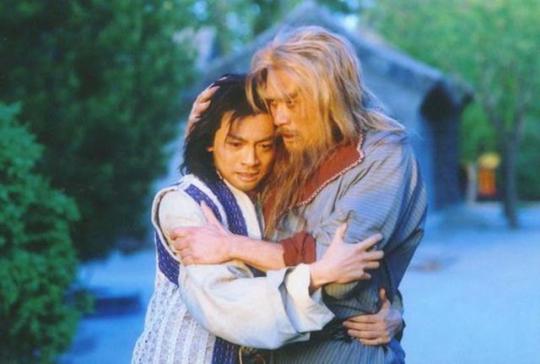
The Duan Yu part of Demigods and Semi-Devils was made into a film, the Battle Wizard, which was reviewed by PewDiePie. The Dragonball similarities went over his head because, honestly, PewDiePie does not strike me as a perceptive person.
Hit was based on the screen persona of Chow Yun Fat.
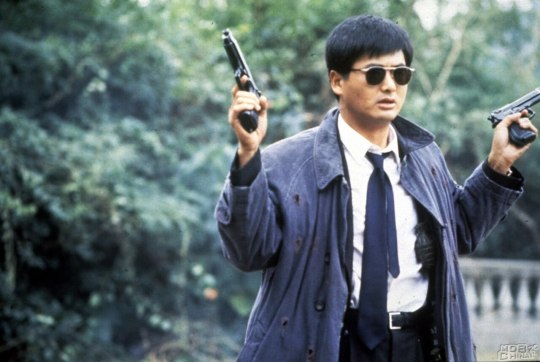
Chow Yun Fat was a Hong Kong cinema superstar who was to director John Woo what Robert de Niro was to Martin Scorsese. There are three giveaways that Hit was based on Chow Yun Fat. One, he’s an assassin, same as Chow Yun Fat’s character in the Killer, and is even given a sequence that’s a John Woo homage with an assassination in an office building with guns pulled on an empty elevator in an act of misdirection. Second, he’s wearing the single piece of clothing Chow Yun Fat is associated with, a black trenchcoat (fun fact: in Hong Kong today, trenchcoats are called Brother Mark Coats, after Chow Yun Fat’s character in John Woo’s A Better Tomorrow). Third, his power is essentially bullet time, a visual technique refined by John Woo in Hong Kong in the 80s and 90s in his gunplay triad movies starring Chow Yun Fat (what, you think the Wachowskis invented it?).
The Goku/Vegeta relationship is from “Legend of the Condor Heroes.”
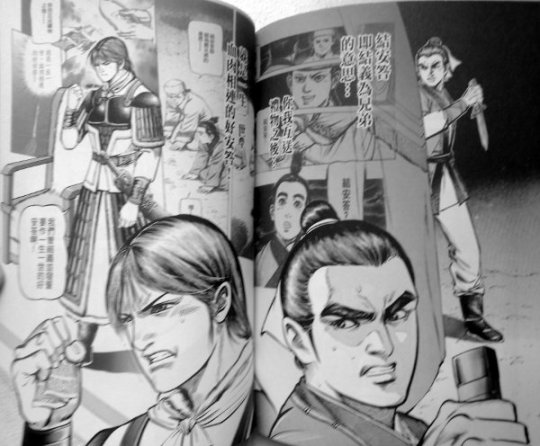
Here’s a story you might have heard before. It’s about two rivals, but by circumstance, one is raised in the wilderness beyond civilization, where he becomes an honest and goodhearted, though overly naive bumpkin, martial arts prodigy. The other is raised a wealthy prince by a conquering enemy, who grows up to also become an armor wearing martial arts expert, but also a cunning, arrogant, emotionally distant sociopath.
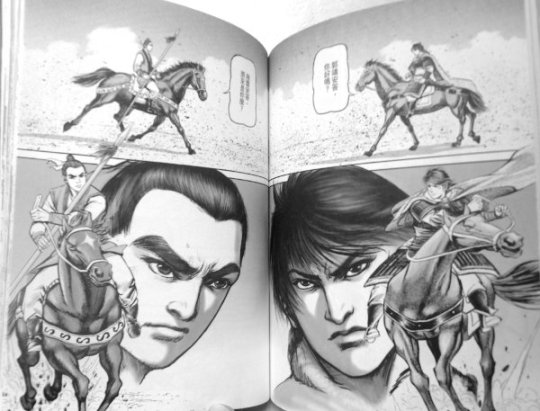
The similarities go into their love lives, too. The unsophisticated bumpkin hero is betrothed to a daughter of a powerful bearded barbarian king against his will, while the one hint of vulnerability and loss of emotional detachment in the otherwise sociopathic prince, the crack in his smirky arrogance, is that he loves a girl he otherwise pretends to hate, and even fathers a child with her who becomes a main character later.
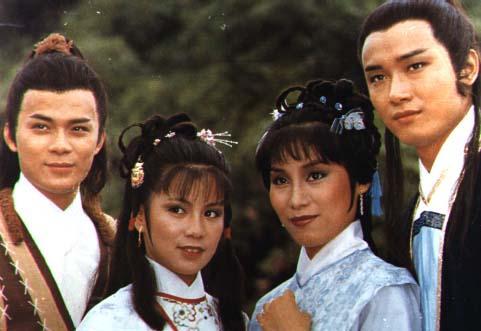
This is Guo Jing and Yang Kang from Legend of the Condor Heroes. The most fascinating similarity, and proof that female psychology is the same all over the world, is that the fangirls love the emotionally distant, arrogant, and sexy/evil prince (remember when Rhonda Rousey said her first crush was Vegeta?). Girls everywhere love bad boys and sexy villains, and oh boy, do they love Prince Yang Kang. I think you can probably guess who all the fan art is about for Legend of the Condor Heroes, and what ship is the most popular.
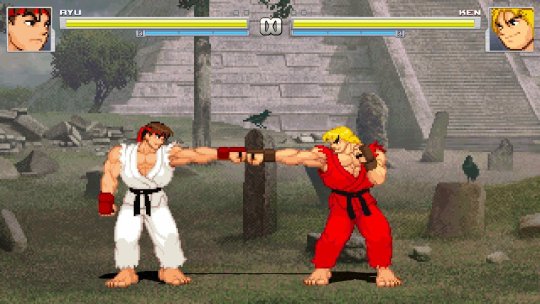
I have to emphasize that Legend of the Condor Heroes, which came out in the 1950s-60s, is possibly the most widely read novel by the most widely read novelist on earth - the sales on that dwarf Twilight and Harry Potter. It’s probably not an exaggeration to say nearly every Chinese person, even if they never read it, knows who these characters are. In fact, Yang Kang and Guo Jing from Condor Heroes are basically repeated over and over in Asian, Chinese, and Japanese culture. Does the unsophisticated but gifted martial arts prodigy bumpkin hero, and the glib, arrogant wealthy prince rival remind you of….another duo of rivals?
Gohan/Videl comes from Little Dragon Maiden

One of the most important and influential Martial Arts novels of all time is “Return of the Condor Heroes.” A sequel to Condor Heroes, this time, the main character is the teenage son of one of the main characters from the first novel. It gets even more familiar from there.

“Return of the Condor Heroes” was about a martial arts couple who are also master and student, the same age but vastly different in experience and skill so one somehow seems “older,” and they fall in love because the circumstances of training together requires they spend lots of time together and become intimate. The training story and the love story are exactly the same in “Return of the Condor Heroes.” The dead giveaway one story inspired the other is that in both, the most significant training sequence is one where the master teaches the student how to fly (though Return used a chamber of sparrows for lightness Kung Fu).

There are some differences of course – obviously in Return of the Condor Heroes, the genders of teacher and student are flipped from Gohan and Videl (it’s the Little Dragon Maiden who is a powerful teacher, and the boy who is the student). It was the girl (Videl) who was a rebellious delinquent in Dragon Ball Z, when it was the opposite in the novel, true. But it was obvious this story was in the back of the creator’s mind as a way to combine Kung Fu with the love story, by making teacher and student lovers.
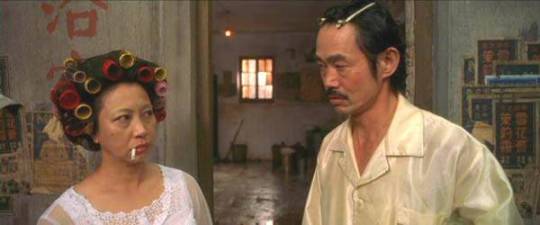
Addendum: hey, remember that awesome movie Kung Fu Hustle, the one Hong Kong movies normies have seen? Well, remember the landlord and landlady? The landlady was named Xiao Lung Nu, or Little Dragon Maiden, and her husband was named Yang Guo – the same as the main characters in Return of the Condor Heroes. It was a joke that went over the heads of Westerners, by giving these names of attractive and naïve young people in love with each other to a surly, bitter, arguing and chain smoking middle aged couple who don’t give a damn.
Going Super Saiyan comes from “Reincarnated” aka “Bastard Swordsman.”
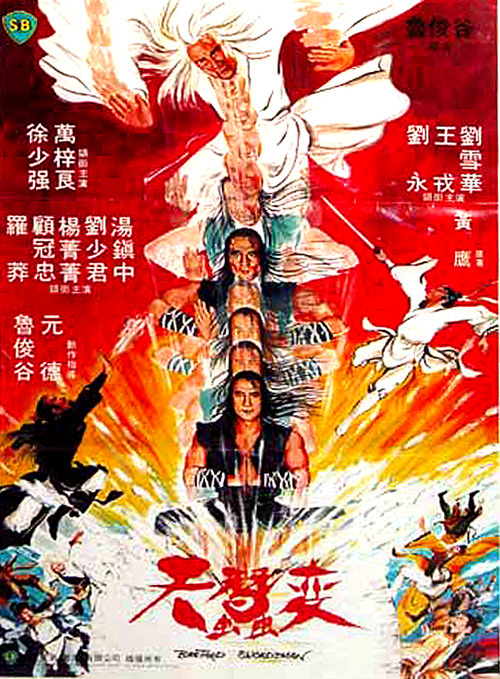
Stop me if this sounds familiar: a terrifying warlord tyrant prone to killing underlings who displease him has achieved a level of skill and cultivation so tremendous nobody can stop him. But there is one, and only one, thing he fears and that can defeat him: a long-lost legendary skill that nobody has achieved in recent memory, that includes a supernatural combat power transformation that turns the hair light to indicate it worked.

This is “Silkworm Skill” from Reincarnated aka Bastard Swordsman, a novel and TV series from Hong Kong in the early 1980s. Of course, there are differences. To get the power boost and new hair color, the hero has to jump in a cocoon he weaves himself. In fact, the scene is so well known that they actually have it on the poster.

(To those saying “Super Saiyan turns your hair blonde, not white” my response is that it turns hair white, or uncolored, in the comic book.)
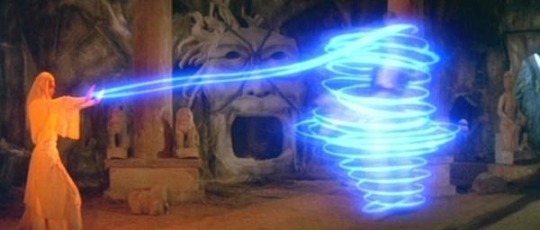
The idea of your hair turning white to indicate a new supernatural combat transformation or martial state wasn’t created by Bastard Swordsman, though – though it is the best example and probably the one most familiar to a 1980s audience due to the hugely popular books and TV series. For an older example, a famous Chinese movie based on a folktale is “Bride With the White Hair,” about a bride who’s hair turns white when she is betrayed, in her anger, she becomes less a woman and more a supernatural creature of vengeance (interesting that anger should be the means to unlock it).
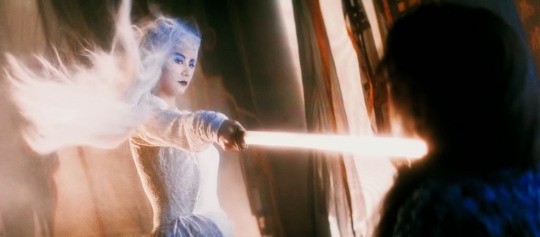
1K notes
·
View notes
Text
Marvel Super Special #22, Blade Runner

Before the home video era, there were precious few ways that one could experience a favorite movie away from the cinema, all of them imperfect to a degree. Perhaps the best known, and one that still exists today, is the movie novelization, in which your favorite film appears in book form. Movie novelizations have existed for nearly a century now; what we know of Lon Chaney’s famous lost silent film London After Midnight comes from production stills and the film’s novelization. When I was younger, I read quite a few. If you wanted to “experience” the latest R-rated movie—i.e. Alien, RoboCop, Predator, Aliens—and your parents weren’t going to take you, then film novelizations were the best option. They cost about as much as a full price movie ticket yet were more widely available, easily purchased from the paperback racks at your local grocery or drug store. Best of all, most novelizations were based on the film’s shooting script and featured scenes that failed to make the final cut.
Comic book adaptations of films have existed almost as long as novelizations. In some ways, comic books would seem to be a better, more truer way to adapt movies as the form combines both words and images. And when I was growing up, there were no better film to comic adaptations than the Marvel Super Specials. These were oversized issues that were a bit pricier than normal comics, running between $1.50–$2.50 at a time when normal comics were 30¢-60¢, so saving allowance or good behavior to get a parent to buy me one was quite often required. But they were gold—adapting all of the blockbuster films that I wanted to see (but, again, sometimes couldn’t) while also allowing me to relive them again and again in the comfort of my bedroom. Among the films featured as Marvel Super Specials included The Empire Strikes Back, Close Encounters of the Third Kind, Tarzan, The Dark Crystal, Battlestar Galactica, The Muppets Take Manhattan, The Last Starfighter, Dragonslayer, and Blade Runner.
Wait? What? Blade Runner?
Yes, in 1982, Marvel Comics published an adaptation of Ridley Scott’s masterpiece, Blade Runner, Marvel Super Special #22: Blade Runner went on sale May 25, 1982, according to Grand Comics Database, a full month ahead of the film’s release date, June 25. The adaptation then appeared as two issues that hit newsstands in July and August.
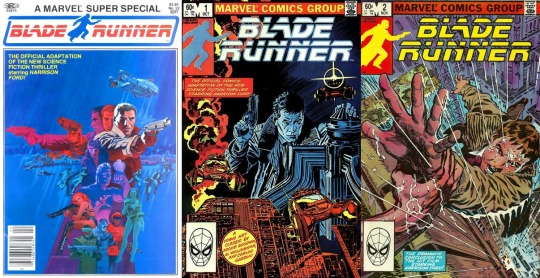
There’s a bit to unpack here. First thing, pretty much everyone reading this knows that Blade Runner is an adaptation of Philip K. Dick’s Do Androids Dream of Electric Sheep?. Yet the Dangerous Days: Making Blade Runner documentary makes clear that Hampton Fancher, the film’s original writer, regards both his screenplay, and the resulting film, as being inspired by Dick’s novel, and as adaptations go, it is very different. But, for years afterward—well into the 90s—the only published edition of the novel bore the film’s artwork and title. While this edition no doubt served as a gateway book for many who would go on to read more of Dick’s fiction, it’s not a great way of re-experiencing the film as it plays on the screen, unlike those novelizations I listed above. So the only contemporary (i.e. 1982) film-to-page adaptation of the film Blade Runner was the one published by Marvel Comics.
Well then, how is it you may ask? It’s a bit strange … and that has everything to do with both the film itself and the time it was released.
In 1982, comic books were still very much considered to be the domain of boys, 8 to 14-year-olds. Yes, this is a generalization: girls were reading comics; there were older readers, too; but unlike today, where there is a much broader readership for comics, the primary demographic were pre-teen boys—revisit those old issues, look at the ads inside and see if you don’t agree with me.
Now, here’s a question you might have: if you believe your readership demographic is going to be young boys (again, 8 to 14, though you might stretch that out to 15 or 16), then why are you adapting an R-rated, under 17 requires accompanying parent or adult guardian, property? This is a bit perplexing, too. It creates a demand to see the film among a group who had little chance of actually going to see the film. If a comic book adaptation is being seen as a promotional item to drive customers into the theatre, than it serves that the audience of that adaptation should not be impede from seeing the film in the cinema by the MPAA rating. Of course, when the producers approached Marvel about licensing the film for a comic book adaptation, the project would yet to have been rated. So, imagine yourself in Marvel’s position— you’ve been pitched a science-fiction film starring Harrison Ford, at a time that you are selling tons of Star Wars comics every month, which just happens to feature a character portrayed on-screen by Harrison Ford. Also, look at that list of films above adapted into Marvel Super Specials, most of them are sci-fi and/or star Harrison Ford. As such, Blade Runner sounds perfect, right? Of course it does. Neither Warner Bros. nor Marvel would be aware of the film’s rating until just before its release when all work on the adaptation would have already been completed. That said, based on the film’s themes and imagery present in the various draft scripts, an R-rating was highly probable, if not certain.
So come the summer of 1982, 8-year-old me couldn’t go see Blade Runner, and my parents were certainly not going to take me to see it, but I could buy the two issue adaptation for $1.20 total at the 7-11 spinner rack, or the oversized Super Special edition for $2.50. Again, both cheaper than a movie ticket. Yes, the nudity and violence from the film was toned down in the adaptation, but there was also no way that I would have seen the film, no matter how badly I wanted to.
Dan! Enough about movie ratings! What is the Marvel Comics Blade Runner like?
Again, it’s a bit strange… but you can read it here through the magic of the internet.
Have you read it? Do you see what I mean?
Okay, okay, for TL;DR persuasion, allow me to elaborate.
First off, Marvel’s creative team on the book was a stellar one: Archie Goodwin, who was one of the most beloved and well-liked figures in the industry for three decades, wrote the adaptation with artwork by Al Williamson and Carlos Garzon. Williamson was uniquely qualified for the project, having previously drawn Flash Gordon comics as well as the classic EC Comics sci-fi titles, Weird Science and Weird Fantasy. Goodwin, Williamson, and Garzon had all worked together on Marvel’s Star Wars series, including the Super Special adaptations of The Empire Strikes Back and, later, The Return of the Jedi. So you have a sci-fi experienced creative dream team in place, it should be great, right?
Well, if you’re a big fan of Blade Runner, then you are probably familiar with the film’s troubled production history, brilliantly charted in the aforementioned Dangerous Days documentary. The film’s script was in flux throughout filming. To briefly recap: Fancher’s original screenplay wasn’t quite working out so the production brought in David Webb Peoples for revisions and rewrites. Fancher would later return to contribute additional rewrites. However, well into post-production, the film still wasn’t “coming together”. Screenings for studio executives and test audiences were poorly received. This would lead to the love-it-or-hate-it voiceover narration being added to clarify the film’s action. All of this would have been problematic for a team working on a film-to-page adaptation. Given the production timeline needed in order for the comic books to appear concurrently with the film’s release, the Marvel team wouldn’t have been able to see a completed version of the film. Nor would a comic book adaptation be considered high priority enough to warrant that they be shown a rough cut much less any work-in-progress footage. Common practice with screen-to-page adaptations is to use the shooting script, but Blade Runner’s script was one being constantly revised and rewritten throughout filming and post-production. So my conjecture here is that Goodwin received a shooting script from the production but was unaware that the was still being tinkered with as dictated by post-production’s needs, requiring more and more revisions. And while motion picture footage might not have been available, it is clear that Marvel’s team did have access to concept art and production stills, allowing Williamson and Garzon to adapt and incorporate the film’s visuals into their artwork. The adaptation’s narrative is almost an impressionistic reading of the film with more than a few story beats that play differently.. Some of this would have been necessary to tone down the sex and violence to garner the Comics Code Authority approval needed at the time. Below are a few of those changes explored alongside screen-to-page comparisons—
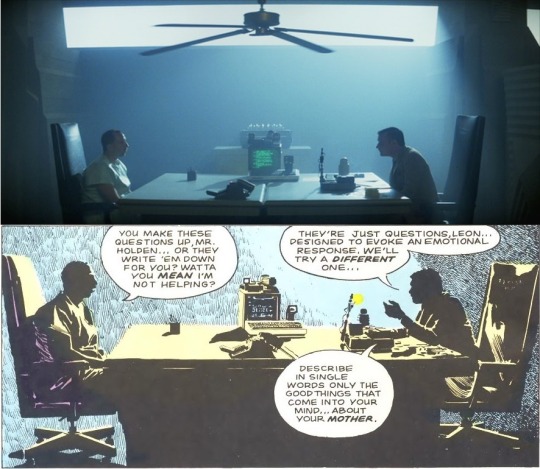
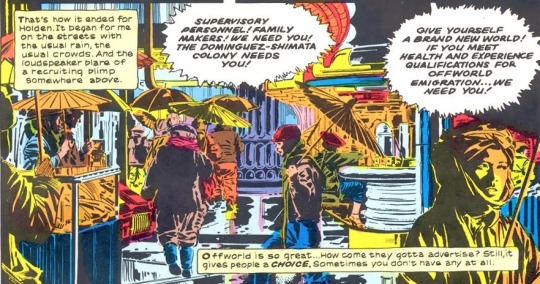
If you’re pro-narration, then you’ll probably love the comic. Like a Chandler novel, Deckard narrates virtually all of the action via the comic’s captions.

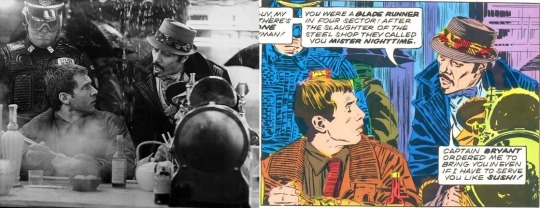
Gaff’s “Cityspeak” is one of the biggest divergences from the film in Marvel’s adaptation. Edward James Olmos improvised most of his patois during production, so little of what we hear in the film would have been in any script sent to Marvel—what does appear in the comic reads as stilted and just plain goofy.
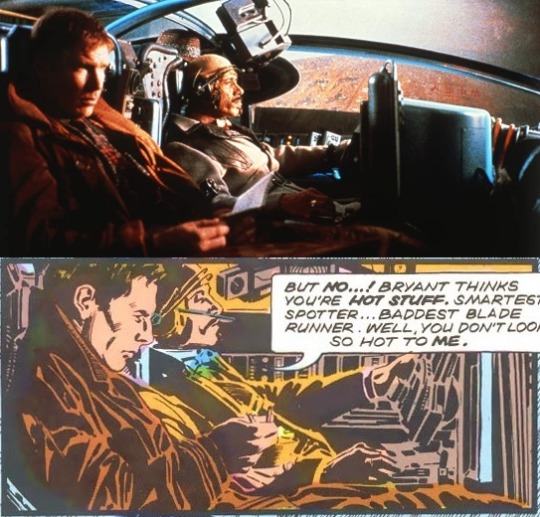

The comic never equates the “skin job” slur with the N-word, leaving the reader to rely on context to come to that understanding.
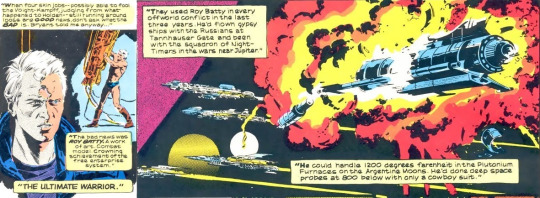
Here is why Roy is such a formidable bad ass, info cut from the finished film.
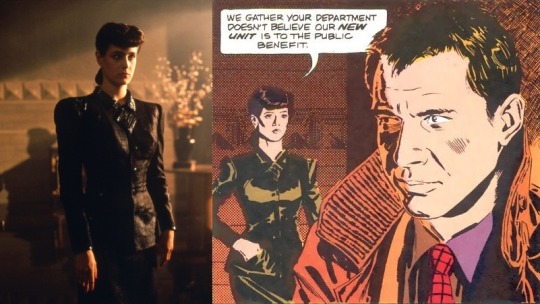
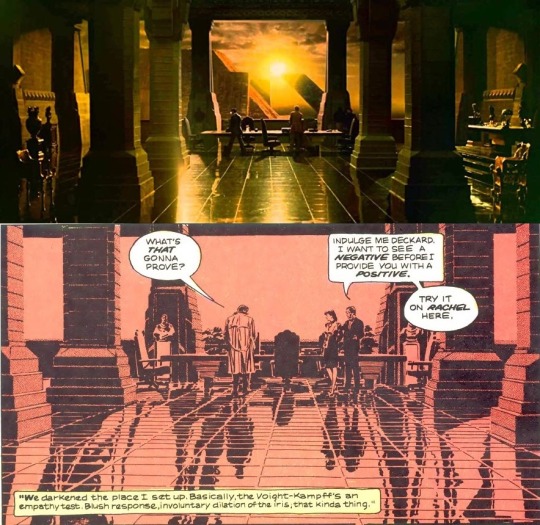
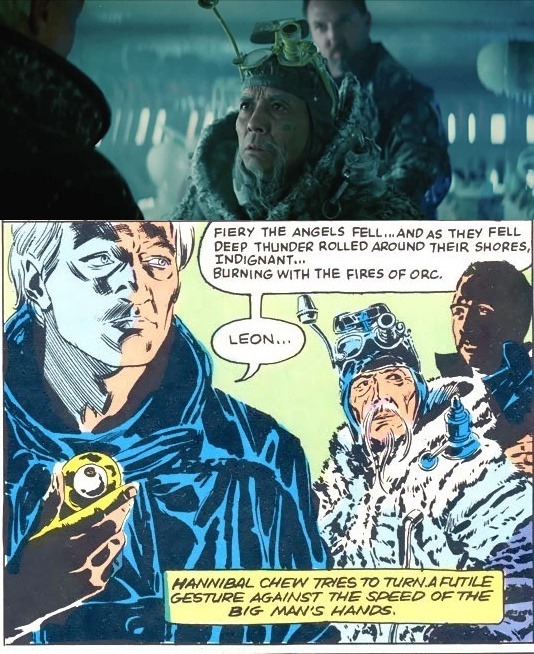
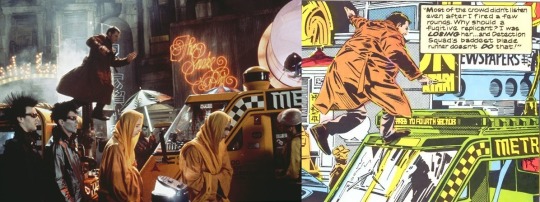
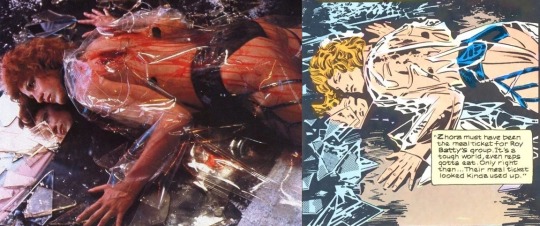
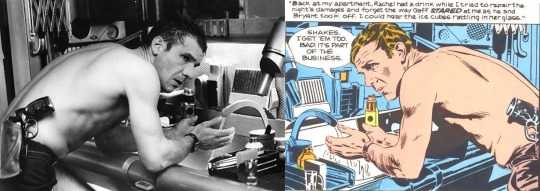
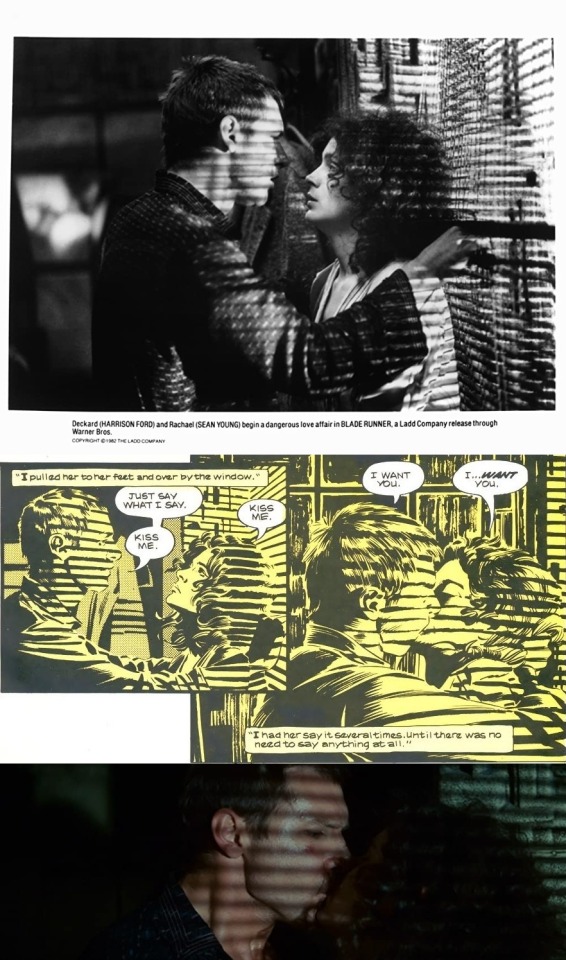
The film’s most problematic scene is still problematic in the comic, just in a different way. There are still consent issues present but Deckard’s raw aggression isn’t as evident on the page as it is onscreen.
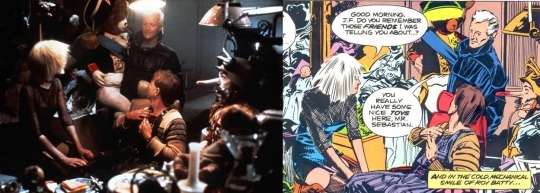
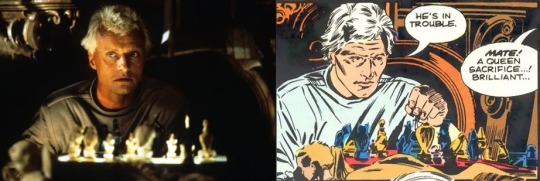
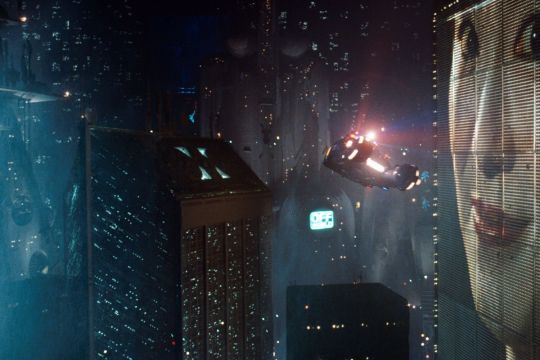
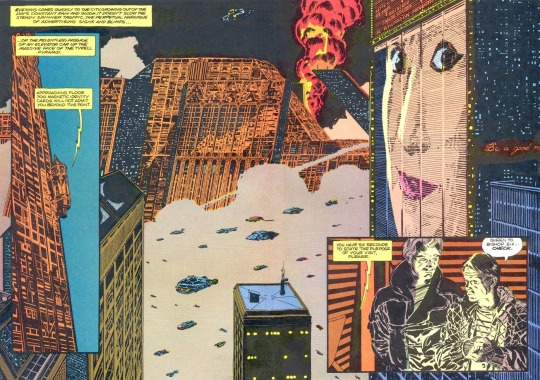
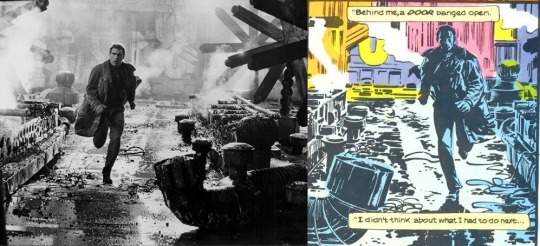
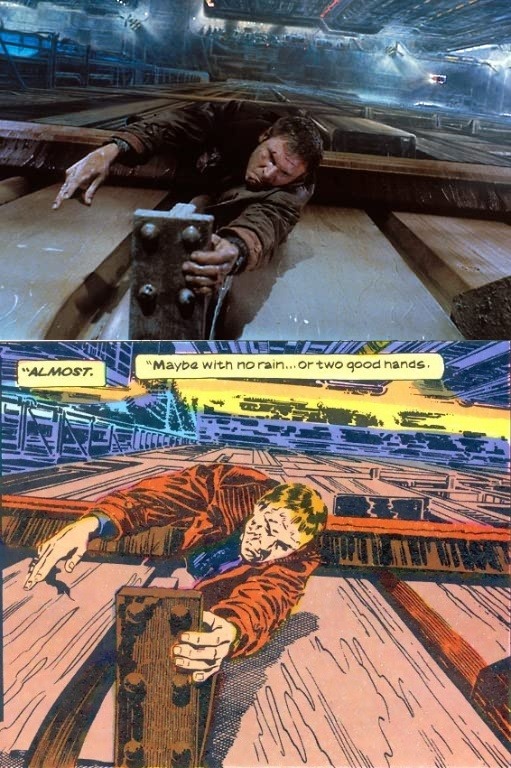
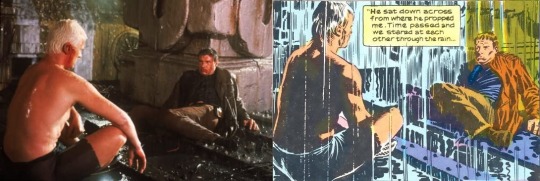

Roy’s famous poetic final lines failed to make it into the comic. Rutger Hauer improvised them during a table read, but those lines seem never to have been written into the script, or at least not the one sent to the Marvel offices.
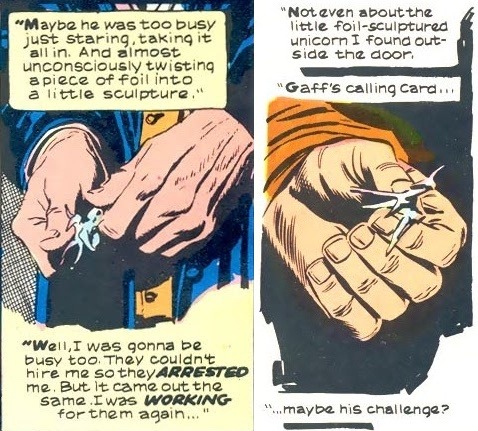
The unicorn is the most important symbol in Scott’s final cut, making the case for many viewers that Deckard, too, is a replicant. In the original theatrical release, the origami unicorn functions in two ways: first, it establishes Gaff visited Deckard’s apartment searching for Rachel; and second, it symbolizes Rachel’s unique replicant nature (no expiration date). In the comic, Gaff’s three origami dolls is reduced to one, the unicorn, but it makes two appearances. Deckard still finds it at his apartment just before fleeing with Rachel; however, the careful reader will notice the unicorn’s first appearance in Captain Bryant’s office, where it replaces the chicken. This shows, I think, that Marvel’s creative team intuited the importance of the origami unicorn while also seeing it as a baffling red herring—important enough to be included but its true context not being fully established in the script. To remedy this situation, the unicorn was added to the police station scene, creating a satisfying, if minor, plant and pay off moment.
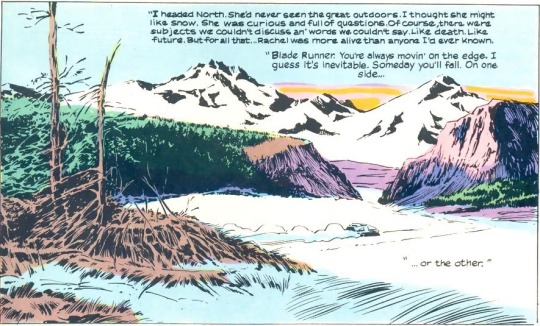
Marvel’s adaptation splits the difference between the U.S. release cut’s tacked on happy ending and the filmmaker’s original, more ambiguous intent made manifest in the film’s subsequent cuts. Why, exactly, “Blade Runner” as a title? Well, the final lines here spell it out for the reader.
#Blade Runner#Marvel Comics#Marvel Super Special#Harrison Ford#Rutger Hauer#Edward James Olmos#Sean Young
10 notes
·
View notes
Text
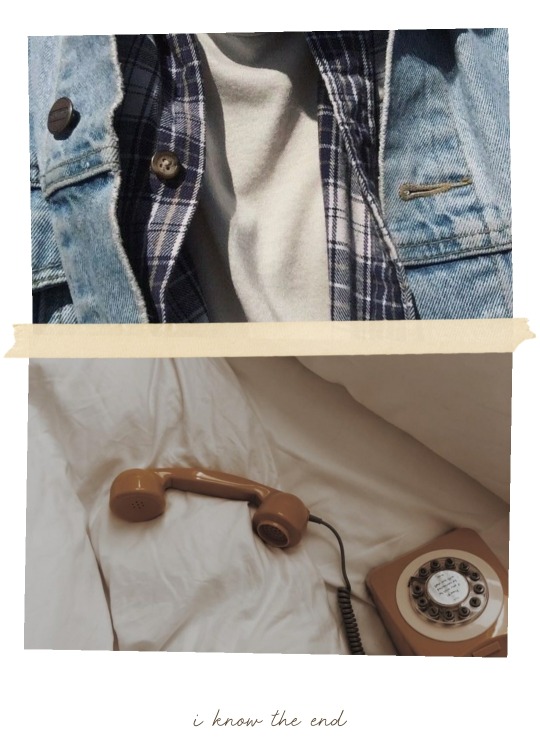
Summary: It’s the late summer of 2004. You are set to travel across the country for university and your best friend Tom is staying behind. You spend your last night together before you leave.
Themes: Friends to lovers, love confessions, first love.
Warnings: Drinking beer. One mention of smoking weed. Mentions of parents fighting and also implied neglectful parents. Smut (+18), two spanks?? otherwise pretty tame.
Word count: 3,4 k
Notes: I don’t know, this might be a bit different? Or it might just feel that way to me. It’s very reminiscent of teenage years and first love and nostalgia. Please let me know your thoughts, I’m genuinely not sure what to think about this one.
Massive thank you to @augustholland who read through it and very kindly reassured me that it wasn’t bad 💖
Also, this fic was inspired by the Phoebe Bridgers song. I’ve never actually listened to it but it keeps showing up in my recommendation and i like the title of it so this is what i imagine that song is about. Mostly I listened to Harry Styles - Fine Line while writing this.

You finish up early that afternoon. Wayne, your old boss, tries not to cry as he hugs you goodbye. He tells you to take care in a gravelly voice close to breaking, as he avoids looking at you. It’s your last shift in the greasy bar, where for the last two years you’ve been selling cheap beer and watered down whiskey to weary old men and rowdy students who come in for a game of pool. It hasn’t paid much, just a few pounds an hour; just enough so that on each thursday you and Tom have enough money for movie tickets at the local cinema. It’s your tradition. Like a religious man goes to church each sunday; you spend your thursday nights with Tom’s arm slung around your shoulders, watching whatever new film they have on, sharing a bowl of popcorn between you. Afterwards you'll have burgers at the fast food joint across the street; talking about the movie long into the night, sharing a bag of fries.
When you were younger and hadn’t been able to afford to pay Tom had sneaked you both into the cinema anyway. Your hand in his, he had led the way into the movie theatre when no one was looking. Sitting in the back row he’d sneak you Fruit Polos to snack on, his arm slung around your shoulders, as you watched movies you were way too young for.
Last week was your final movie screening; some light-hearted American comedy, and the entire way through it you fought the lump in your throat, forcing yourself not to cry. Tom hadn’t laughed either; had just held you closer than usual.
Tomorrow you are set to leave the small seaside town behind you, the place where you have spent most of your life, for a drive all across the country; to start university in a city you’ve only visited once before. You’re not sure when you’ll return.
Thus lately everything has been laced with goodbyes; childhood having reached its end.
Just two days ago there had been the last bonfire where you had watched the Holland boys fight each other while playing football as his parents looked on and laughed, grilling sausages over the open fire.
It was on the same rocky beach where you have spent many summer days; grilling food on the open fire and throwing back cheap beer with your friends from school. You have scraped your knees on these rocks, burned your skin from both the bonfire and the sun there; have had your heart broken over and over and over again during your school years as you watched Tom kiss whatever girl he was dating at the time by the fire during summer night parties.
Maybe you had broken his heart a few times as well.
As the afternoon light turns everything golden you drive through the main street in the small town where everyone knows everybody, and has done for generations. You watch the people as you drive them by. You know everyone’s name, know each crack in the pavement; can find your way home in the dark.
God knows how many shoes you’ve worn out over the years walking down these streets.
The radio plays a blink-182 song you know by heart as you follow the road out of the city, through the woods and up to the coast. At the end of a muddy track, on the border to the forest, stands a shabby old caravan. It faces the beach and above the door christmas lights are lit up all year round.
The Holland family legend says that Tom’s great uncle had won the small patch of land in a bet. Unable to build a large house he had bought a caravan and put it on the lot. The old man had lived in the Shed for the rest of his lifetime, before passing it on to Tom; the youngster of the family, his younger brothers having yet to be born. When he had turned seventeen he moved out of his parents larger, more comfortable house, and into the Shed. His mother had agreed on it on the condition he took on the apprenticeship to become a carpenter that he had been offered.
You remember when he had told you of his decided future, one late evening as you sat on the driftwood by the beach, smoking weed and watching the sun set over the horizon. It had felt right somehow, you had been able to imagine him working with his hands, skillfully forming and bending wood to his will; his long and slender fingers knowing just how to fix things. Tom has always been good at mending things. It had been three years now and he was a full time employee at the JBT Carpentry Services. He says it doesn’t pay much, but he’s happy; and that's all that matters.
As you park the car outside the Shed Tom comes out. Standing under the colorful christmas lights he grins widely as he sees you, his eyes crinkling at the sides. The most genuine smile you know. He’s tanned from a summer spent on the beach, his hair a wavy mess; as if he’d just woken up from sleep. It’s a warm august day and the world seems sunbleached somehow; but in the afternoon light Tom looks golden.
You are painfully aware that it is the last time you’ll see him like this for many months to come.
Walking up to him and he gives you a bear-hug; his warm, hard body pressed against yours, holding onto you tightly. With your face in the crook of his neck you breathe him in and discover that a faint trace of bonfire smoke still lingers on his skin. It all feels achingly familiar and safe. So heartrendingly unlike the uncertain life at university that lies in front of you.
Tom is your safe place.
Your parents had always fought like cat and dog and sometimes when you were younger and they’d argue you’d climb through your window and walk all the way over to the Holland household. You were always welcomed there and his parents didn’t ask any questions, no matter how late the hour; instead they fed you, treating you like a member of the family around the dining table with gentle teasing and reminders of homework that needed to be done, letting you sleep over when needed. No questions asked.
With the years the fighting at home got worse. When Tom fixed himself a beat-up old Land Rover and moved out to the Shed you’d call him from the payphone down the road. He’d always answer, telling you to pack up; and that he was on his way. He’d pick you up by the end of the street, a duffle bag with schoolbooks and a change of clothes slung over your shoulder. He’d take you back to his place to sleep. His caravan only had one bed, so you used to curl up next to each other in bed. On the nights when you were crying he’d hold you, and in the morning he’d make you breakfast before you both went off to school.
Your parents never noticed your temporary absence.
Tom lets go of the hug, but with an arm around your waist he leads you into his home. There’s a lingering scent of fried food in the air and the boombox is playing the 3 Doors down CD he’s been obsessed with since you bought it for his birthday. You tread the cherry wood veneered flooring with your battered tennis shoes, feeling more at home here than anywhere else on earth.
“Fancy a beer?” Tom asks, leading the way to the kitchen area. “Warn you though, it's warm. Just got back from the store so they haven’t had time to cool”.
Everything is warm today, and the caravan is no exception. The ancient AC had given in years ago and Tom could never afford having it fixed. You heave yourself up on the countertop, replying a simple “sure” to his question.
He opens a Stella and hands it to you. He isn’t wrong, the beer is tepid. Yet you drown half the bottle in one big swig; happy just to have something to do with your hands when he’s standing so close to you. Gulping down on the liquid and you cannot help but notice Tom’s eyes on your throat as you swallow. He opens a bottle for himself and takes a swig.
You smile at the ancient gray t-shirt he’s wearing. At one point there had been a band logo on it, but it has long since been washed out. He notices you smiling at him and as if it's infectious a smile broadens on his face as well. “What?” he asks, leaning against the small counter across from you.
“Nothing” you say, smiling wider. “Just wondered how many times I’ve seen you in that shirt. I mean, it has to be near a couple of thousand times by now”.
“You don't exactly love buying new clothes either” he says, a teasing smile playing at his lips as he looks at your washed out jeans shorts. “I know for a fact that those aren’t new, darling”. His eyes linger on your legs for a moment too long before he looks away, taking a swig from his beer.
“So, when are you leaving?” He asks, and you can tell that he’s trying to sound relaxed, but leaned against the countertop, his arms crossed in front of him, head bowed; holding onto the bottle of Stella he’s nursing with a tight grip. He looks tense and on edge.
“Tomorrow morning”
He takes a swig from his beer. There’s nothing more to say, not really. Everything that happens now is just aftermath; you might as well have already left.
“I’m nervous” you admit, biting your lip, trying hard not to et out the tears you’ve been holding in for days now; embarrassed that your voice trembles on the last word.
His head snaps up to look at you. Pushing off the counter he takes a step forward, placing himself in between your legs.
“Hey” he says, with a voice a low and gentle as a whisper, his hand cupping your cheek. You look up at him; long dark eyelashes framing his beautiful brown eyes, his thin lips slightly parted and across his nose freckles are spread out, the result from a summer spent in the sun. His calloused hand strokes your cheek. “You’re going to take them by storm, Pebbles”.
You smile, despite your fluttering heart. He hasn’t called you Pebbles for a long time. It had been his nickname for you when you first became friends, the reason behind it long forgotten. He was the only one to ever call you it, and the name had lingered long into your late teenage years.
“You took me by storm,” he admits.
You blink up at him through wet eyelashes. Your family had moved to the town when you were ten years old. This was the kind of small town that strangers seldom came to and inhabitants rarely left; and so the new addition to the small local school had everyone talking. You had felt like an astronaut shuffled into space on your first day, trying to find gravity in the unfamiliar school corridors. You had felt the pull of gravity in form of the brown-eyed boy sitting next to you in english class. He had given you a warm smile as you sat down next to him. He had made you his friend, listened to you and confided in you; had made you laugh until your stomach ached. You found further gravity in his home; surrounded by his family and their endless squabbles and laughter, sitting next to Tom at the dinner table.
It hadn’t taken long before you and Tom were an inseparable item; your names always linked to one another in the mouths of others.
“You’ve worked so hard for this scholarship” he says, and the corners of his mouth tugs up into a smile, “I mean, I’m pretty certain you’re the only reason I even finished school”.
You had helped him write most of his essays at school. He’d struggled with reading a lot and found the assigned novels difficult. There were evenings where you’d spend hours laying on the bed; twisting the phone cord between your fingers, as you read the books out loud for him.
Sometimes, in order to be left alone from his parents and younger brothers, he’d walk down to the end of the street and to the payphone there, where he’d spend all his pennies listening to you reading. You had talked and talked until your voice got hoarse; until he ran out of pennies. Yet when he hung up you always felt a tug of longing in your chest, knowing you wouldn’t be able to see him until the next day in school.
“Well, I heard you’re doing pretty good as a carpenter” you say, smiling up at him. “I always knew you’d be good with your hands”.
As soon as you’ve said it you can feel your face heat up. You had heard the rumours at school; Tom Holland is a stellar fuck. Once, while you were in the bathroom stall, you had heard a gang of girls discuss it as they reapplied their lipgloss in the mirror. One of them told the story of her one night stand with Tom, how he had made her come several times over with his hands and mouth; how he’d fucked her so long and so good. You had stood in the stall, your heart in your throat; feeling sick to your stomach, but unable to stop listening.
There were girls that reached out to you in school, knowing you were Tom’s closest friend, and asked you in hushed but awed voices if it was true. If he really that good in bed.
He looks you dead in the eye, an unusual seriousness to his warm eyes. He knows what you’re thinking, knows what thoughts have made your cheeks flush with colour. Letting go of your cheek he places his arms on either side of you on the counter; caging you in.
“There’s never been anyone but you, Pebbles. Not really.” His tone is heavy with meaning and you feel light-headed; both oddly detached from your own body and painfully aware of the closeness of his. Your heart is beating hard in your chest.
This is a line you’ve never crossed before.
“I know I’m ruining everything by saying this, but you’re leaving tomorrow and I’ve been walking around with this secret lodged in my chest like a bullet since i was ten years old; I love you, Pebbles. I’ve always have”.
You should speak. You should tell him that you’ve known for a long time how he’s felt. That it’s been evident in the way his eyes keep lingering on your legs, in the way his arm usually finds its way to rest around your waist. In the way he’s always been there for you. You should tell him that you understand why he hasn’t been able to voice his feelings for you; because you haven’t done it either. Too scared of losing him. But your breath has caught in your throat and all you can focus on is those caramel eyes on you, and how hard your heart is beating in your chest.
“I love you too” you say, voice hardly louder than a whisper. You swear there was music coming from the boom box but all you can hear is the blood rushing through your body.
He kisses you.
He takes your mouth slowly, kissing you thoroughly until you can’t think straight; can’t remember any other kiss than his. Then his lips move over yours with more fervour; more urgency, one hand around your throat and the other tangled in your hair. He kisses you until you're both moaning and gasping for more.
This is it. You’ve crossed the invisible line between friends and lovers; and there is no return, no going back from here. When you leave tomorrow you will leave knowing what his mouth feels like pressed against your.
You dig your hands into his soft hair, runs them both up his chest, realising that this is what your hands were made for. He lifts you off the counter and you wrap your legs around his waist. He moves you both across the caravan and into the bedroom. It’s baking hot in there and you can already feel sweat forming at the low end of your back. The room, just big enough for a bed to fit, is lit up with sunlight. His bed is a mess of rumpled white sheets and the walls are the same cherry wood colour as the rest of the caravan.
You kiss and lick his jaw, his neck, his throat; anywhere you can reach you stroke him. You tug at his hair, kiss his soft lips, and nib at his ear. It’s like the gates have been opened, because even though his arm has always been a comforting presence around your waist; and even though you’ve slept in the same bed more times than you can count, his body curled up next to yours, forming himself like a question mark around your body; he’s never been yours to touch before. Not like this.
His breathing is accelerated, his chest rising and falling in rapid speed, and so is yours. There’s a heat to his eyes that tells you he’s just as turned on as you are. You pull at his shirt before he’s even laid you down on the bed; impatiently craving all his warm, suntanned skin pressed against yours. It’s an almost feverish frenzy, and in the back of your mind you know that you should take this slow. You don’t want this to end too soon, because this might be all you get. But the sun hasn’t even set yet and through the old white-washed curtains you helped put up and light shines through, bathing you both sunshine.
Outside the waves keep crashing against the shore and in the kitchen his boombox keeps playing songs you’ve heard a million times before. It is like it always has been at Tom’s, except that for laying on his sofa and talking he’s removing your clothes; kissing his way down your body. Wet, opened mouth kisses that leave a trail of heat in its wake that have you bucking your hips up for more. His hands are everywhere, exploring your legs. He’s looking at your skin with wide-eyes adoration. With his body in between your wide spread legs he kisses the soft inside of your thighs.
“So soft” he groans against your skin, “and so sweet”.
You feel overheated and breathless; aching all over from wanting him. Perched up on your elbows you observe him; his dark hair brushing against the low of your stomach as he kisses the tender skin of your hip bone. He bares his teeth and bites the sensitive flesh.
His hand cups your cunt. You’re wet and aching and as you presses his thumb to your clit, gently but steadily moving up and down, you feel like you’re going to combust. His strokes are soft at first, before speeding up, making you moan wantonly, spreading your legs wider for him.
“Glad you like that,” he says, a satisfied smile spreading on his face. “Do my fingers feel good on you, darling?”
All you can do is moan in response, arching and moving your hips up to meet his hand. His movements are fast and slippery and it doesn’t take long until your close, so close, so close; on the brink of tipping over and then -
A sharp slap on your pussy, leaving a stinging bite, and it is like the world splits into two.
“God” you moan, voice hoarse. You’re shuddering all over; moanes falling freely from your lips.
He looks up at you from his position in between your legs, his dark eyes sparkling. He kisses the soft inside of your thighs again. “You have any idea how long I’ve wanted to kiss you here?” he asks. “I bet you do, torturing me for fun in those short jeans shorts”. He spanks your pussy again and you couldn’t have stopped the moan falling from your lips even if you tried. “How long I’ve wanted to taste you here?”. And he places a hot kiss on your wet slit. You can feel his soft hair pressed against your thighs; his warm breath against your skin.
His lips part and he covers you with his mouth, his tongue moving over your opening; touching you, stroking you, tasting you. A guttural moan leaves him. He looks up at you through tassels of hair, caramel eyes glued to your face.
You fall back against the mattress, “more” you demand, in a voice that sounds a lot like begging. “Please, more”.
It is as if he’s been unleashed. You have never felt anything like it, but he laps you up, tastes you; his fingers moving inside you; pressing against the place that has you seeing stars. You can’t even look at him now, you’re eyes shut; too overwhelmed by the stimulation. Both aching for more but not sure if your body can handle that kind of pleasure. Your thighs are shaking, and something in your stomach grows tighter and tighter by each flick of his tongue against your clit.
“I’m coming” you cry out breathlessly “fuck I’m coming”
And you do. Hard. He keeps kissing and touching you through it; both grounding you and dragging out the intense sensation.
His hands, now familiar with your thighs, make their way up to the soft swell of your breasts, as you struggle to regain your breath. He’s cupping them in his hands, pinching your nipples in between his fingers, kissing them with ferveor. Hungry hands move over your breasts, your stomach, your face; cupping it so that he can kiss you with the sort of yearning that comes from years of unanswered desire.
Your hands move over his body as well, moving over his abdomen chest and arms, defined from long hours of hard work. You kiss his throat and collarbones, kissing at the skin; licking, sucking and biting until you hear guttural moans coming from his throat. His lips are slightly parted, and his glossy dark eyes are fixed on your face; his fingers loosely tangled in your hair.
He presses you down onto the mattress again, until he’s face to face; his arms on each side of your face, holding himself over you.
“You sure?” he asks, voice hoarse, panting slightly.
“I want this” you answer him, voice low but clear, “I really, really want this Tom”
He smiles, breathing out the breath he’d been holding and moves away from you, reaching for the side of his bed and to take out a condom from the drawer.
He places a quick kiss to your lips, your cheek, your belly button, before he sits up. He removes his underwear and you can feel your face heat up again. Because this is Tom, your Tom, whom you’ve been in love with for half your life. But being with him, both naked as the day you were born, feels right. You know everything about this man, all his preferences and secrets; his favourite movie and how he likes his food and why he skipped class every day for a month in year nine. And he knows everything about you. It feels right that he should know this as well; know each curve of your body and the way you like to be kissed and what has you moaning and begging for more.
He unwraps the foil package and puts the condom on with firm fingers. Leaning over you again he lines up against your opening. His eyes glossy with lust, damp hair falling over his face; his mouth swollen and wet from kissing you.
Then with a sharp thrust and a groan he’s inside you.
All coherent thoughts go out the window as he starts moving in and out of you. The only thing that exists is his strong, sweaty body above you, moving in and out of you with slow, deep thrusts. He’s so hard where you are soft and you can’t stop touching him, dragging your fingers over his back, pulling at his hair, kissing his arms. It’s like the wires in your brain have crossed, sending out sparks of pure pleasure in your body.
He hits a particularly tender spot inside you and the groan that leaves you is almost animalistic.
Tom nearly halters in his pace, before collecting himself again. “Fuck” he moans out, kissing your neck. His movements become more frenzied and you roll your hips under him, meeting his movements; trying to get him deeper inside you.
He pushes himself up onto his hands, pulls back slightly; and pushes in. Starting to really fuck you.
You can’t stop looking up at him; naked body damp with sweat, muscles moving as he works; arms flexed and cheeks flushed. His eyes are closed pleasure now. Your hands are on his hips helping him set the pace as he fucks into you with fast, hard thrusts. Without warning you clutch around him in pleasure and he groans loudly.
“How the fuck does your cunt feel better than it tastes?” he asks, panting for air. “
He presses a hand over your heart, letting it rest there. You wonder if he can feel it pounding for him. You feel like you’re dissolving into a thousand tiny pieces as you come around him with a choked scream.
He’s so close and you can practically feel it; aching for him to have it. You want him to come; in you, on you, over you.
And then he does, his brows furrows; like the pleasure is so intense it hurts him. The sounds he makes when he comes are guttural; almost whimpering.
As he falls down on the bed beside you he pulls you close, has you pressed against his body, an arm firmly wrapped around you. The sun has set now, but the ocean waves still crash onto the shore, the sound of it the only thing to fill the silence part from your laboured breathing; the music having gone quiet in the other room.
Neither one of you say anything. You knew the end to this when he kissed you. You’ve regretted nothing that has happened here, and you know that he doesn’t either; but tomorrow you are leaving to drive all the way across the country and he cannot follow. You don’t know what will happen now, and he doesn't have the answer to that either. And so you just let him hold you; wishing with all your might that you could stop the morning from coming.
***
Please let me know your thoughts, genuinely don’t know what to make of this one.
#tom holland#tom holland smut#tom holland x reader#tom holland x you#tom holland imagine#tom holland fanfic
157 notes
·
View notes
Text
50 Years Later: The Still Sweet Legacy of Willy Wonka and the Chocolate Factory
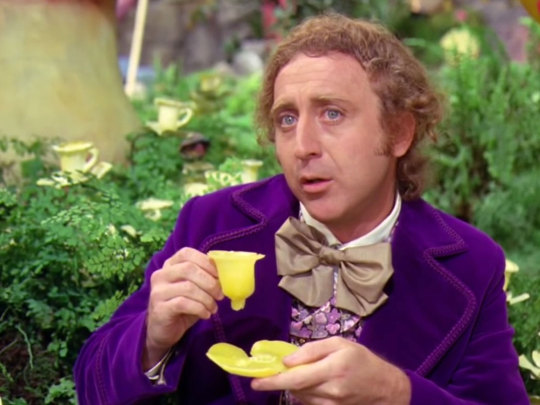
Image source: https://people.com/food/gene-wilder-death-willy-wonka-pure-imagination/
I first watched Willy Wonka & the Chocolate Factory during the summer of 2001, when I was four years old. Sometime after the end credits rolled, I waddled into our little English garden and decided to have a nibble of one of the buttercups poking through in the grass. You will be unsurprised to discover that it tasted acrid and bitter and that I promptly screwed up my face and spat it out again. ‘But— but- -’ little four-year-old me thought, ‘—but in Willy Wonka’s garden the yellow butter-tea-cups are edible and filled with a breakfast brew! The toadstools and mushrooms ooze sweet white cream! And the trees don’t sprout boring old fruit, but giant jellified gummy bears!' According to my four-year old logic, in Wonka’s edible garden these synaesthetic saccharine delights could exist and so in our garden they could too. So was the bittersweet belief that ‘Anything is possible’ the film inspired - bittersweet because, of course, it's not true. Today marks the 50-year anniversary of Willy Wonka & the Chocolate Factory, which premiered in the United States on this day in 1971. Time reveals a legacy that is more sweet than sour.
The 1971 adaptation of Roald Dahl’s 1964 book ‘Charlie and the Chocolate Factory’ has an origins story that reads like a saccharine fairytale, complete with the requisite obstacles. Once upon a time, the story of Charlie Bucket and his lucky visit to a chocolate factory found its way into the hands of a 12-year-old girl called Madeline Stuart, the daughter of a Hollywood filmmaker, Mel Stuart. Madeline approached her father and asked him to make a film out of the story. In Stuart’s memory, his daughter’s innocent plea went something like this: ’Daddy... I want you to make this into a movie!’ A self-confessed chocoholic, Stuart said yes. And the rest was history? Not just yet...
The early 1970’s wasn’t Hollywood’s happiest hour. Low attendance and a struggling national economy meant that the U.S film industry was in a state of near-collapse and financing the movie was no easy feat; studios were cash-strapped. It was a stroke of sweet luck that the producer of the film, Mel Stuart’s friend David Wrober, had a connection to the Quaker Oats Company who, by happy chance, were looking for a way to break into the chocolate industry. In an unprecedented move in Hollywood, Quaker Oats agreed to finance the film on account of the fact that it would allow them to launch a ‘Wonka’ bar. A convenient if imperfect marriage was formed between the food company and the producers. A Happily Ever After? Still not yet...
There were active forces that didn’t want the candy man to make the leap from page to silver screen. Having long been vocal about Hollywood and its poor representation of black people, the NAACP objected to the adaptation because of the colonial overtones of the Ooompa Loompas in Dahl’s story (described as “a tribe of miniature pygmies” who were imported from Africa); they didn’t want additional attention being brought to the novel. The NAACP eventually suggested that “The solution is to make the Oompa-Loompas white and to make the film under a different title.” Mel Stuart agreed. The title was changed to ‘Willy Wonka and the Chocolate Factory’, a change that would also benefit the marketing of the Quaker Oat Company’s ‘Wonka’ bar. After Stuart consulted with some black actor friends, it also was decided that the elf-like characters would be carrot orange with grass-green hair. Whether this amounted to ‘whitewashing’ or not is a matter for the individual to decide but changing the skin colour was the only way to adapt the book without making more significant changes to Dahl’s story. After all, it was the man himself penning the screenplay.
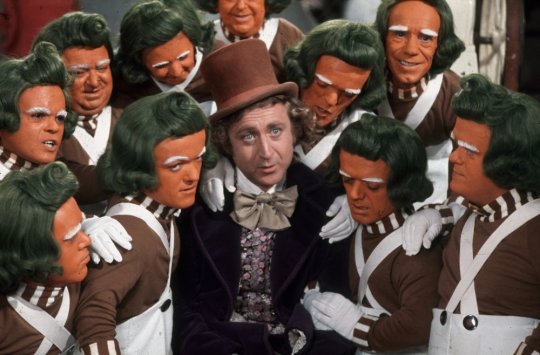
Image source: https://www2.bfi.org.uk/news-opinion/news-bfi/features/search-perfect-willy-wonka
Dahl’s screenplay - bloated and too close an adaption of the book, was eventually revised by newbie screenwriter David Seltzer, but the fantastical elements of the author’s story remained largely intact: chocolate rooms with chocolate waterfalls and rivers, fizzy-lifting stations that send Charlie Bucket and his grandfather floating to the ceiling, and elevators that fly straight into the sky. Harper Goff, famed for his work on the 1945 Disney film ‘20,000 Leagues under the Sea’, was tasked with bringing Dahl’s demanding vision to life in the art department. Then there were difficulties in casting too, and a cross-country search took place for the Oompa Loompas and the lucky ticket-winning children (lamentably, only white actors were cast). With scouting and sketching underway, producers had the formidable challenge of finding somewhere to shoot the movie. After considering the Guinness Factory in Ireland and – wait for it - a national monument in Spain, producers settled on the Munich Gas works and Bavarian Film Studios in Germany as the central filming locations. It was cheaper than America and the location’s foreignness to British and American audiences would work in the favour of creating a ‘Neverland’ story.
Tinged with sweetness and sourness, pre-production on Wonka came to a close in late August 1970 and principal photography began. For the adults on set, budgetary problems were an ongoing source of stress and the unusual marriage between Hollywood and the food industry was one of the main causes. Unlike Paramount or Universal, who might have expected the film to go over budget, Quaker Oats viewed the film as one long advertisement for their new bar and were unsurprisingly less sympathetic when the weather was bad and shooting had to be delayed or when something went wrong on set and more money had to be poured in (or, in the case of the chocolate waterfall, a specially sourced anti-foaming solution). The kids also had their tribulations (and were only renumerated £60 per week for their hard labour). Stuart was a tough director. So tough, in fact, that the child actors used to joke that they deserved Oscars for their roles (or for putting up with Stuart). He treated the young actors as adults and perhaps that’s one reason why the performances are so strong. But Stuart reflected that overall, it was like ‘one big slumber party’ for the child actors. Stories from the set include Paris Themmen, who played Mike Teevee, releasing bees from underneath a bell jar in Wonka’s chewing gum machine. Denise Nickerson (playing Violet Beauregarde) and Julie Dawn Cole (Veruca Salt) fought over Peter Ostroff, who played Charlie Bucket, and took turns being his ‘girlfriend’ day-by-day. After lunch breaks, Ostroff and Gene Wilder, who played Wonka himself, would walk back to set together sharing a chocolate bar. There was an excitable atmosphere on set and, filmed without storyboards or pre-production rehearsals, it translated into authenticity in the final film.
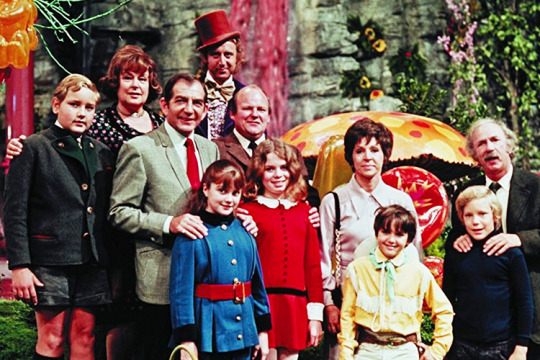
Image source: https://www.thedelite.com/willy-wonka-and-chocolate-factory-movie-facts-you-never-knew/
Filming came to a bittersweet end in November 1970, cast members said their teary goodbyes, and then seven months later, Willy Wonka premiered in the United States. While time has judged differently, the contemporary reception to the film was, at best, lukewarm. From a $2.9 million dollar budget, the film only made $4 million in theatres and ranked as #53 in the box office. There were a number of reasons for this. Several reviewers panned the movie; a critic from the New York Times called it ‘tedious and stagy with little sparkle and precious little humor’. The fun and spectacle of Willy Wonka didn’t sit well with an anxious and cynical audience. In the Vietnam era, The French Connection, The Omega Man, and A Clockwork Orange were in, and optimism and fun were out. The film also had to contend with the declining weekly movie attendance across the U.S, which reached an all-time low of 14 million in 1971 (from 44 million in 1963). On top of this, Dahl didn’t exactly enthuse about the final product. Finally - and this is what the director attributed primary responsibility to: a lacklustre marketing effort on behalf of Paramount Pictures.
But box-office results aren’t everything. Like sherbet - sour at first and then Oh so sweet, Willy Wonka has gone on to gain a mass following of fans and gained the all-desirable ‘cult’ film status. The phenomenon happened over time. Six years after the film appeared on cinema screens, it was sold to Warner Brothers and became one of their best-selling video cassettes. Then, periodic screenings on cable and network television over the following decades meant that it gained an even wider following and stayed within Western cultural consciousness. The never-ending references to Willy Wonka in popular culture - from The Simpsons to Austin Powers to Marilyn Manson’s music videos, is testament to this. The same could be said about the upcoming Willy Wonka origins story, whether it turns out to be a good film or not. Willy Wonka and the Chocolate Factory currently stands as the second most watched film of 1971 on Letterboxd (the Goodreads of film).
Re-watching the film in 2021, it seems almost inevitable that the film has found new and wide- ranging audiences and there’s one main reason for it: a stellar and totally captivating performance from Gene Wilder. The director attributed the film’s longevity to the fact that ‘it was made for adults; it was not made for children’ and it was Wilder himself that brought the grown-up fun. Wilder’s Wonka is sarcastic and witty, ensuring that the final film ended up as a ‘story for children’ only as much as After Eights are for post-dinner treats and Yorkie bars are just for boys. Wilder created a more nuanced and entrancing character out of Wonka than what is portrayed in the book - a Wonka who is dishonest but trustworthy, sarcastic but still empathetic, indifferent but deeply caring, and aloof but charming. Sure, the sets seem slightly dated (the chocolate room in particular) but watching Gene Wilder sing ‘Pure Imagination’ is so wholly captivating that one almost doesn’t notice the set’s limitations. Creating, let alone portraying, such an enigmatic version of Wonka is a tall order, but Wilder made it looks effortless. As evidence of his skill as an actor, Willy Wonka shows Charlie little interest until the very end of the film and then within minutes conveys a parental love to the boy that seems entirely believable. Wilder’s tantalising hot then cold, sugary then sour, sweet then salty performance sustains the whole film.
From the outset, it seemed like the Wilder-Wonka synergy was made to be. Wilder was a relative newcomer to Hollywood in 1970, making his feature film debut in the 1967 film Bonnie & Clyde, but when he walked into the casting room at the Plaza Hotel in New York, Mel Stuart knew he was the man straight away – ‘That’s Willy Wonka!’ he said. Wilder himself immediately seemed to have an intuitive understanding of how to bring the character to life, agreeing to take on the role on one condition: he said to Stuart, “I would like to come out [of the factory] with a cane and be crippled because no one will know from that time on whether I’m lying or telling the truth.’’ Like a magician, Wilder’s Wonka was going to draw you in and keep you in the palm of his hand. To the child actors on set, the Wilder-Wonka symbiosis was very much real. Julia Winter recalled that between takes the kids would crawl all over Wilder yelling, ‘It’s my turn to sit on his lap!’. In turn, Wilder would tell them jokes and stories; he ‘never got cross’. I remember feeling the same captivation as a child watching the film: I wanted to spend time with Wonka. It was only some adults who missed the magic trick. Dahl criticised Wilder’s performance as ‘pretentious’ and insufficiently ‘gay’. Wilder himself recalled hearing talk of mothers saying that the film was ‘cruel to the children’, but he understood that ‘maybe some mothers felt that way, but the children didn’t feel that way...there are limits and they want to know the limits’. The continuing classic status of the film is evidence that the kids (and Wilder) were right. The Wilder-Wonka magic has survived 50 years without souring. The only bittersweetness in watching the actor sing and twirl across the screen is knowing he is no longer with us.

Image source: https://cometoverhollywood.com/2016/08/29/musical-monday-willy-wonka-the-chocolate-factory-1971/
If Gene Wilder carried the film, then what about the story itself? The plot is simple, heart- warming, and doesn’t deserve close scrutiny. Willy Wonka really is a ‘show’, the story is secondary to the individual charisma of Wilder and the spectacle of the image and music. We don’t know if Charlie will be happy or sad once he’s inherited Wonka’s factory. We also don’t know what happens to the rest of the children after they’ve been punished. But who cares? The audience is taken to a joyful fun park where you want to eat everything on screen and play with all the gizmos and gadgets, and where the music is so catchy that you can’t get it out of your head for days and weeks after.
Select ideologues have (and will) taken issue with the story, discarding it as gauche capitalist propaganda. One Marxist criticism of the story even gained enough traction that the director took notice in later years. The parts seem to be there: a businessman running a competition by hiding five golden tickets in his candy bars, competition from other candy makers, the Wonka-Oompa Loompa relationship, and a ‘Rags to riches’ story for Charlie. But one might ask if this is an unnecessary and selective reading. The parts for an alternative vision are equally apparent: from the wild and uncontrolled creativity and experimentation inside the factory to the joy found within the chocolate work itself, and from the relentless drive forward ‘You have to go forward if you want to go back’ to the end picture of the elevator shooting through a glass ceiling and into the skies. If a critic really wanted to make the comparison, such images would sit more easily in Soviet Russia than capitalist America. Wonka might have a capitalist wrapper but take a bite and look closely inside and its ideological filling is incoherent (it is, after all, entertainment). One could imagine how the film might be set in a collectivist community rather than a ‘capitalist’ factory, but it would have made for a worse film. It is the sense of unease that runs throughout the film that has made it timeless, whether its Wonka’s frustration with August Gloop for polluting his pure chocolate river, his fear over someone leaking the secret recipe for the ever-lasting gobstopper, his nightmares in the tunnel sequence, or his anxiety over finding a worthy heir for the factory, which finally manifests as a misjudged outburst at Charlie. It’s the fraught relationship between abundance and greed that makes for such compelling watching. Anyway, as the screenwriter stated in an interview, the film is ‘...not the function of sitting down and intellectualising... it’s the function of scotch tape, cardboard, let’s put on a show!’ Why spoil the fun and examine the parts individually when the sum of the parts is a universal message people need to hear now as much as they did in 1971? Reward honesty and integrity, not greed.
A moral message delivered in an almost subversive tone is another reason for why the film feels timeless. Instead of adults dragging tired and bored children around, the adults in this film are at the mercy of their kids and Wonka. Young viewers can marvel at the gluttony of August Gloop, the smart-mouthed Violet Beauregarde, the wanton bad behaviour of Veruca Salt, and Mike Teevee’s devotion to cable. It’s escapism at its best to watch other kids do what you can’t do: speak back to parents and yell and scream. It’s equally as tantalising when the naughty children are punished in fantastical ways. Augustus, drinking from the chocolate river, falls in and then gets sucked up a chocolate chute. Violet chews forbidden gum and then blows up into a blueberry the size of a small horse. Veruca falls down a garbage chute. And Mike finds himself sucked into a television. Best of all, the parents are equally guilty of bad-behaviour as the kids - and, boy, do they pay for it. Wonka might be a film for children and adults, but you can guess who’s going to really have the best time. It is little Charlie, after all, who wins Wonka’s factory at the end of the day.
In the scene where Willy Wonka drinks from a yellow flower-shaped cup and then eats the cup, the cup itself was made of wax. Gene Wilder had to chew the wax pieces until the end of the take, at which point he spat them out. Adults that once watched the film as children now know that flowers in the garden aren’t edible. Our eyes can pick up the small imperfections in the film - the sweets that look plastic and chocolate river that looks like exactly what it was - ‘dirty, stinky water’. But through a child’s eyes - even coming to the film half a century after its release, the film really can be a ‘world of pure imagination’. In another fifty years, will children still wander into the garden, pick up a buttercup, and bite into it with all the belief in the word that it’ll taste like sweet, white chocolate? As long as parents continue to show children the film, they will - and what a marvellous legacy for a film to have. Fifty years on, it’s safe to say that Willy Wonka has had a sweet and indelible impact on our sadly mostly inedible world.
Sources for post:
Mel Stuart, Josh Young, ‘Pure Imagination: The Making of Willy Wonka and the Chocolate Factory’, 2001.
Julia Dawn Cole, ‘I Want It Now! a Memoir of Life on the Set of Willy Wonka and the Chocolate Factory’, 2011.
Pure Imagination: The Story (Making) of Willy Wonka & The Chocolate Factory: https://www.youtube.com/watch?v=0yyev_3S_Y4
----
© Fifty Year Films, 2021. Unauthorized use and/or duplication of material from this blog without express and written permission from this site’s author is prohibited. Excerpts and links may be used, provided that full and clear credit is given to Fifty Year Films with appropriate and specific direction to the original content.
22 notes
·
View notes
Text
Toku Tuesday 24: All Hallows’ Eve Eve Eve Eve Eve Eve
It’s almost Halloween! Damn I can’t believe it’s been an entire year of running movie nights since the last Halloween (Animation Night 25)... without missing a week yet. Which may be the first mention of ero-guro on this blog? Couldn’t have guessed where that one would go...
Toku Tuesday, or whatever this year round international film festival is called nowadays, is now almost as old as Animation Night was then. (This suggests I’ll decide to run a third movie night for the third type of film apart from live action and animation at some point next year. What is that type of film? Great question I don’t know... but I know it’s out there somewhere... lurking...)
For now, this means it’s time to once again wander back to the feet of horror (if we ever left them!). Of course, the thing is, when it comes to genuinely unsettling, permanent-residence-in-your-brain horror movies, while we might have had fairly slim pickings in animation, we are very much spoiled for choice in live action! But, being a naive fool uncomprehending of the powers I have invoked, I must turn to wise (and sexy) veterans of the forbidden realm like @mogsk and @lyravelocity to help show me around in the dark...

Since this all began as a tokusatsu night, we must certainly begin with some J-horror. Which means, well, if we’re going to begin with the big international sensation, we’ll be watching Ring (リング Ringu, 1998), not to be confused with the 2002 American remake or indeed the 1999 Korean remake. The premise of Ring is something akin to the Langford basilisk but with a supernatural rather than ‘scientific’ spin: a videotape cursed with the ghost of a deceased psychic which kills its viewer seven days after watching. But if you can copy the video and send it to someone else, you can save yourself from the curse in a kind of supernatural blackmail pyramid scheme. Of course, that is a great setup for then showing us the contents of the evil video!
For whatever reason, this whole package - and particularly the image of the film’s antagonist Sadako Yamamura with her long hair hanging over her face - became wildly popular in the West, sparking an interest in J-horror in general, to the point that the American remake can even overshadow its origin. Both JP and Western versions went ahead to spawn whole horror franchises, with the usual ecosystem of dubious sequels, questionable crossovers, and general watering down until no more money can be wrung from this particular scary image. But we don’t truck with Hollywood in these parts (except when we do), so we’re sticking with the original!

So, J-horror! If you go and research this subject in the most lazy way possible (I have so little time...) you will end up on this Wiki article, which traces major influences on the genre back to Kabuki and Noh theatre:
The subject matter often portrayed in original Noh theater include vengeful spirits, demon plays, stories of death, and others.[4] Many of the storylines of these traditional plays have inspired modern horror depictions, and these stories have been used as source material for Japanese horror films.[4] In fact, Kabuki was a major subject of early Japanese films, and Kabuki gradually was woven into the framework of the modern horror films seen today.[4] For example, the physical description of the ghost character Sadako Yamamura in Koji Suzuki's Ring series of novels is derived from what was seen in Noh and Kabuki theater performances.[3]
To this we can surely add the kamishibai, which we discussed last year.
From there, you can follow it to read about the post-war Japanese horror cinema tradition, beginning with Onibaba (1964) and Kwaidan (1965), and learn that the more psychological J-horror became seen internationally as a welcome alternative to the slasher-film-dominated Western scene. By the time of Ring, the genre was well established and diverse. We’ve already seen some great examples like Shinya Tsukumoto’s Tetsuo (which I never managed to give a full writeup) and its delirious and rebellious body horror; since at least the 2000s there’s also sprung up whole tradition of nihilistic splatter-and-body-horror films carried by people like Noboru Iguchi (whose work we actually have only met on Animation Night with The Flowers of Evil, but in this case the example to name would probably be Machine Girl) and Yoshihiro Nishimura (best known for Tokyo Gore Police, a fascinating film I have gotta show you all sometime).

However, should you follow that link about Sadako, you get a long article of mostly dense plot summary, so I cannot say which specific Noh or Kabuki productions influenced Sadako’s design. Instead you can learn that she is, at least in the books, intersex, because nothing’s spookier than a girl with a penis to the minds of some people I guess. Sadako’s backstory involves a lot of fears about medical abuse of children, in common with well *gestures at a whoooole lot of anime from Elfen Lied through Serial Experiments Lain up to Made in Abyss*... at some point meanwhile the films’ version of the story instead has Sadako somehow split into a good and evil twin and the evil twin is tortured by drugs to ‘stunt her growth’ similar to the real world “Ashley treatment” infamously deployed in 2004. All painfully relevant fears, much more so than haunted videotapes; we’ll have to see how well the film handles them.
Of course at the same time, Ring has gone to some wild places (much like Godzilla lmao). Check out this description of one of the spinoff mangas...
In Sadako-san and Sadako-chan, set after the 2019 film Sadako, Sadako seeks to move on from their tragic past and spreading their curse via videotape by navigating the modern era of YouTube and social media with a young girl known as "Little Sadako", a reincarnation of herself. Little Sadako, a young child and fledging YouTuber who spends all day in a small closet on her mother's request, befriends Sadako after she arrives seven days after watching her tape and not being afraid of her, creating a joint YouTube channel with her dubbed "Twodako"
I’ve somehow missed out on all of this taking place so tonight will be my first exposure to any sort of cursed videotape, and I’m looking forward to seeing what the fuss is about. Not quite sure how running a movie night over Twitch factors into the cursed video logic...

Our second film tonight is South Korean zombie film Train to Busan (2016), directed Yeon Sang-ho, who is unusual among Korean directors for mostly working in animation (as we’ll see a little of on Thursday!). Still, his films are in the same idiom as other internationally well known Korean directors like Bong Joon-ho and Park Chan-wook: dark, psychologically realistic films about poverty, trauma and the nastiness that comes from living under decades of military dictatorship, hypercapitalist stratification etc. His first film, The King of Pigs (2011), told the story of a a man reunites with a childhood friend after murdering his wife, and they recall their miserable childhood of class-driven bullying. His second film, The Fake (2013), portrayed a cult leader priest exploiting the people of a town threatened by flooding. We’ll hopefully get around to watching those on an Animation Night before too long!
Tonight though our focus is on the series of zombie films that began in 2016 with the pair of Train to Busan and its animated prequel Seoul Station. Of course, a good zombie film has to have more than simply zombie tropes; interviewed about Seoul Station, Yeon describes the premise of the films as placing zombies among people protesting the democratisation of Korea to create ‘a fable disguised as a zombie film’. Busan landed to, by and large, a ton of acclaim and has the @lyravelocity “you’ll probably like this” seal of approval (<3), so I’m quite curious to see it. And it sets up a nice tie-in on Thursday with Seoul Station!

I’m really curious why Korean cinema ended up with such a distinctive and forceful character - it’s surely not the only country with such a painful history, was it just a few directors finding success at the right time? In any case, that’s a history to dig into another day... for now, if you are ready to start this week’s spooking, please head over to twitch.tv/canmom, where the terrifyingly cursed .mkvs will begin playing shortly... and if you have any ideas for short horror things we can tuck in at the end, please do say!
5 notes
·
View notes
Photo




A new interview of Noémie Merlant for Les Cinémas Aixois (recorded back in March 2020)
(I might translate Zoé’s part if needed when I can, but i can’t promise anything, it’s quite long...). Noémie’s interview starts at 23:15
Hello Noémie Merlant !
Hello !
Welcome to Aix en Provence, in the Cinémas Aixois. Recently you’ve been doing lot of love stories.
Yes passionated love stories, modern love stories. Modern in the sense that it’s about women who follow and listen to their desires.
How do you see Jeanne and her relationship with Jumbo. And how did you work on those emotions, to fall in love with Jumbo.
It’s not easy to develop a relationship with an object, something that isn’t alive. And the special effects weren’t there yet, so it wasn’t fully embodied. There’s a lot of things to say I’m trying to think where I should start. Well I was very scared of amusement rides and I didn’t say it to Zoé but I was terrorized to go on those rides that move everywhere and I’m scared of heights. So I developed a relationship with Jumbo and I asked him to make sure everything goes well. And I used that fear when I went on Jumbo and it’s like when we start a new love story, we’re a bit terrorized and I used those kind of emotions. And once I got on Jumbo and did that first ride, I really pretended to be Jeanne and to believe , like Jeanne, that I loved that. And this is how you also see the power of belief, the film talks about that too. So I let it go and it was like a full vertigo, orgasm of let go. And it feels really good to let go, it made me feel really good. And then I was still in dialogue with Jumbo thanking him for making me experience this and for protecting me.
And I think we all have those kind of dialogues with ourselves. To me Jumbo is also a mirror of Jeanne. She struggles to talk and to have a relationships with people, with her mother who’s very possessive, fusional, toxic, she also struggles to deal with men’s desire, with what they're looking at her for. She’s very introvert and with Jumbo she can be herself, she’s not scared of anything because it’s neutral, and so she’s more open, more alive, more herself and so I worked on very concret things: different postures, ways of talking, of looking. We also we feed off our own love stories, it’s the same journey. So I start from here because it’s a real love story with Jumbo so I tried to be the most sincere and real I could.
Was it easier to let your guard down as an actress sharing feeling with Jumbo. I’m thinking that maybe if you were in front of a woman or a man…
Oh yes it’s easier because it’s neutral and Jeanne is calmer with Jumbo because she faces herself. But when it comes to acting it’s more complicated because, there’s a journey to create that is more difficult because it’s not a journey that we’re used to take, especially as actors. To only lean on a dialogue with yourself and the atmosphere. And when I say atmosphere I mean the machine, this material, these smells, to find other things.
And did Jumbo change.. I mean as scenes progressed did you…
Was it changing ? Yes at the beginning it was my enemy and at the end it was my great friend because thanks to it I surpassed something. Because before I used to be scared of everything and with Jumbo I’m less scared of many things. So something really powerful happened and I had a real relationship with it regarding that.
Some actors can really separate their characters to themselves and when the scene is cut they go back to reality …
Me not really.
You stay in character ?
How to say this, it goes a bit beyond, it overflows.
And what did you keep from Jeanne ?
I already had a bit of Jeanne before and I think we all have a bit of Jeanne in ourselves. A side that I have, that I had more before, to sometimes before totally elsewhere, not being able to deal with people, their desires, what they were projecting on me, what they expect from me and I would shut myself off. So I could relate to some of the things. And the way she would be in her own world, and talk to herself and with that machine, that was something that moved me and that I could understand. And those things stayed in my but were already there before.
What I managed is to overcome rides, now I like it, which is something pretty huge.
What made you decide to do this if you were scared of it ?
Usually when I’m scared about something, I confront it and I do it. I know that the moment I’m stagnating, I’m staying stuck, I’m finished. Finished in the sense that we have to keep moving and to go forwards. If I was scared of this character as much as I loved her it’s because there was a thing. But I saw the importance of this film, of this role, what it would lead to, the reflexion, the emotions that it brings, which was essential for me. And it’s an unique film.
Were you scared to work with Emmanuelle Bercot ?
Well I met her at the audition and she was so cool that I wasn’t scared after; I was very excited.
There are a lotto tensions with Jeanne and her mother. Does the desire to work with an actor is an advantage even if it’s to play something conflictive ?
Oh yes, it’s definitely an advantage. You’re not scared to really go for it and to threw yourself into the role. Every actor is different so it’s important and interesting to know everyone’s limits and it’s really interesting when the actor in front of you have the same limits as you because it’s really fun.
What do you think about the relationship between Jeanne and Jumbo, is it fantasized, or is there some reality etc.
It’s a love story, it’s the love story of Jeanne and it’s beautiful.
Di you watch films to get some inspiration for that role ?
Ryan Gosling, with his doll [Lars and the Real Girl], we watched that. Also Dancer in Dark, Breaking the Waves. We also watched The Shape of Water after filming. It’s a bit different though because it’s a creature that is pretty masculine. And the documentary about Erika Eiffel, and one about another woman that is in love with a ride. That was interesting.
Did you meet Erika Eiffel?
No. Well I met her later, in Berlin, at the screening, which was very moving.
What topic mattered the most to you in the film ? It talks about a lot of different subjects. What is the strongest to you ?
There’s that journey to make her mother accept that she is different, different from what her mother was expecting her to be. Because she has a love story that is out of the norm, because she’s different. And I think it’s very important, especially int he world we live in today.
And also I’m also moved by something more indirect. The film is also about reconnecting with ourselves. When I see Jeanne listening to herself, to her desire, that are different, that are very personal, intimate. Those things made me reconnect with some things, with myself. She has a strong dialogue with herself and I think it’s very beautiful. And that’s why she manages to talk about it with her mother quite quickly and to try to make her understand through the emotions.
This journey is important ?
Yes, the cinema of emotion is important because there are things that are hard to understand and sometimes through emotions we can relate more easily and understand them.
Do we have to go through a phase of loneliness ?
I think so yes. A phase of loneliness and a phase of cinema too.
Is that kind of leading role a gift ?
It’s a beautiful role that Zoé wrote and yes it’s a gift when you start a career to have that kind of role.
Were you two close on set to give instructions or was there some freedom in the interpretation ?
Well it’s a mix of those two things. We worked a lot before filming, in rehearsal. We were searching together. We tried different things, sometimes Zoé had a precise idea, and I wanted to try something different, so there was a real dialogue. And sometimes it was Emmanuelle that tried something different too. There was really something between us three.
#noémie merlant#noemie merlant#jumbo#jumbo le film#les cinémas aixois#please let me know if there's any grammar or english mistakes#I couldn't re-read myself because I was kind of in a hurry#but will make the corrections when I can !#sometimes i translate things#portrait of a lady on fire
182 notes
·
View notes
Text
Favorite film discoveries of 2019
Every year, my new-to-me favorites list always shocks me in some way. This year, the sheer amount of movies made in the 2010s on display is INSANE by my standards. Of course, most of the modern movies here are throwbacks or tributes to older styles of cinema, so maybe it’s not that shocking in the long run.
Another running trend this year: movies that are old but not as dated as we would wish. Many of the older films here deal with xenophobia and political strife in ways that still feel shockingly prescient today-- the more things change...
ONCE UPON A TIME... IN HOLLYWOOD (DIR. QUENTIN TARANTINO, 2019)
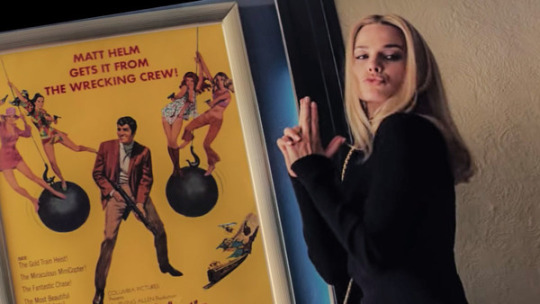
I never thought the day would come where my favorite movie of the year would actually be made after the 1970s, let alone by Quentin Tarantino. Then again, this movie is all about the end of Old Hollywood as well as a big love letter to the 1960s, so maybe it’s not that shocking a state of affairs. I adored this movie, the level of detail, the laidback yet elegaic vibe, the comedy and the relationships between all the characters. It was one of those movies where I loved even the scenes where nothing seems to be happening at all-- I mean, who knew Brad Pitt feeding his dog and watching TV could be entertaining?? But it is and I can't wait to see this one again!
INTENTIONS OF MURDER (DIR. SHOHEI IMAMURA, 1964)
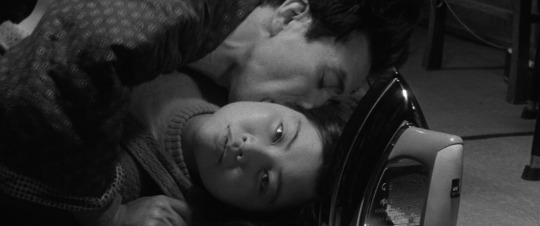
Intentions of Murder has an insane premise, one that runs the risk of being tasteless: a housewife in a miserable, exploitative marriage is raped by a sickly burglar during a home invasion. Even worse, she can’t shake him, as he’s suddenly infatuated and wants her to run away with him to the city. And weirder still: her current existence is so miserable that she’s TEMPTED. While abuse and rape are grim subjects for any story, Intentions is actually about a woman coming into her own and finally standing strong against all these men trying to use her. It’s a weird blend of drama and dark comedy, a truly savage satire on patriarchy and class-snobbery.
JOKER (DIR. TODD PHILLIPS, 2019)
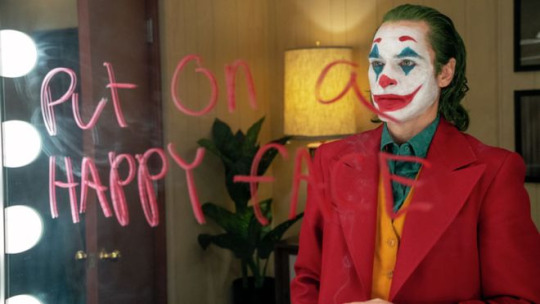
I went into this movie expecting to think it was overhyped and when I first left the theater, I was all ready to say “it’s good but not THAT good.” But it ended up haunting me for weeks afterward, and I found myself thinking about how everything just tied up so well together, from the grotty urban hellscape which serves as the setting to Phoenix’s brilliant performance. It reminded me a lot of A Clockwork Orange in how intimate it lets you get to this violent man while never pretending he is someone to be glamorized or imitated.
SIMON (DIR. MARSHALL BRICKMAN, 1980)
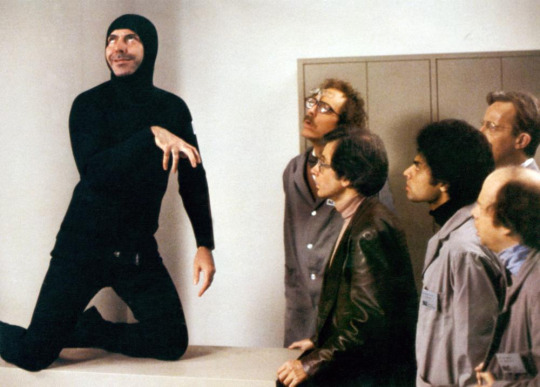
How do I even describe Simon? Alan Arkin is brainwashed by a group of overpaid intellectuals into believing he is descended from an alien toaster. Then he gets a messiah complex and starts gathering disciples as he rails against television, condiment packets, and muzak. It’s a little uneven at times, sure, but the satire is really inspired. The whole thing is like a combination of Mel Brooks, Stanley Kubrick, and Woody Allen’s styles, and it is quite hilarious for those who thrive on cult oddities.
PEEPING TOM (DIR. MICHAEL POWELL, 1960)
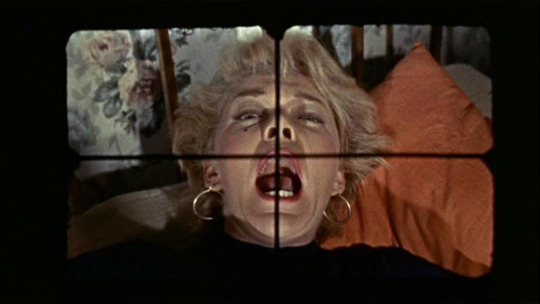
Though it came out the same year as Hitchcock’s Psycho and has been nearly as influential for horror cinema, Peeping Tom remains underseen by everyone save for film theorists. And what a shame that is, because this movie is more frightening than Psycho. Sure, that may be because Psycho is so predominant in popular culture and just so influential that it no longer has the same shock value, but there’s something about Peeping Tom that gets under my skin, something sad, even disgusting. I felt dirty after watching it-- and this is 2019!
MIDNIGHT MARY (DIR. WILLIAM WELLMAN, 1933)
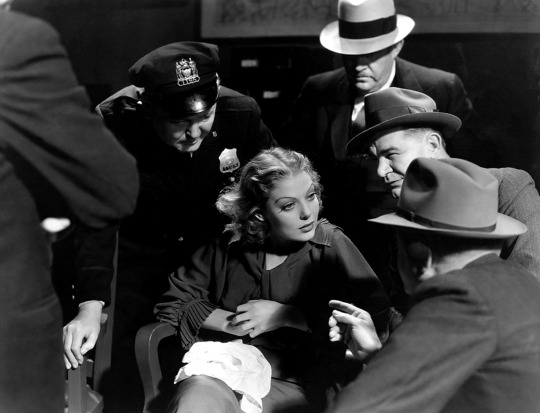
Loretta Young got one of her juiciest roles in this pre-code crime drama. Her Mary Martin is more than just a good girl forced into criminal circles-- she’s a complicated creature, compassionate and desperate and lonely and bitter and sensual all at once. This movie is a fast-paced, beautifully filmed ride, cloaked in that Depression-era cynicism that makes pre-code Hollywood of such interest to movie geeks the world over.
WILD BOYS OF THE ROAD (DIR. WILLIAM WELLMAN, 1933)
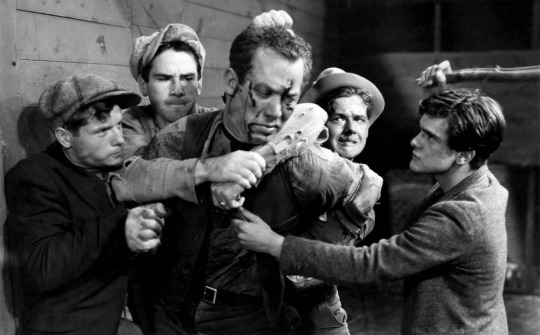
Wild Boys of the Road is a quintessential Depression-era movie, relentless in its bleakness and rage. That the main characters are all starving kids only looking for work makes their struggles all the harder to watch. William Wellman is quickly becoming one of my favorite directors: his gritty style and compact storytelling are just perfect for a ripped-from-the-headlines drama such as this. And the “happy” ending has one little moment that just knocks any smile you have right off your mug. Absolutely see this.
THE RUSSIANS ARE COMING, THE RUSSIANS ARE COMING (DIR. NORMAN JEWISON, 1966)
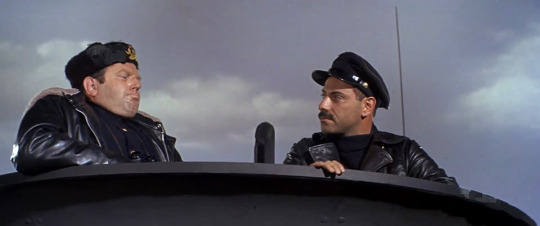
Sometimes, when you watch a movie only because a favorite actor is in it, you get subjected to pure trash like Free and Easy (oh, the things I do for Buster Keaton). Other times, you get cute gems like The Russians are Coming, The Russians are Coming, which, as you probably guessed, I mainly sought out for Alan Arkin. But the whole movie is hilarious, the best kind of farce comedy, populated by enjoyable characters and a sweet-tempered humanism that grounds the wackiness. While a little overlong, this movie is quite underrated-- and sadly, its satire of American xenophobia and Cold War panic is not as dated as we would like to believe.
ALL THE PRESIDENT’S MEN (DIR. ALAN J. PAKULA, 1976)
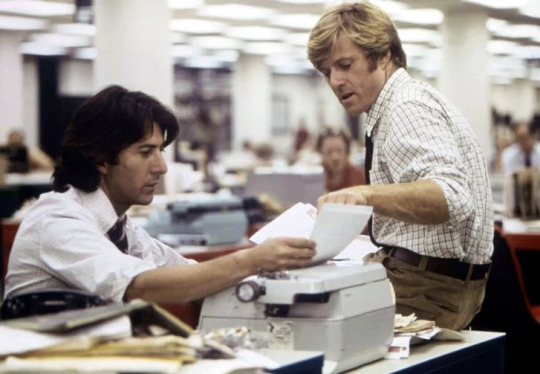
Who knew a political thriller where most people know the twist could be so intense and riveting? It’s about as nonsensical as feeling suspense when you watch a movie about the Titanic and hope the boat won’t sink-- but damn, it’s magical. All the President’s Men is real white-knuckle stuff, with Robert Redford and Dustin Hoffman projecting both youthful excitement and deep panic as they proceed with their investigation. It scarcely seems to have aged at all.
WHISPER OF THE HEART (DIR. YOSHIFUMI KONDOU, 1995)
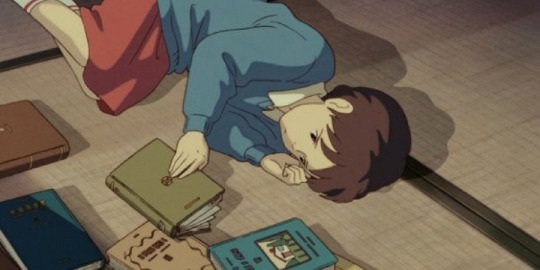
There’s a scene near the end of Whisper of the Heart where the protagonist Shizuku shows the finished first draft of her fantasy novel to her first reader, the grandpa of one of her schoolmates. She weeps because it isn’t the perfect image she had in her head, despite how hard she worked on it, but the old man tells her that it takes polishing and discipline to make the work come to its full potential. Few movies about artists are so honest about how hard it can be, how unsupportive others can be in their demand that everyone be “practical.” As a writer who struggles to create and constantly doubts herself, this movie spoke strongly to me. I recommend it to any creative person.
THE PHANTOM OF THE PARADISE (DIR. BRIAN DE PALMA, 1976)
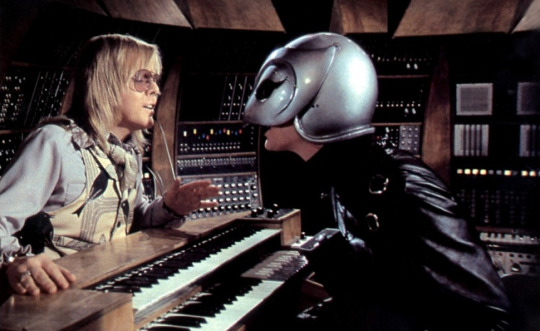
I’d been wanting to see this movie since my high school phan days. Holy crap, is it WEIRDER than I could have ever imagined, a true camp masterpiece. I’m shocked it was never tuned into a stage show actually, but then again, we would miss those trippy camera angles and we wouldn’t have Paul Williams as one of the greatest villains of all time.
DUEL (DIR. STEVEN SPIELBERG, 1971)
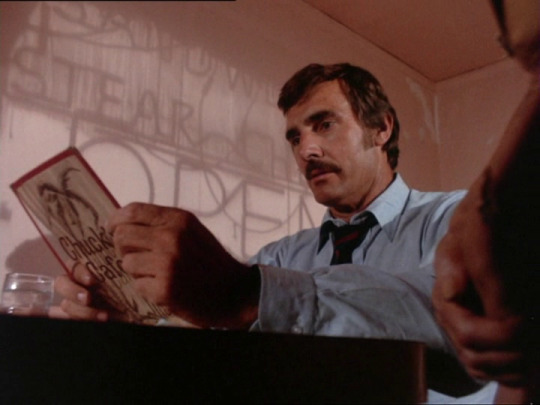
When people talk about the best movies made in the “Hitchcock without Hitchcock directing” tradition, why is Duel so seldom mentioned? The scene in the cafe, packed with paranoid tension and tense camerawork, alone should qualify it. Duel is most known as the movie which put the young Steven Spielberg on the map. It’s quite different from his later work, grittier and less whimsical for sure. Even the ending seems almost nihilistic, depending on how you view it. But damn, if it isn’t fine filmmaking.
CAROL (DIR. TODD HAYNES, 2015)
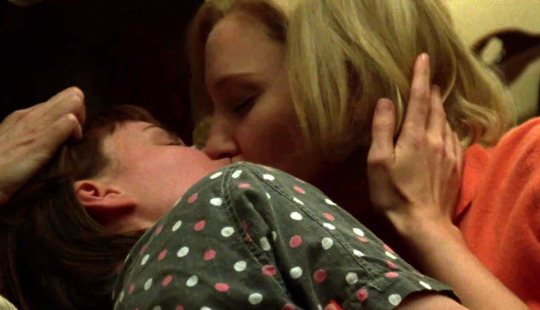
This gorgeous throwback to Douglas Sirk melodramas is also one of the best romantic movies I’ve seen in a while. Cate Blanchett and Rooney Mara have the sweetest, tenderest chemistry-- it was like seeing Lauren Bacall and Audrey Hepburn as love interests in a film. Unlike Sirk, there is little in the way of ripe melodrama here-- everything is underplayed, aching, mature. And I can say this is an adaptation that is better than the source book: it just feels so much warmer.
12 ANGRY MEN (DIR. SIDNEY LUMET, 1957
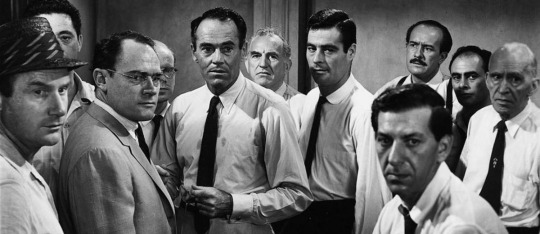
All I can say is that this was every bit equal to the hype. Common movie wisdom says people sitting and talking in a room is going to be boring on film, but movies like 12 Angry Men prove this is not so when you’ve got an excellently tense atmosphere, an inspired script, and a stable of fine actors to work with. Like The Russians are Coming, the Russians are Coming, this movie has not significantly aged-- much to society’s discredit.
A STAR IS BORN (DIR. GEORGE CUKOR, 1954)
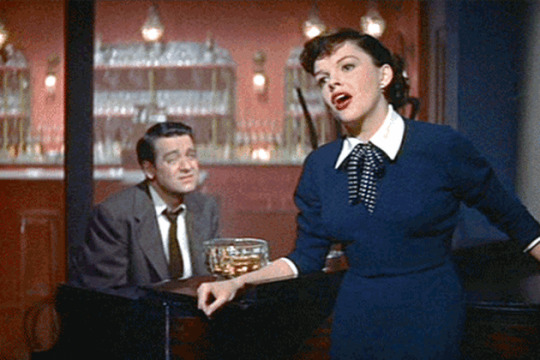
Another movie I went into not expecting to love as much as I did. When movies from the 20s or 30s tended to get remakes in the 1950s, I always find them too garish and big, victims of glossy Cinemascope and overlong runtimes. Compared to the lean 1937 classic original, I expected sheer indulgence from this three-hour remake. Instead, I got my heart torn out all over again-- the longer runtime is used well, fleshing out the characters to a greater degree. Judy Garland and James Mason both give what might be the best efforts of their respective careers, and the satire of the celebrity machine remains as relevant and scathing as ever.
BLANCANIEVES (DIR. PABLO BERGER, 2012)
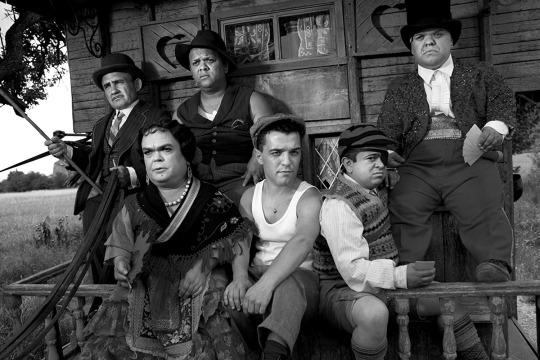
Oh, it feels like this movie was made for me specifically. It’s shot in gorgeous, expressionistic black-and-white. It’s set in the 1920s. It’s a clever adaptation of a classic fairy tale. It’s as funny and charming as it is bittersweet and macabre. Instead of more superhero movies, can we get more neo-silent movies like this? PLEASE?
THE FAVOURITE (DIR. YORGOS LANTHIMOS, 2018)
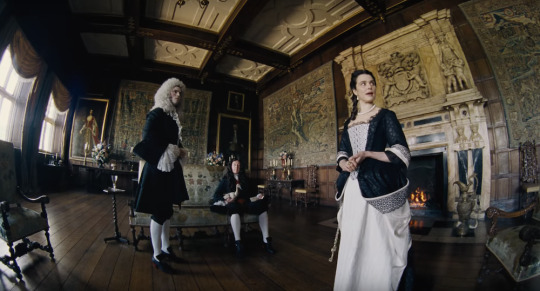
I’ve heard The Favourite described as a “bitchy lesbian Shakespeare play,” but this description, while a little true in terms of general tone, does not get to the heart of what makes this film brilliant. More than love or sex, this movie is about power-- particularly the corrupting influence of power. And it corrupts not only morals but love itself. Innocents become Machiavellian schemers. Lovers become sadomasochistic enemies. Good intentions turn to poison. This certainly isn’t a happy movie, but it is moving and, strangely enough, also hilarious. I was reminded of the chilly, satirical world of Kubrick’s Barry Lyndon more than once-- and for me, that is not a bad movie to be reminded of.
ON THE WATERFRONT (DIR. ELIA KAZAN, 1954)
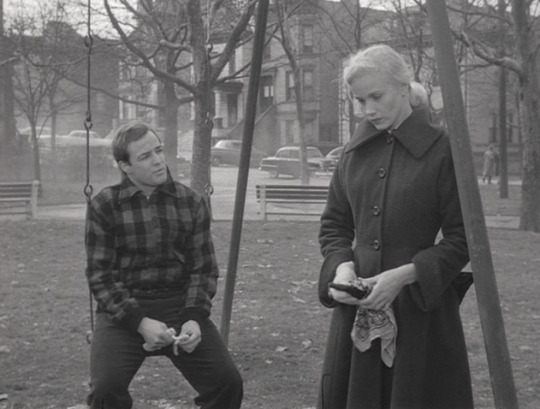
Another classic that’s been on my list forever that I was delighted to find worthy of its reputation. It’s a classic tale of redemption and social justice, perfectly acted and shot. While I still prefer A Streetcar Named Desire as far as Kazan is concerned, this might be a better movie in the objective sense. Actually, more than even Brando, Karl Malden is the acting highlight for me-- he plays a priest torn between staying silent or truly speaking for the Gospel by demanding justice for the poor parish he serves. Just brilliant work.
KLUTE (DIR. ALAN J. PAKULA, 1971)

A perfect thriller, just about, and a great example of the “NYC is hell on earth” subgenre of the 1960s and 1970s. Jane Fonda is a revelation: she feels so real, not at all like a starlet trying to seem normal if you know what I mean.
KISS KISS BANG BANG (DIR. SHANE BLACK, 2005)

As far as subversive noir goes, this is the most entertaining. I would put it up there with The Big Lebowski as far as goofy takes on Raymond Chandler are concerned-- I don’t even really know what to make of it, but I laughed my ass off anytime I wasn’t going “WHAT???”
What were your favorite film discoveries in 2019?
#thoughts#peeping tom#simon 1980#kiss kiss bang bang#intentions of murder#once upon a time in hollywood#joker#a star is born#blancanieves#the russians are coming the russians are coming#all the president's men#whisper of the heart#carol#the favourite#12 angry men#klute#the phantom of the paradise#on the waterfront#wild boys of the road#midnight mary#duel
151 notes
·
View notes
Photo
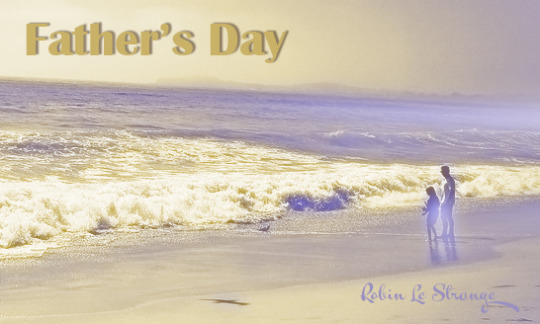

I mentioned at the outset of ‘Father’s Day’ that it had come about for quite specific reasons which I’d ‘talk’ about at the end, so forgive me a somewhat self-indulgent ramble by way of explanation.
At the end of May I ventured into my local supermarket for the first time since lockdown and was immediately confronted by row upon row of Father’s Day cards and gifts. I say ‘confronted’ because back at the beginning of April, we were advised that my Dad was in the final stages of his life. GPs suspected some kind of gastrointestinal cancer, but he was too frail for the kind of investigations that would confirm a diagnosis, so all they could provide us with was an educated guess and an estimate that he may have about three months left.
So when I chose his card from that display, and one for my daughter to give to her ‘Papa’ (miraculously there was one with that on – no mean feat here in the UK), I had no idea whether he would still be with us to open them.
And that got me thinking about all the people who don’t have their fathers anymore or perhaps never had them, which led me to Strike. Now that might seem a bit of a weird leap but one of the things that informs my writing of Strike, particularly my more recent work about his background, are his similarities with my own Dad.
Like Strike, my Dad grew up without a father (his died when he was 2.5 years old). He was evacuated to a commune in Yorkshire, not a million miles from Masham, with his younger brother and pregnant mum, and spent the rest of his childhood moving about frequently although in his case it was between children’s homes.
Like Strike he had a much-loved uncle, and also a range of half siblings, although they came along when he was in his teens. I’ve always thought that, even though he never had a consistent father figure in his life, the arrival of his younger sister who he helped care for, must have shaped his parenting abilities for when I came along, and of course this feeds into the way I write Strike and Lucy’s relationship.
Despite having no father figure, my dad was the most awesome one I could have wished for. He was not a traditional dad – more into cooking and art than DIY, cars and footy. We spent most of our time together on nature walks, at the cinema and traipsing round parks, museums and galleries on visits to London. He hung around with my uncle outside Wembley Stadium when I went to my first big gig at 15 and waited up after his night shifts to drive me to the station to catch the train to college. Although he left school at 14, he was endlessly interested in literature, art, travel and other cultures. He introduced me to curry, olives, whisky, Ella Fitzgerald and Thomas Hardy.
Today has rolled around and my dad is still with us, physically at least. It wasn’t the day I’d hoped for, he had a fall first thing which knocked him for six and was too tired for the lunch and a film we’d planned. The doctors are now saying they don’t really know what’s going on or how long he has. I’ve been helping care for him for the last few months as I’ve been working from home, but I’m required back in the office from tomorrow so my time with him will be limited for the next few weeks which is hard to come to terms with.
Anyway, that is what inspired the ‘Father’s Day’ series – my own Dad. I hope whoever you are and whatever situation you are in this Father’s Day, you are at peace with it, and thank you for reading. RLS x
23 notes
·
View notes
Text
The Director’s Series: Paul Thomas Anderson
The director series will consist of me concentrating on the filmography of all my favorite directors. I will rank each of their films according to my personal taste. I hope this project will provide everyone with quality recommendations and insight into films that they might not have known about. Today’s director in spotlight is Paul Thomas Anderson
#8 - Hard Eight (1998) Runtime: 1 hr 42 min Aspect Ratio: 2.39 : 1 Film Format: 35mm

John has lost all his money. He sits outside a diner in the desert when Sydney happens along, buys him coffee, then takes him to Reno and shows him how to get a free room without losing much money. Under Sydney's fatherly tutelage, John becomes a successful small-time professional gambler, and all is well, until he falls for Clementine, a cocktail waitress and sometimes hooker.
Verdict: One of the most impressive feature film debuts ever blessed to American cinema. Paul Thomas Anderson was only 25 years old when he broke into the scene and directed this (almost three years younger than me now, how depressing). While it is consistently thrilling and entertaining, Hard Eight oftentimes wears its influences on its sleeve too much. You can see how much inspiration Paul got from Tarantino with this film and it’s one of the 90s best independent movies. The star studded cast doesn’t hurt either.
#7 - Phantom Thread (2017) Runtime: 2 hr 10 min Aspect Ratio: 1.85 : 1 Film Format: 35mm

Renowned British dressmaker Reynolds Woodcock comes across Alma, a young, strong-willed woman, who soon becomes a fixture in his life as his muse and lover. Verdict: It’s safe to say that Phantom Thread is PTA’s most lavish and decadent film. It feels like a piece of ancient Hollywood golden-era cinema brought back to life. Johnny Greenwood’s orchestral score is the best sound work he’s ever done, it sweeps you off your feet when it goes along with Anderson’s signature arresting imagery. I’m in the minority who places this near the bottom of Anderson’s filmography, simply because Daniel Day Lewis’s character is so insufferable that it was hard for me to empathize in many ways. It still manages to be one of the most beautiful pieces of modern cinema.
#6 - Inherent Vice (2014) Runtime: 2 hr 28 min Aspect Ratio: 1.85 : 1 Film Format: 35mm
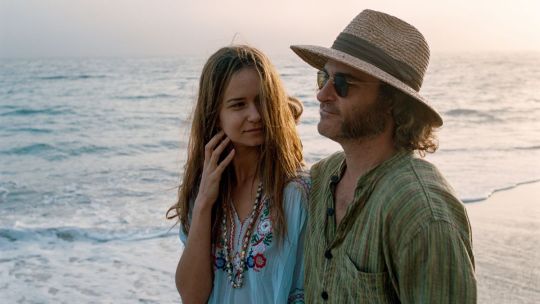
In Los Angeles at the turn of the 1970s, drug-fueled detective Larry “Doc” Sportello investigates the disappearance of an ex-girlfriend.
Verdict: Inherent Vice is Paul Thomas Anderson’s most underrated gem. I’ll admit, when I first saw this film, I didn’t really dig it that much and immediately cast it aside as his weakest effort. However, after some maturity, a few more viewings, and also not 100% adoring Phantom Thread, I have developed an immense appreciation for this nonsensical Thomas Pynchon adaptation. Pynchon as a writer is known as being basically unadaptable, but PTA revels in the absurdity of the film’s labyrinth of a plot. It also brings PTA back to his former glory days of ensemble casts and stoner drug fueled mayhem.
#5 - Punch-Drunk Love (2002) Runtime: 1 hr 35 min Aspect Ratio: 2.39 : 1 Film Format: 35mm
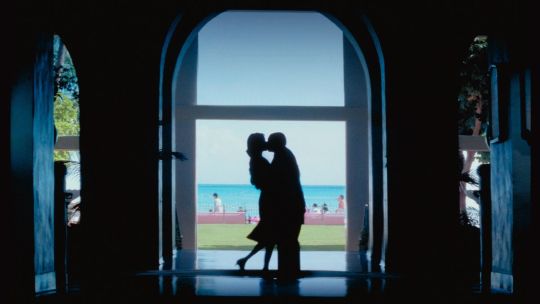
A psychologically troubled novelty supplier is nudged towards a romance with an English woman, all the while being extorted by a phone-sex line run by a crooked mattress salesman, and purchasing stunning amounts of pudding.
Verdict: Punch-Drunk Love plays out like a symphony of color, texture, and absolutely off-putting social interactions. I understand that Adam Sandler had his comeback last year with Uncut Gems, but this film is actually without a doubt the best performance he’s ever pulled off. And I credit that largely in part to the brilliance of Paul who was working behind him. It’s what I would say one of the most unconventional romantic comedies of all time. It’s nerve wracking, a little sad, super awkward - but also somehow manages to be endearing as well. The percussion heavy score brings manic energy to the whole film. Punch-Drunk Love is also a powerful statement on loneliness, unchecked mental illness, and the power of human connection.
#4 - Boogie Nights (1997) Runtime: 2 hr 35 min Aspect Ratio: 2.39 : 1 & 1.66 : 1 Film Format: 35mm
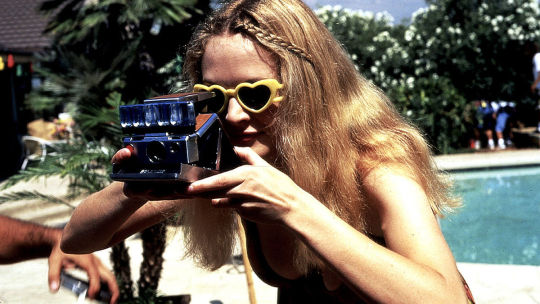
Adult film director Jack Horner is always on the lookout for new talent and it's only by chance that he meets Eddie Adams who is working as a busboy in a restaurant. Eddie is young, good looking and plenty of libido to spare. Using the screen name Dirk Diggler, he quickly rises to the top of his industry winning awards year after year. Drugs and ego however come between Dirk and those around him and he soon finds that fame is fleeting.
Verdict: How this film possibly came from a director who is my age now is almost hard to believe. Boogie Nights is one of the quintessential 90s films. It has one of PTA’s best ensemble casts. Anderson’s sophomore effort was a result of the auteur finding his footing and his directorial voice that went on to enthrall audiences over several decades. PTA’s early visual motifs were lengthy and expertly choreographed tracking shots. Please refer to the scenes in the disco as well as the pool party scene pictured above for some of the best camera operation every committed to celluloid. Boogie Nights could possibly be hailed as PTA’s most consistently entertaining and audience friendly works. It’s a great story of the rise and fall of stardom.
#3 - There Will Be Blood (2007) Runtime: 2 hr 38 min Aspect Ratio: 2.39 : 1 Film Format: 35mm
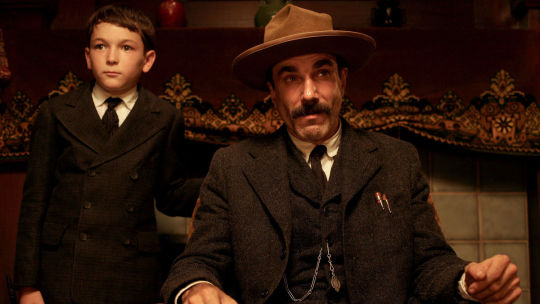
A story of family, religion, hatred, oil and madness, focusing on a turn-of-the-century prospector in the early days of the business.
Verdict: Most critics and audiences would agree that There Will Be Blood is the director’s most impressive masterpiece (but who’s counting?). On a storytelling and technical level, I do have to agree that this is probably Paul Thomas Anderson’s best achievement, even if it isn’t exactly my personal favorite. This is the film where PTA really matured with his directorial vision. He abandoned a lot of his earlier flashy work with large casts and a constantly moving camera for something more grounded and more of a character study. There Will be Blood is the story of America in many ways. It’s the story of Capitalism. And how this system leads to so much bloodshed, greed, and hatred as man and man compete to have the most and be the best. This movie will surely stand the test of time and is a shining example of how groundbreaking modern American cinema can be.
#2 - Magnolia (1999) Runtime: 3 hr 8 min Aspect Ratio: 2.39 : 1 Film Format: 35mm
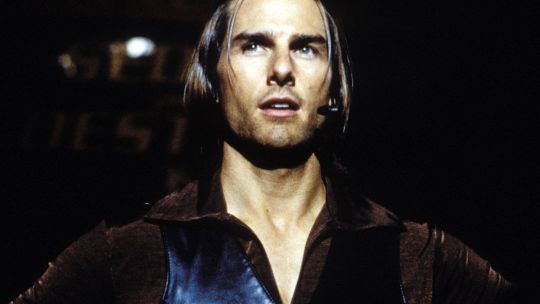
An epic mosaic of interrelated characters in search of love, forgiveness, and meaning in the San Fernando Valley.
Verdict: Paul Thomas Anderson’s third film found the director taking everything he had learned on his previous two, and expanding on that knowledge and developing more layers to his characters who have never felt so fully realized. Magnolia is the director’s magnum opus. It is epic in its length - clocking in at a little over three hours, making it his longest film by far. It is ambitious in its storytelling approach. Many films utilize the style of a variety of seemingly unrelated characters who connect to each other, oftentimes in a synchronistic fashion as they go about the trials and tribulations of their lives. However Magnolia is one of the few that did it first, did it the best, and set the bar for all of the subpar imitations that would soon follow. It’s also profoundly beautiful in the statements that PTA was trying to make. Paul, just barely 30 years old at the time when this was released, most definitely had an emotional and intellectual maturity that is rarely seen within a director of that age range. Magnolia is about redemption, loss, forgiveness, love, and trying to keep your head above water as frogs rain down on your head.
#1 - The Master (2012) Runtime: 2 hr 18 min Aspect Ratio: 1.85 : 1 Film Format: 35mm & 70mm
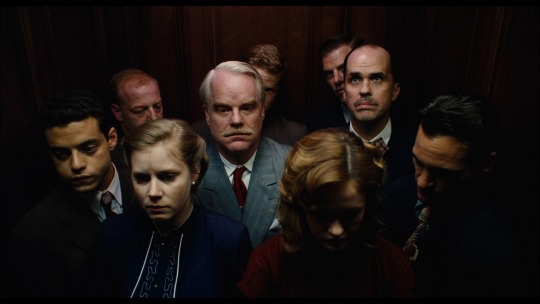
Freddie, a volatile, heavy-drinking veteran who suffers from post-traumatic stress disorder, finds some semblance of a family when he stumbles onto the ship of Lancaster Dodd, the charismatic leader of a new “religion” he forms after World War II.
Verdict: I’ve always been drawn to films about cults. Something about social behavior and social roles within a cult organization is a really interesting study on a sociological, psychological and anthropological level. The Master takes the cult formula and turns it on its head in many ways, never once foraying into the territory of exploitation or tropes. It instead takes a wholly original approach to the story. I mean, it is Paul Thomas Anderson that we’re talking about here. Joaquin Phoenix delivers his most unhinged, and certainly his most impressive, performance of his career as a mentally damaged alcoholic war veteran with pretty severe PTSD. The Master is also in many ways the story of the founding father of Scientology - L. Ron Hubbard. However, let’s just say it is a Scientology movie “in disguise” as no real historical names are ever spoke, the word “Scientology” is never uttered once, and even the director himself refuses to admit that’s what it is about (I mean who can blame him? He once had to work with Tom Cruise). It is one of the most fascinating character studies I’ve ever seen. Not to mention, it is PTA’s most beautifully shot film in my opinion and Johnny Greenwood’s musical contributions to the score elevate this film to ultimate masterpiece status. By the end, I felt like I had just undergone a transcendent experience of sorts. I hope one day PTA can make a film that “wows” me ever more than this one does.
#the director's series#director's series#the directors series#directors series#favorite directors#cinema#film#paul thomas anderson#maya rudolph#hard eight#gwyneth paltrow#samuel l jackson#john c reilly#phantom thread#daniel day lewis#vicky krieps#reynolds woodcock#cyril woodcock#anima#johnny greenwood#inherent vice#joaquin phoenix#katherine waterson#josh brolin#doc sportello#thomas pynchon#punch-drunk love#adam sandler#punch drunk love#phillip seymour hoffman
23 notes
·
View notes
Photo
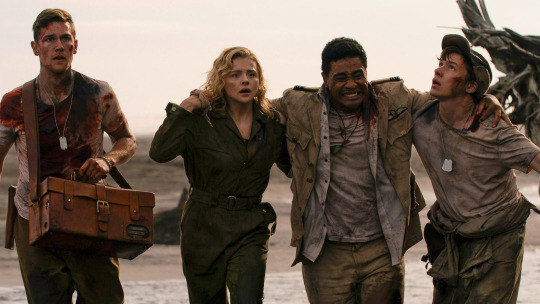
The Package.
As the bonkers genre thrill-ride Shadow in the Cloud blasts into the new year, writer and director Roseanne Liang unpacks her love of Terminator 2, watching Chloë Grace Moretz’s face for hours, and the life lesson she learned from Crouching Tiger, Hidden Dragon’s Cheng Pei-Pei.
Roseanne Liang’s TIFF Midnight Madness winner Shadow in the Cloud landed with a blast of fresh genre energy on VOD platforms on New Year’s Day. It’s A-class action in a B-grade body, cramming plenty into its taut 83 minutes, including: a top-secret package, a freakish gremlin, a hostile bunch of Air Force dudes, outrageous stunts, dogfights and a fake wartime PSA that feels remarkably real.
Throughout, the camera is focused mostly on one face—Chloë Grace Moretz’s, playing British flight officer Maude Garrett—as she tackles all of the above from a claustrophobic ball turret hanging under a B-17 Flying Fortress, on a classified mission over the Pacific Ocean during World War II.
While the film’s tonal swings are confusing to some, schlock enthusiasts and genre lovers on Letterboxd have embraced the film’s intentionally outlandish sensibility, which “makes excellent use of its genre mash to create an unpredictable, guilty pleasure,” says Mirza. Fajar writes that “it felt like the people involved in this project knew how ridiculous it is and gave a hundred and ten percent to make it work. Someday, it will become a cult classic.” Mawbey agrees: “It really goes off the rails in all the best ways during the final third, and the last couple of shots are just perfect.”

Chloë Grace Moretz and her top-secret package in ‘Shadow in the Cloud’.
To most of the world, Liang is a so-called “emerging” director, when in fact, the mother-of-two, born in New Zealand to Chinese parents, has been at this game for the past two decades. She has helmed a documentary and a romantic drama, both based on her own marriage; a 2008 short called Take 3, which preceded Hollywood’s current conversation about representation and harassment; and Do No Harm, the splatter-tastic 2017 short in which her technical chops and fluid feel for action were on full display, and, as recorded in multiple Letterboxd reviews, established her as one to watch.
Do No Harm scored Liang valuable Hollywood representation, whereupon producer Brian Kavanaugh-Jones brought Shadow in the Cloud to her, thinking she might connect with the material. “It did connect with me on a level that is very personal,” Liang tells me. “As a woman of color, as a mother who juggles a lot.” She says Kavanaugh-Jones then went through the process of removing original writer Max Landis from the project. “He felt that Max was not a good fit for this project, or for how we like to run things. We like to be respectful and courteous and kind to each other…”
In several interviews, Liang has said she’s comfortable with film lovers choosing not to watch Shadow in the Cloud based on Landis’s early involvement. What she’s not comfortable with is her own contribution—and that of her cast and crew—being erased. While WGA rules have his name attached firmly to the project, the credit belies the reality: his thin script, reportedly stretched out to 70 pages by using a larger-than-usual font, was expanded and deepened by Liang and her collaborators.
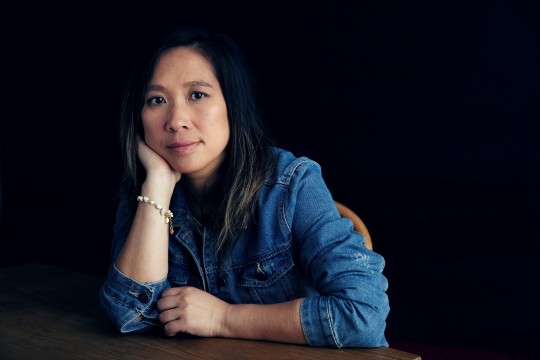
Writer-director Roseanne Liang. / Photo by Dean O’Gorman
That team includes editor Tom Eagles, Oscar nominated for Jojo Rabbit, actor Nick Robinson (the titular Simon in Love, Simon) and Beulah Koale, a star of the Hawaii Five-Oh series. The opening newsreel was created by award-winning New Zealand animation studio Mukpuddy, after a small test audience got weirded out by the sight of a gremlin in a war film, despite well-documented WWI and WWII gremlin mythology. It’s an unnecessary but happy addition. The cartoon style was inspired by Private Snafu, a series of WWII educational cartoons scripted by none other than Dr. Seuss and directed by Looney Tunes legend Chuck Jones.
But the film ultimately hangs on Chloë Grace Moretz, who overcame cabin fever to drive home an adrenaline rush of screen craft, in which the very limits of what’s humanly possible in mid-air are tested (in ways, it must be said, that wouldn’t be questioned if it were Tom Cruise in the role). Liang would often send directions to Moretz’s ball turret via text, while her cast members delivered live dialogue from an off-set shipping container rigged with microphones. “I just never got sick of Chloë’s face and I’ve watched her hundreds, if not thousands of times. You feel her, you are her, she just engages you in a way that a huge fighting scene might not, if it’s not designed well. Giant empty spectacle is less interesting than one person in one spot, sometimes.”
Ambitious and nerdy about film in equal measure, it’s clear there’s much more to come from Liang, and I’m interested in what her most valuable lesson has been so far. Turns out, it’s a great story involving Chinese veteran Cheng Pei-Pei (Come Drink With Me’s Golden Swallow, and Crouching Tiger, Hidden Dragon’s Jade Fox), whose film training includes a tradition of remaining on set throughout filming.
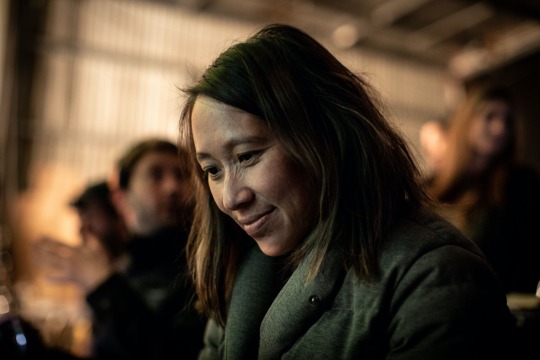
Roseanne Liang on the set of ‘Shadow in the Cloud’.
That meant that, during filming of Liang’s My Wedding and Other Secrets, Cheng would stay on set when she wasn’t required. “In New Zealand, trailers are a luxury,” Liang explains. “I said ‘Don’t you want to go to the trailer that we arranged for you?’ ‘No, I just want to sit and watch.’ ‘Why do you want to watch it, you’ve seen it hundreds of times!’ And she said ‘I learn something new every time’. To Pei-Pei, the secret of life is constant education and curiosity and learning. Movies are her work and her craft and her life, and she never gets bored. If I can be like her, that’s the life, right?”
Speaking of which, it’s time we put Liang through our Life in Film interrogation.
What’s the film that made you want to become a filmmaker? Terminator 2: Judgment Day is the movie that is at the top of the mountain that I’m climbing. To me it’s the perfect blend of spectacle, action design, smarts and heart. It poses the theory that if a robot can learn the value of humanity then maybe there’s hope for the ships that are us. That’s perennial, and possibly even more pertinent today. It holds a very special place in my heart, along with Aliens, Mad Max: Fury Road, Die Hard, La Femme Nikita and Léon: The Professional.
What’s your earliest memory of watching a film? I have a cassette tape that my dad made for my grandma in 1981 (he’d send tapes back to his mother in Hong Kong). I was three years old and he had just taken us to see The Empire Strikes Back in the cinema. And he can’t talk to my grandma because I’m just going on and on about R2-D2. I will not shut up about R2-D2 and he’s like, “Yes, yes I’m trying to talk to your grandmother,” and I’m like, “But Dad! Dad! R2-D2!” So it’s actually an archive, but it’s become my memory.
What’s the most romantic film you’ve ever seen? Eternal Sunshine of the Spotless Mind. It’s not the sexiest, but it’s the most romantic. That last scene, those last words where she goes “But you’re gonna be like this forever and I’m gonna be like this forever…” and he just goes “okay”. That to me is one of the most romantic scenes I’ve ever seen. It is a perfect movie.
And the scariest? If it’s a horror movie, the most scared I’ve been is The Ring. I was watching it on a VHS and I was lying on a beanbag on the floor and I was paralyzed with fear. I couldn’t move, because I felt that if I moved she’d see me! Also, American Psycho just came to me this year. I caught the twentieth anniversary of that movie, which is a terrifying film, and again, possibly more relevant now than when it was made. The scariest film that’s not a horror is Joker. It scared me how much I liked it. When I came out of the movie, I was like, “I’m scared because I kind of love it, but it’s horrible. It’s so irresponsible. I don’t wanna like this movie but goddamn, I feel it.” Like, I wanted to go on the streets and rage. In a way we’re all the Joker, we’re all the Batman. That duality, that yin and yang, is inside everyone of us. It’s universal.
What is the film that slays you every time, leaving you in a heap of tears? This is a classic one, the opening sequence of Up. The first ten minutes of Up just destroy me every time. I also saw Soul a couple of days ago and I was with the whole family and I, just, if I wasn’t with the whole family I would have been ugly-sobbing. I had a real ache in my throat after the movie because I was trying to stop [myself] from sobbing.
Tell me your favorite coming-of-age film, the film that first gave you ‘teenage feelings’? Pump Up the Volume. Christian Slater! Off the back of Pump Up the Volume, I fancied myself as a prophet and wrote a theater piece called Lemmings. Obviously the main character was a person who could see through the façade, and everyone else was following norms. “No one understands me, I’m a prophet!” So clearly I have this shitty, Joker-style megalomaniac inside of me. It was the worst play, and I don’t know why my teachers agreed for us to do a staging of it!
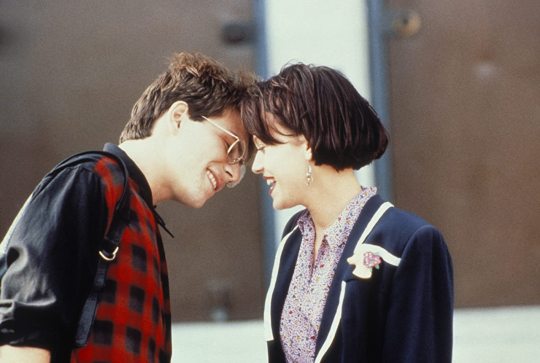
Christian Slater and Samantha Mathis in ‘Pump Up the Volume’ (1990).
Is there a film that you and your family love to rewatch? We’ve tried to impose our taste on our children, but they’re too young. We showed them The Princess Bride—they didn’t get it. We literally showed our babies Star Wars in their cribs. That’s how obsessive Star Wars fans we were.
Name a director and/or writer that you deeply admire for their use of the artform. I have a slightly weird answer for this. Can I just give love to Every Frame a Painting by Tony Zhou and Taylor Ramos? They are my film school. I was thinking of my love of Edgar Wright, but then I thought of their video essay on Edgar Wright and how to film comedy, and his essay on Jackie Chan and the rhythm of action and then their essay on the Coen Brothers and Shot Reverse Shot. I must have watched that 30 times ahead of the TV show that I’m making now. I started out in editorial and Tony Zhou is an editor and he talks about when to make the cut: it’s an instinct, it’s a feeling, it’s a rhythm. I realized the one thing in common that I could mention about all the films I’ve loved is Every Frame a Painting. It’s their love of movies that comes bubbling out of every single essay that they made that I just wanna shout out at this part of my career.
Were there any crucial films that you turned to in your development for Shadow in the Cloud? Indiana Jones was something that Chloë brought up—she likes the spiffiness and the humor of Indiana Jones. Sarah Connor was our touchstone for the female character. For one-person-in-one-space type stories, I watched Locke quite a lot, to figure out how they shaped tension and story and [kept] us on the edge of our seats when it’s only one person in one space. In terms of superheroes, I came back to Aliens. Not Alien. Aliens. You know, there are two types of people in this world—people who prefer Alien over Aliens, and people who prefer Aliens over Alien. But actually I think I vacillate for different reasons.
Can there be a third type of person, who thinks they’re both great, but Alien³, just, no? Maybe that’s the best group to be in. We don’t need to fight about this, we can love both of them! I was having an argument with James Wan’s company about this, because there’s a rift inside the company of people who prefer Alien over Aliens.
Okay, program a triple feature with your film as one of the three. I don’t know. Ask Ant Timpson!
I’ll ask Ant Timpson. [We did, and he replied: “Well, one has to be the Twilight Zone episode with William Shatner: Nightmare at 20,000 Feet. And then either Life (2017) or Altitude (2010).”]
Thank you Ant! I used to go to his all-nighters as a university student. He is the king of programming things.
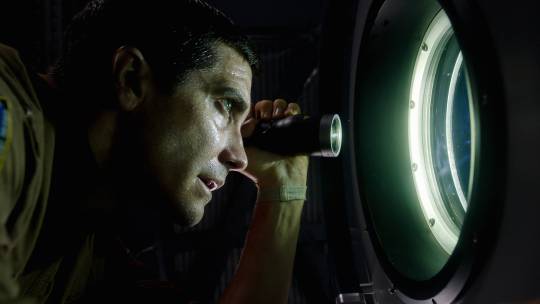
Jake Gyllenhaal in ‘Life’ (2017).
It’s strange that we never met at one of his events! Ant would make me dress up in strange outfits and do weird skits between films. (For those who don’t know, Timpson ran the Incredibly Strange Film Festival for many years—now part of the New Zealand International Film Festival—and still runs an annual 24-Hour Movie Marathon.) So what’s a film from those events that sticks in your head as the perfect genre experience with a crowd? It was a movie about a man protecting a woman who was the girlfriend of a mafia boss: A Bittersweet Life. Not only does it have one of the sexiest Korean actors, sorry, not to objectify, but also I actually screenshot a lot of that film for pitch documents. And, do you remember a crazy Japanese movie where someone’s sitting on the floor with a clear umbrella and a woman is lactating milk? Visitor Q by Takashi Miike. I remember just how fucking crazy that was.
Finally, what was the best film you saw in 2020? I haven’t seen Nomadland yet, so keep in mind that I haven’t seen all the films this year. I have three: The Invisible Man, which I thought was just amazing. I thought [writer-director] Leigh Whannell did such a great job. The Half of It by Alice Wu, a quiet movie that I simply just adored. And then the last movie I saw at the cinema was Promising Young Woman. The hype is real.
Related content
Kairit’s list of “She Did THAT!!!” films
Beyond Badass: Female Action Heroes
Up in the Air: The Letterboxd Showdown of Best Airplanes in film
Follow Gemma on Letterboxd
‘Shadow in the Cloud’ is available in select theaters and on video on demand now.
#life in film#letterboxd life in film#female director#directed by women#52 films by women#action film#action genre#chloe grace moretz#wwii film#ww2 film#terminator 2#chinese new zealander#cheng pei-pei#tom eagles#jojo rabbit#female action hero#letterboxd
4 notes
·
View notes
Text
The Top 8 Frankenstein Movies
8. Victor Frankenstein (2015)

This movie got a pasting from critics upon release, but I couldn’t care less, because I had a ball watching this. Mainly designed as a showcase for the stars Daniel Radcliffe and James McAvoy, the result isn’t exactly highbrow cinema but if you’re looking for a fun trip filled with hammy acting, overwrought (and overwritten) dialogue, and some pretty neat special effects, you could do a lot worse.
7. Son of Frankenstein (1939)
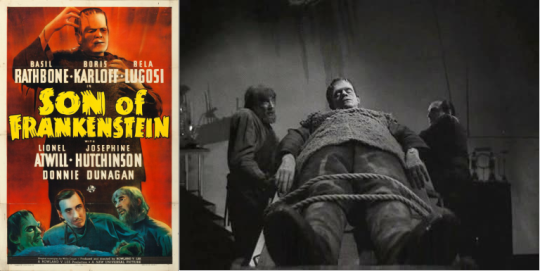
Of the 7 movies made by Universal Studios featuring the Frankenstein monster between 1931 and 1948, only the first three are really worth your time, and of those the third film, Son of Frankenstein, is easily the weakest, but it’s not without its strengths, mostly in the form of the performances of Basil Rathbone as the titular sire and especially Bela Lugosi as the malignant Ygor. The infamous star of Dracula is all but unrecognizable under a brilliant makeup design, and gives a magical performance that’s about as far removed from Dracula as anything he ever did. The big downside of Son is the monster himself, who is barely in the film and spends most of it lying motionless on a table. Boris Karloff turned 50 while shooting, and decided to never play the creature he made famous again after this flawed but fun film.
6. Mary Shelley’s Frankenstein (1994)

As the title implies, this is a (fairly) faithful adaptation of Mary Shelley’s original novel, and while a lot of the subtext of the story is lost beneath the weight of director and star Kenneth Branaugh’s ego and abs, the movie has a captivating quality and is gorgeously shot, and Robert DeNiro turns in a surprisingly nuanced and emotional performance as Victor’s patchwork creation. It’s a little oversexed and too self-consciously operatic at times, but it’s still one of the better stabs at bringing the actual text to the screen, even with the ridiculous electric eels.
5. Frankenstein Created Woman (1967)

Hammer studios made a bunch of Frankenstein movies throughout the 50s, 60s and 70s, and while none of them ever quite managed to capture the spirit of their first, they came up with some clever ideas, and none more so than the bizarre, inspirational, ingenious and insane Frankenstein Created Woman, a film that dares to ask the question “So you figured out how to bring the dead back to life--what next?” The answers this film explores are chilling, awe-inspiring, horrific and at times borderline blasphemous in their implications. And while it’s not a perfect film (two minds/souls in the same body gets kind of confusing), it’s compelling ideas and strong performances more than compensate.
4. Young Frankenstein (1974)

Mel Brooks’ loving tribute to the Universal Frankenstein films might be in it for the laughs (”SAID-A-GIVE?!”), but at it’s heart is a keen understanding of the themes of the Frankenstein story and why they’ve worked so well for so long. The cast is perfect, with each character instantly hilarious and iconic, from Marty Feldman’s endlessly-quotable Igor to Gene Wilder’s over-the-top Frederick Fronkonsteen to Cloris Leechman’s masterclass in comedic timing as Frau Blucher, but the real standout is Peter Boyle as the monster, who is quite possibly second only to Boris Karloff as the most effective Frankenstein monster we’ve ever seen.
3. Frankenstein (1931)

It was not the first Frankenstein movie (there were a couple of silent shorts), but it was the first that mattered; the one that change the whole game. Crackling electrical lab equipment, thunderstorms, grave robbing, grisly murders, blasphemous implications and truly inspired performances--audiences of the time had never seen anything like this, and the movie was a box office sensation that led to a whole slew of horror and gothic-themed movies in the early 1930s. James Whale’s direction is clever, creative and just unusual enough to make the movie still a lot of fun to watch today. Colin Clive as Henry Frankenstein is superb, giving us a nuanced and relatable Frankenstein that gets to speak what is arguably the most famous line in horror movie history (”IT’S ALIVE!”). The sets and cinematography are stunning, cementing the “Hollywood Gothic” style that would dominate horror cinema for the next three decades, and the special effects were striking for their time. But standing above it all was Boris Karloff’s shocking, heartbreaking, horrifying, unparalleled performance as the Monster. Overnight the heretofore little-known actor became a star and, with the help of a once-in-a-generation makeup job from the legendary Jack Pierce, set in stone the image of the Frankenstein monster that would stick in the public consciousness for all time.
2. Curse of Frankenstein (1957)

Legend has it that Universal Studios sent a letter to the heads of Hammer Films that essentially said, “If you do ANYTHING that even remotely resembles our Frankenstein movie, we’ll see you Brits in court.” But Hammer had entirely different ambitions, choosing to ditch the look, style, and structure of the Universal movies entirely in favor of something much darker, more disturbing, and infinitely more violent. While the classic Frankenstein movies of the 30s and 40s focused on the misadventures of the monster, Hammer chose to focus on the titular mad doctor. This might have seemed like strange choice at the time, considering the rather bland parade of various Dr. Frankensteins we’d seen in the Universal films, but actor writer Jimmy Sangster, director Terrence Fischer, and especially actor Peter Cushing went for something completely different. Cushing’s Victor Frankenstein is nothing less than a vile, contemptible bastard, remorselessly murdering people for spare parts for his pathetic monster; a monster who is killed and brought back to life several times over, and used by the villainous doctor as a tool to dispatch his enemies and those who threaten his work. This film took the conventions of the Frankenstein story audiences were then used to and knifed them in the face, and the result was a spectacular success with people lining up around the block to see this new level of ghoulish and bloody horror. Throw out everything you think you know about the Frankenstein story and give this one a spin, if you’ve got the stomach for it.
1. Bride of Frankenstein (1935)
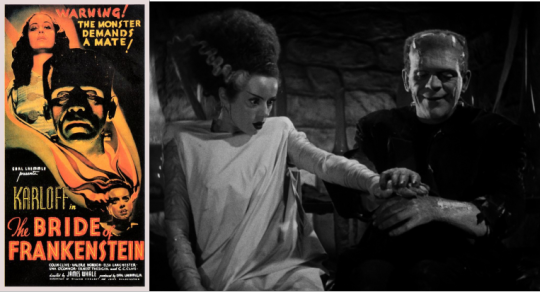
Seriously, what else was it gonna be? Let’s be honest here--horror sequels are usually crap. Quickly churned out to make an even quicker buck, they’re rarely worth the film they’re shot on and very few are anywhere near as good as the original. However, the only one that actually might be better that the original is the simply unique Bride of Frankenstein. Whole books have been written about this movie, and to be honest there’s simply too much to talk about. The themes of blasphemy. The homosexual overtones. The Faustian narrative about death and damnation. The incredible performance of Ernest Thesiger as Doctor Pretorious. The monster’s dialogue (”Friend...good!”) The design of the titular Bride that kicked off a fashion craze. Franz Waxman’s angelic soundtrack. Any one of these topics is worth an essay all by themselves, but for me what really makes Bride a masterpiece is simply its heart. No other film has explored the tragedy of the Frankenstein story as effectively as this, and no other film gets its moral message through as clearly: it’s the simpler things in life, like love and friendship that are truly important, and while the pursuit of knowledge may be a worth endeavor, those who pursue it to whatever evil and horrifying end are far more monstrous than any stitched-together being they shock into life.
7 notes
·
View notes
Text
Too Shy
Tom Holland x Reader
Summary: You’ve fallen for your best friend and you don’t know if you should tell him
Warnings: alcohol consumption, angst? smoking (I don’t kow how to do these warnings so if there is anything in here you think I should mention, let me know)
A/N: Hi, this is my first time posting my writing on tumblr, so bear with me haha. The inspiration for this story was the song 2Shy by Shura and there is going to be a second part to this I just haven’t really figured it out yet :D But for now ENJOY! (Feedback is greatly appreciated)
You were shy. No, that’s not right. You were too shy. Your palms were sweaty just thinking about talking to strangers. And when it came to admitting feelings it was worse. It took you long enough to even realise that you had fallen for your best friend. Talk about being cliche. Telling him was completely out of question. You couldn’t. It wasn’t really that you were afraid of his reaction...Okay, you were terrified. But you felt like Tom would be cool about it. He wouldn’t laugh at you. Maybe he would say that he’s flattered. But about one thing you were sure. He wasn’t feeling the same way. Of course, you had gotten your hopes up a few times, when he moved a strand of hair out of your face or looked at you just a little bit too long. But he deserved so much better than someone who couldn’t even talk about their feelings with him. The thing is, you’ve known each other for four years and neither of you ever really had a serious relationship during that time, but you knew of a previous girlfriend he had and let’s just say... he’s way out of your league.
You noticed Tom sitting by the window looking out for you and sending you a wave when you noticed him. The plan was to get some drinks and then go to the cinema to watch a film, you weren’t really sure which film you wanted to see but it was a tradition to go see a movie together once a month (when he wasn’t away filming) and since October was coming to an end soon you both decided today would be the day.
“Hey.” You smiled softly and sat down across from Tom. While a lot of people would greet their best friend with a hug or some sort of affectionate gesture, you couldn’t bring yourself to do so in a public place like this. Especially since you realised your feelings for Tom were not just platonic, you decided it would be better if you kept your distance, at least physically, as much as possible. You didn’t know if Tom noticed the change in your behaviour but you figured he didn’t because he was still the same old, acting as nothing had changed. Because for him it didn’t.
“Hi Y/N, how is my favourite non-smoker?” His smile was kind but a little bit teasing. He didn’t believe you when you told him a few weeks ago that you wanted to stop smoking. Well, he believed you that you wanted to but he didn’t think you’d go through with it.
“I think the proper term would be ex-smoker, and I’m doing fine. Haven’t even had the urge to smoke today.” Okay, that might have been a bit of a lie. You had thought about it once today and that was when you were getting ready for tonight, thinking about how you’re going to survive an evening close to Tom. But you couldn’t tell him that. So you just tried to send him a convincing smile.
“I’m so proud of you for that, y’know?” His smile was dazzling and you couldn’t help but return it.
“Thanks, Tom. What’ve you been up to today? Did you go to that audition you talked about?” Ever since you’ve known Tom he’d been an actor. He had been in the process of auditioning for Spider-Man when you met and you couldn’t be more excited for him. And to be honest it was pretty cool to be friends with an A-List celebrity. Of course, it wasn’t always easy, especially when a crowd of fans recognised him and you were struggling to get away from all the people, but when you eventually did and watched him interact with his fans it made you proud. He was always nice to them unless they gave him a reason not to be and when he was finally finished and joined you again he was apologetic, but you always told him it was fine because it was.
“I did. It went okay, but I’m not sure I’m the right one for the role...” he shrugged his shoulders and took a sip from the pint of beer in front of him, reminding you that you should order something for yourself.
“Really? Why’s that?”
“I dunno... it’s just... I’ve never really done romance ya know? I’m not sure I’m cut out for that.” He shrugged again moving his head to look out the window.
“Tom, you’re one of the most talented actors out there. You’re cut out for anything.” You chuckle as he drops his head, a blush on his cheeks. “Plus, you’ve definitely got the looks.” Your eyes go wide as you realised what you’ve just said. Never have you ever commented on how handsome Tom was. You hoped he didn’t notice, but the way he looked at you with a smirk on his face told you otherwise.
“You think?” There was a glint in his eyes and you felt your face heat up.
“Uhh... I’m gonna get something to drink.” You managed to get out while clumsily getting up from your chair. Tom just chuckled, knowing you were probably mortified right now.
Waiting at the bar you let the last minutes replay in your head. Had you really just said that? Yes, you had. But, you told yourself, it wasn’t a big deal. He knew he was attractive, all you did was boost his ego. Just because you said that doesn’t mean he now knows you have feelings for him. Though the way he looked at you was different. And that smirk? If you were being honest with yourself, it gave you a little bit of hope. You just told him he is handsome of course he’ll smirk, he’s a little shit and you know it. Everything was fine. Chances are he didn’t think anything of it. Still, you ordered a shot with your cider, because maybe -just maybe- you wanted him to know. And for you to ever tell him, you needed a bit of liquid courage. Within seconds you had the perfect plan: get a little buzzed, go watch a movie with Tom and then tell him how you feel. Great plan right? No. You couldn’t just tell him you’re in love with him. No way. Or maybe you should?
You down the shot in one and take the cider to the table at the window where Tom was waiting for you with a questioning look.
“Did you just down a shot without me?” He was laughing but it was evident that he was starting to worry.
“Maybe?” It was more of a question than an answer. You stared at the glass in front of you running your thumb over the logo.
“What’s wrong?” Tom asked softly and you could feel the corners of your mouth moving downwards on their own accord. “I know something’s up, so don’t tell me you’re fine.”
“It’s nothing, really.” You couldn’t tell him. A voice in your head kept telling you that you needed to just take the leap and tell him because otherwise, you’ll always wonder what if. But you know what you have now and you don’t want to lose that. You’d rather have him in your life as a friend than not at all.
“C’mon Y/N. We both know that’s not true.” You looked at him and his eyes stared into yours and you swore everything around you disappeared. Your mind ran a hundred miles an hour. Was there anything that freaked you out just remotely as much as your feelings for Tom did?
“You know how I get when Christmas rolls around. With all the presents and stuff.” Tom looked at you quizzically. It was not even November. Not good enough. “And I’ve got this really important paper for uni that’s been stressing me out...” That’s more like it. Tom nodded, knowing how important doing well in uni was for you.
“Whatever it is you’ll do amazing.” He reaches his hand out and squeezes yours, the sudden touch making butterflies erupt in your stomach.
You chose to watch a drama this time. You had gone for a comedy last month and it had been filled with stupid jokes that neither of you found funny and you hoped for something with more substance this time around. The two of you were sitting towards the back, a bag of popcorn between you. Tom insisted to get the biggest one available, his treat. Halfway through the movie, you stopped reaching inside. You didn’t feel like popcorn anymore, it was just too much, too sweet and your hand brushed Tom’s too often. A couple of minutes later Tom nudged your elbow with his, silently asking if you still wanted popcorn. When you shook your head he took the bag and moved it to the empty seat beside him, leaving a big gap between the two of you. The armrest had been pulled up so the popcorn could fit between you, but now that the bag was gone you wanted to scoot closer to Tom and lay your head on his shoulder. His arm would hug you into his body and you would be so happy. But you didn’t. You were too shy.
You were so consumed with the thought of Tom being so close and whether or not you should make a move that you couldn’t focus on the movie. So when it ended, and Tom asked you what you thought of it, you shrugged your shoulders and said it was alright.
“Alright? It was amazing! Did you watch a different film in there?” He chuckled but you just shrugged your shoulders again.
“I’m gonna go to the toilet real quick, I’ll be right back.” You needed a few moments alone, away from him. The longer you spend time with him the closer you wanted to be and every time he smiled you felt like you were falling harder. You needed to do something. You needed to tell him. Now or never.
During your walk back to the lobby of the cinema you kept encouraging yourself. This was the right thing to do. Be confident for once in your life and tell him how you feel. Your steps had gotten quicker the closer you got to the lobby and you were pretty sure the only way to tell him without you backing out was going up to him as quickly as possible and just blurt it out.
But you stopped in your tracks when you entered the lobby and saw Tom animatedly talking with a young woman. She was about your age and gorgeous. Tom’s hands were moving in the air and just by looking at him you could tell that he was talking about the film. With slow steps, you walked towards them, not daring to look at the woman your eyes fixed on the carpeted floor until you were standing right beside Tom.
“Hi.” The girl said with a big smile and you had to force yourself to return the smile.
“Y/N this is Cas, we met at the audition today. Cas this is my friend Y/N.” Even though both of you hadn’t been in a relationship since becoming friends you had made up a rule that whenever either of you was interested in someone you would introduce the other as your friend, thinking that it might scare off some people to say that you were best friends. It was stupid really, but it was also a type of secret message between Tom and you. So, Tom now saying that you were his friend meant that he was interested in Cas. You could only thank the universe, or whatever was out there, that she showed up when she did because otherwise, you would’ve told Tom that you’re in love with him just to be turned down.
“Okay, uhh... I think I’m gonna go home now.” Your flat wasn’t far from here and you could easily walk. Even though Tom had offered to drive you home earlier, you were sure he wanted to spend some time alone with Cas.
“You want me to give you a lift?” Tom could tell you were uncomfortable with the situation and he really didn’t want you to walk home this late.
“No it’s fine, it’s only a five-minute walk. You two have fun.” Tom wanted to hug you but you moved away too quickly, desperate to get out of the cinema.
“Okay, I’ll call you later.” Tom called behind you and you just raised a hand to show that you heard him.
To say that you were distressed was an understatement. You had finally picked up the courage to tell him how you feel and just before you could Cas shows up. But you’re thankful, too. This probably spared you a lot of pain. You couldn’t think about that now though, because you were in pain regardless. Your fingers played with a long-forgotten cigarette in your coat pocket. You knew you shouldn’t light it because you haven’t smoked one in weeks. But the cigarette was between your lips before you could think about it and out of habit, it was lit up a few seconds later. You failed. A few weeks of not smoking for nothing. Just because your best friend was interested in a girl that wasn’t you. You let out a humourless laugh just to keep the tears at bay. I will not cry about this.
Part 2
A/N: I’d love to hear your feedback! :)
#tom holland imagine#tom holland fic#tom holland x reader#tom holland scenario#tom holland fanfic#tom holland fanfiction#best friends to lovers
648 notes
·
View notes
Text
Halloween (1978) - Based On A True Story
It’s the tagline that haunts the horror film industry: Based on a True Story.
Typically, it roughly translates to “a door moved several feet so shit this is a haunted hizzle ma dudes”. Or, it represents some of the most iconic moments in paranormal phenomena.
It was Halloween (1978) that surprisingly slotted itself into the second category of films.
Halloween is famous for several reasons, indeed, it’s one of the most celebrated horror films to have graced your not-so-legal streaming site.
It’s a cult movie for slasher fans, and it’s name has centred it as a must-watch during this season. And it’s all because it echoes out those eerie vibes of urban legends, but snaps us back to the chilling reality of pyscho-killers when we need it most.
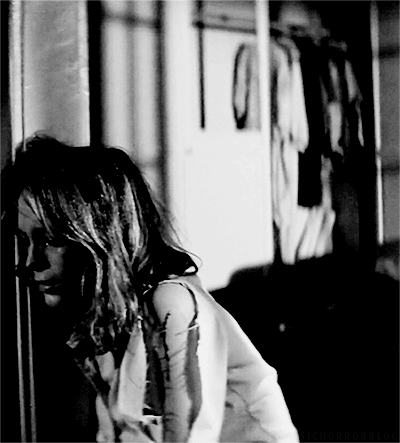
It even started the slasher film craze that would tumble one corpse-domino into the following decades.
And it’s based on a true story.
Which, ya know, that’s fine, this is so fine, this is great.
So, it got me thinking: what was this true story? And are there any other similar stories that we need to know about come Halloween night?
Unfortunately, there are.
There are so many.
Today’s post is going to take us back to the story that inspired the Halloween series, the similar stories that bulked up the shocking reality of the 11-film saga, and the urban legends that still echo out these themes.
So, whether you’re carving a pumpkin, or piecing together your costume with a hot glue gun, settle in.
Let’s get spooky!
First, let’s recap the Halloween saga.
And lord, she’s a saga.
Across 11 movies we witness one plotline: this bloke, Michael Myres, stalks Laurie Strode.
No, he is not the lovable voice behind shrek.
And no, ‘shaggable’ is not used as a comical easter egg mid-murder in these movies.
But despite this basic plotline, normally a dash of back story is chucked into the occasional prequel-sequel-who’s-a-what’s-now to shake things up and drag it across 11 films.
Take the backstory of Laurie Strode - she’s his estranged sister, a connection which is dragged down to her daughter, Jamie. This is the central line that the series dances around.

It’s a bit like American Horror Story - you know when every season has a different setting?
There’s been a college massacre; there’s been a hospital of horrors. There’s been more reboots then Britney Spear’s career!
But pushing aside the mess of writers chipping in a line for each screenplay, and wiping off the fake blood coating the legacy of films, one thing is for sure:
We centre on a psycho-killer who defies all psychological analysis.
Michael Myers is pure evil.
That’s the point.

It’s the true fear that I think we all have - it’s this unrelenting force that’s out to get you and will not stop, will not sympathise, will not suffer nor scar.
And so we arrive at the true story behind this phenomenon of a franchise.
Unless you’ve been stuck under a rock for, what, 40 years - no seriously, I did maths and everything - then you will be oblivious to the Halloween saga.
But for everyone else, there is only one image that pops into the head when it comes to these films - and it’s Michael Myers in his white mask, and cloaked in a blue jumpsuit.
#OOTD

And he is based on a true story.
The OG director and co-writer of the OG film - John Carpenter - was approached with the premise of a film many moons ago.
And let’s be honest: it’s more basic than I am.
The whole idea was that this psycho-killer slits bitches up on All Hallows’ Eve. Simple, right?
Well it was Carpenter that added the twist on Myers that sent this flick head-first into film history.
Carpenter was reminded of an encounter he had at University whilst visiting a mental institution. He came across a boy, maybe 12 or 13 years old.
And he had this look.
He had this look that he could only describe as emotionless, as pure evil - and this probably inspired this quote from the film from Myers’ psychoanalyst:
"This blank, pale emotionless face. Blackest eyes. The devil’s eyes. I spent eight years trying to reach him and then another seven trying to keep him locked up, because I realized what was living behind that boys’ eyes was purely and simply evil."
Oh, you thought it stopped there?
Oh, my little ghoul.
No, it continues.
Myers is believed to be complete and utter evil. And this is based on the historical root of Halloween.
Samhain is the celtic celebration behind the best day of the whole entire year. And in basic terms, it is the conflict between summer and winter, or, between good and evil.
Sound familiar?
Okay fine, every horror film - no, scratch that - every goddamn film is about the fight between good and evil.
But it’s Halloween that brings this up. Halloween drags it up from the depths of hell and puts a white face mask on it.
However, legend has it that there is another real life story that directly influenced it: and that’s the murders committed by Stanley Steirs.
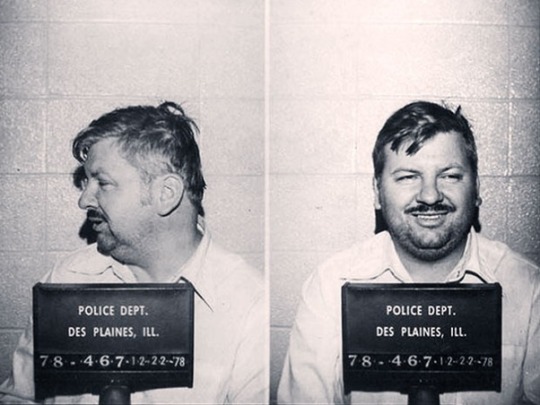
Take yourself back to 1920.
On Halloween night, Stiers went on a killing spree, going so far as to murder his own family.
Carpenter - nor, anyone affiliated with this cult series - makes mention of Stiers. But it’s safe to say that the sheer volume of murders that happen to fall (or purposefully striking) on Halloween is nothing short of inspiration.
The film might stick to the big screen, but the reality is never too far from the cinema doors.
It’s here that we turn to these real life events.
I’ve found five major events of murders, assaults and kidnapping that have collided with Halloween, mirroring the images on the big screen.
(Yeah, it wasn’t a positive google search experience.)
And none of them fall short of the actual movie inspiring this post.
We start in 1975, a mere 3 years before the original film hit the cinemas.
It was the morning of Halloween when Martha Moxeley was found beneath a tree in her backyard. She was dead, murdered via a beating with a golf club.
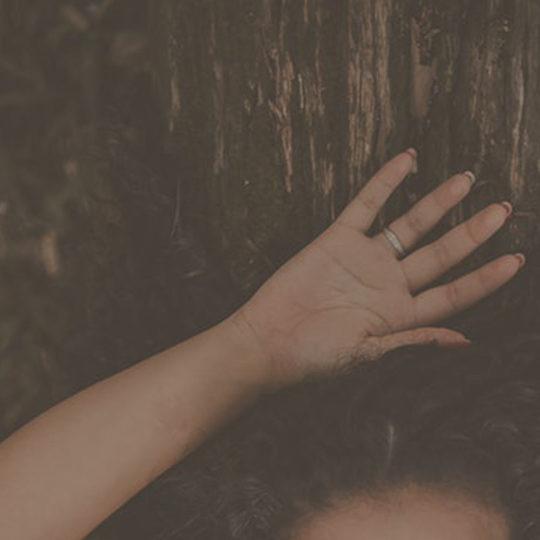
It was 25 years later that Michael Skakel - then, a 15 year old body - was arrested and convicted for her murder. This story gained attention not for the gruesome circumstances of Martha’s death, but because of the sheltered, and famous life he had lived.
He was the nephew of Robert F Kennedy’s widow, and had spent him life swanning around the elite circles.
His alibi? Well, it’s just as disturbing as her death.
He claims that the reason his DNA was on her body was because he was masturbating underneath the tree she was found under on the same day.
These themes aren’t so unheard of in Halloween - indeed, the opening scene features the uncomfortable sex scene of Michael’s sister and her boyfriend before he stabs her to death, completing his first kill.
We then jump forward a few decades, and dive headfirst into arguably the decade of the most Halloween related murders. Indeed, given the stretch of slasher films before this decades that were spiked by the movie inspiring this post, the film itself could have figured as an ambition for these murders.
And it starts in 2002.
Chris Jenkins - a student at the University of Minnesota - was last seen alive at a bar on Halloween night. Four months later, his body - still clad in appropriate Halloween get-up - was found in the Mississippi River.

This is not the first halloween-related catastrophe to be witnessed in this river.
Obviously someone falling into a river on a infamous night of parties and revelry can be seen as either an accident, or a suicide. But it was 4 years later that the death was reclassified as a homicide.
Even though someone did confess to the police that they witnessed a murder, it is still shrouded in a mystery fit for an urban legend.
Particularly as it is rumoured to be a victim of the Smiley Face Murders.
Basically, 40 male college students in the US died of drowning around the same time, and graffiti of smiley faces was found around the sites of the murder.
The murderer was never found.
Next, we turn to a similarly urban-legend like story: the murder of Leslie Mazzara and Adriane Insogna.
It was 31st October 2004, and three roommates - including those that were murdered - were enjoying Halloween night. Having handed out Halloween candy all evening, Lauren Meanza awoke to the sounds of a scuffle at 1am.
She fled the house in fear, and turned around to see someone climb out of one of their windows.
She ran back inside, only to be greeted by the corpses of her roommates.
Nearly 1500 people became persons of interest, but it was when Eric Copple - who was apart of this pool - refused to cooperate by handing over DNA, suspicions were roused.
A year later, he confessed to the murders.
No motive was given, but he was engaged to a friend of one of the victims, creating a peculiar link that must’ve inspired the events of that fateful night.
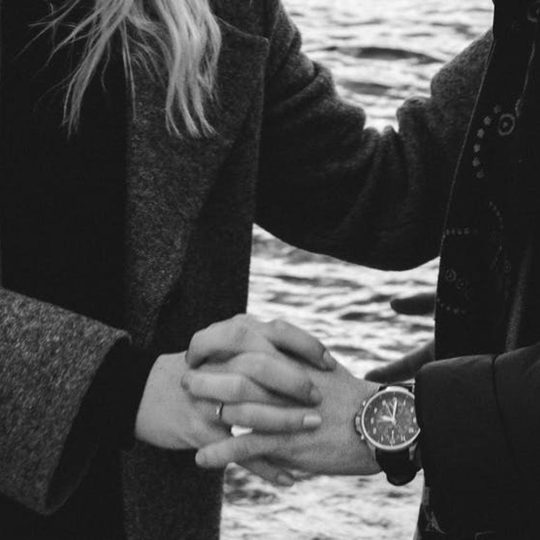
6 years later, an Ohio teen encountered a similar situation.
He returned from a church service to the bodies of his murdered family, including his new stepfather, William Liske.
The killer behind the murders was found to be Liske’s son from a previous marriage who had a history of violence and schizophrenia.
2009 too witnessed a grotesque event.
3 teenage girls were held at gunpoint and abducted following an evening of trick-o-treating, and were sexually assaulted in a wood. Luckily, one of the girls was able to use her phone to call for help, causing the kidnapper to flee.
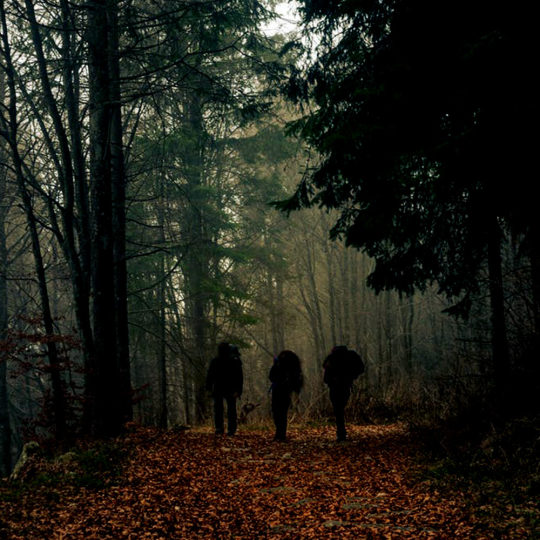
When he was eventually arrested in 2012, it followed a string of previous sexual assaults that have occurred since the late 90s.
Our final murder takes us to Halloween night, 2011.
Taylor Van Diest was believed to have just left a Halloween party when she was beaten to death near railway tracks.
The story only gets ever-more terrifying considering she texted her boyfriend shortly before the attack to tell him that that someone was following her.
The police eventually found DNA of the killer underneath her fingernails, leading them to the culprit.
Traumatised? Me too.
But these tales don’t end with finished cases, and they certainly don’t end with the credits of the films they inspire.
They come back to haunt us in the urban legends set on Halloween.
Clearly, halloween-inspired murders make the most iconic urban legend concept. It’s the scariest time of year, and what’s scarier than, well, murder?
One of these legends sticks to this theme, closely mirroring the film in question.
It’s affectionately known as the 1962 Idaho Massacre. The story goes a man in a black mask attended a Halloween party in - you guessed it - Idaho.

He proceeded to lock all the doors, and then murder each and every attendee of the party. Well, he is believed to have killed 7 before escaping.
He was never found. But it is still claimed that his mask was found by the FBI in 1969.
The murder train continues with the most noughties urban legend ever.
In 2008, an email chain warned people that a gang was to hold an initiation on Halloween night.
And the task that needed to be completed?
The murder of 31 women, each death a day of the month.
And in true urban legend fashion, 140 women were to be killed in another version of the email, and so the list of variants continues.
Our next tale of terror sticks to a more classic halloween story - that of the haunted house:
Well, this house either exists in Pennsylvania, Detroit, or Chicago; regardless, this is a typical and twisted tale often encountered with urban legends.
The story goes that a haunted house with 13 floors exists. I mean, fuck that’s a tall house, how did they get that signed off?
But the legal repercussions are not the frightening feature of the story.
The challenge is to make it to the top floor alive. If they do, they win some cash. If they don’t… well they're dead, so there's that.
Legend has it that no one ever made it to the top floor.
It also doesn’t exist, but anyway.
What about the campus massacres of halloween night?
Every year, from 1960 to 1998, psychics would make the same prediction for Halloween night. No points for guessing what the prediction was…
Next is the rumoured threat to animals.
Satanists have always been supposedly murdering black cats on Halloween for decades. Or maybe it’s witches capturing them for ceremonies? Or maybe its National Kill a Pit Bull Day, the all-American hoax that cropped up in 2012?
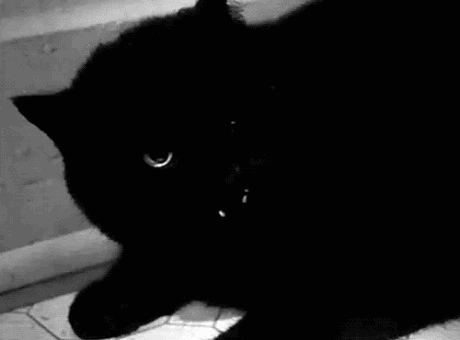
Either way: no one is safe. Not even ya doggo.
Our final urban legends prey on children, and infer that they will either be drugged, poisoned, or stabbed on some sort of sharp implement.
Happy Halloween, everyone!
These are the most prevalent legends, especially since trick-o-treating and dressing up are children’s activities, even if we all like to partake - child or not.
Some real life cases have even informed the fears that candy has been spiked with poisons, such as the case of the poisoned Pixy Stix.
It was Ronald O’Bryan who spiked his son’s candy with cyanide with the ambition of receiving a hefty insurance cash payment.
There have even been rumours of temporary tattoos being laced with LSD!
The original icon for this was a blue star, but this eventually included other unsuspecting images such as Mickey Mouse.
Cause nothin’ says drugs like Disney.
Now we turn to pointy things.
Commonly needles and razors blades are rumoured to be concealed among halloween treats handed out to kids. This was even proven in 2000, when a man was charged with concealing needles in chocolate bars.
Not convinced by razor blades? What about drugs being smuggled across borders, or handed out to children?
Fact is, these urban legends could go on forever.
They twist, they turn, they come back around full circle, and they pack up shop to move to different parts of the world.
And when we finally think we are safe from the myths and legends that haunt halloween…
Tragedy strikes.
Fact is, Halloween isn’t just based on the demeanor of one psychotic teen.
It’s based on stories that happen year upon year, reminding us that urban legends are never too far from the truth.

#halloween#halloween 2019#halloween 1978#halloween 2018#michael myers#friday the thirteenth#laurie strodes#unsolved mysteries#crime#murders#halloween costumes#halloween costume ideas#halloween makeup#pumpkin carving#pumpkin ideas#purge mask#halloween decorations#halloween film#halloween 2#halloween h20#halloween michael myers#horror film#horror movies#midsommar#paranormal#supernatural#spirits#demons#haunted#suspiria
22 notes
·
View notes
Text
An Interview with Matt Parker of Grillbird Teriyaki on How To Start and Grow a Thriving Restaurant
Nate: Hello and welcome. You’ve found “The Savory Secret’’ where we talk to and learn lessons from founders on starting and growing a thriving restaurant. I’m your host Nate Ver Burg. Our guest on the show today is an artist and designer who had a dream of opening a restaurant, but he had a problem. He didn’t have any money. What’s worse, he opened his restaurant just months prior to the statewide COVID-19 mandatory dining room closures. Today we’re gonna learn what he did to obtain the initial money needed to start his restaurant, and whether his recession-proof planning prior to starting his business would enable them to endure the forthcoming pandemic response. Matt Parker, it’s great to have you on the show today.
Matt: Hey Nate.
Nate: Hey there. So let’s start at the beginning. Tell me a little bit about where you grew up and some of your upbringing.
Matt: Yeah, for sure. So I grew up in a little town called Half Moon Bay, which is in Northern California, just south of San Francisco, so really idyllic, wonderful town, a little beachy town. And back in the ’80s, it was just a really cool place for a kid to grow up. We had the beach. We had mountain biking. And as I got older and kind of grew up a little bit and started to form, you know, my own identity, the town, I kind of outgrew that town. So I moved to Palo Alto and went to high school out there and kind of finished off my school in Palo Alto. You know, I grew up with my grandparents as a kid and then moved back in with my mother who was a single mom and we had a great relationship and she was really supportive of me growing up and being kind of whoever I wanted to be and, you know, allowing me to sort of experiment and explore who I thought I was or wanted to be.
And so I had a pretty eclectic childhood. I was really…I tried out a lot of different things. I tried a lot of different arts. I was always involved in theater and in visual arts. And I got to…you know, I did Rocky Horror Picture Show when I was a teenager and I went to San Francisco and hung out with friends on the weekends and just got to do a lot of fun stuff that I might not have been able to do if I had a more traditional upbringing. But my mom was pretty laid back and really trusting and kind of let me be who I was. I worked, from the moment I could get a job, I worked.
So at 14, I got a job at a movie theater and loved that job and fell in love with cinema and old movie theaters. And I think that was sort of the first…my first kind of introduction into what it feels like to be taken out of reality and put into something more fantastical, I guess. And it started to, you know, heavily influence my love of design and my love of eating out and just sort of being immersed in something aesthetically different and beautiful than the real world.
And so that all kind of transitioned into me working in restaurants, going from movie theaters to then working in cafes and then into restaurants and then just sort of, you know, falling in love with the, I guess the sort of magic of dining, but also the environment. I’ve always been sort of aesthetically-guided and so I love what it felt like to eat at nice restaurants and what it felt like to be served by professional servers and what really good food played it up in a really interesting way felt like.
So that’s something from a very young age I was always inspired by. And you know, that all kind of you know, led me to go to art school, right out of high school, which didn’t really work out for me. I was a little, you know, 18 years old and I didn’t really have any stories to tell and I didn’t really know myself and I didn’t really get any good work done. So I kind of tried that out for about a year and then I moved back home and kind of went to some community colleges and of course just kept working in restaurants. And then when I was about 20, I decided I needed to leave home and grow up. And didn’t really know where I was wanting to go, but I knew I just couldn’t stay at home anymore.
So I bought a bus ticket to Seattle and came up here about 20 some odd years ago and stayed in a boarding house for a couple of months and, you know, just hit the streets every day looking for work. And finally got a job at a little cafe in Belltown, which is no longer there, but that’s kinda what started it all off, at least for me in Seattle. And then my culinary sort of journey and art journey as well.
Nate: Yeah. So tell me, like you mentioned the movie theater experience. What was it that captivated you so much?
Matt: In Palo Alto, there’s a series of vintage movie theaters. And so as soon as I turned 14 and was able to work, I got a job at one of these movie theaters. And these were landmark theaters, so they showed foreign films and independent films. And at that time I was obsessed with cinema. I was obsessed with foreign films and, you know, just unique independent cinema. And I fell in love with these old movie houses that were built in the ’20s and the ’30s. I just love the architecture. I love the feeling of being in them. I loved all the fun, the weirdo movies that they showed and it just really influenced my art and my creativity at the time. I mean, back then it was all I thought about. It’s all…I was obsessed. I was literally obsessed about movie theaters and old ones and I just loved being in those rooms.
And so when I worked, got to work for one, it was like such a great job. And I had so much fun and I got to, of course, I got to work with adults. So which I had always loved working with, you know, being around older people. So I get to work with the cool kids at the time and kind of find myself through them. I get to work in these old movie places and bop around the catacombs of these spaces and find tons of ephemera and of course just like feed my desire for film. And so films and going to bookstores and magazines, those are all like the way that I fed my creativity at the time. You know, obviously there was no internet.
So this is just how, you know, I learned to identify, you know, with myself and who I wanted to be or who I thought I wanted to be. But yeah, that was really like the escapism part of it was fantastic. I mean, back then I would think that I lived in a different time. I would consider that. I was like, I lived in my own movie of my own creation. And that was like some me, like in Paris in the 1920s, like that’s sort of how I identified at 14 years old. And yeah, it just really kind of set me on, you know, this creative path.
Nate: You know, you started to get into restaurants and things like when you moved up to Seattle. How did you take that creative mindset and start applying that into the restaurant space?
Matte: Well, I didn’t at first. I mean when I moved here I was, you know, an artist and I was a visual artist. I was a painter. But I also loved working in restaurants and I had done some restaurant work back in California. And so that’s just where I naturally fell into. And so, you know, waiting tables or busing tables back then that, you know, paid the bills. But I of course, I loved the energy of it. I loved the hours. I loved all the people you end up meeting. I loved the sort of debauchery and the chaos of it all. And it worked perfectly as a creative person because you’re just also surrounded by creative people all the time and the hours are great. You know, you’re up late, you have your days free.
So they were pretty much separate for the next 10 years. So I kind of made a move to be a creative person in Seattle. You know, I worked as an artist. I created some events and produced art events and did group shows. And then I also worked in restaurants and waited tables and just…and bopped around different restaurants over the next decade. And so they were all fairly kept separate for most of my 20s. And it wasn’t really until my early 30s that I actually merged them together after, you know, just a kind of a series of bad life choices had kind of brought me to kind of a new…kind of starting over, I guess. And part of that starting over was to kind of tap back into my creative side and merge my love of food and art together.
Nate: So what did that look like, merging those two things? Like in practical ways, like what was that all about?
Matt: Yeah, so you know, the restaurant business is, you know, it’s very fun, but it comes with a lot of consequences. And so for me, I developed a drinking problem in my 20s, and by the time I was in my early 30s, it was, you know, kind of…I pretty much exhausted all other outcomes of positivity. So I had to change my life. And so I quit drinking to end up saving, you know, my relationship with my girlfriend who’s now my wife, but at the time. And through that process of quitting drinking, not working, getting rid of all of my friends and basically self-quarantining myself at home in order to kind of break the shackles of those old habits, I kind of tapped back into this creative side that I hadn’t had in years. And that manifested into a new business where I was starting to…I did event design.
And so in the beginning, nobody really would hire me to decorate their party. They all wanted catering. So I would cater their event totally illegally. Like out of my apartment. I would just make all this food. And then on my own time and my own dime, I would do all the decorations. I designed the little menu cards and design the little tablescapes. And again, I had no money. So everything I started making was like out of folded paper and cardboard and recycled materials. And I just kept doing that. And I just, you know, in the beginning it was just one party at a time and one party a month. And I would go out and hustle for business and I’d go to friends’ little boutique shops and ask them if I could do a window display for them or I’d go to the rental company, the event rental company, and ask them if I could do a tablescape for them. And then I would do it, I’d photograph it, and then I’d send it to blogs and wait for someone to respond to it.
And so I just kept doing that. And eventually I would get hired. Eventually a friend hired me to do their birthday party and I would decorate their party. And again, I had no money and they didn’t have any money. And so everything was made out of cardboard and, you know, these…and trash basically. But one client after another, you know, started to kind of build into this little business where I started to kinda make a little bit of a name for myself and every event I would shoot it and send it off to blogs. And every once in a while, a blog would post the story and then I’d get a lot of attention and then I would kind of get on the radar of different editors of wedding magazines or whatever.
And so then I started to kind of be a little bit more enrolled and involved in the wedding industry and in the event industry. And so I started getting hired more and more. And the things that I was trying to do differently was I was trying to just create these kind of immersive, all encompassing events that were really creative and not typical sort of decor. So I always talked about how my events always kind of looked like an anthropology window display. Like they were really over the top and they were…kind of used a lot of recycled materials and that’s kinda what I did. And I did that for a good year or so.
But the thing about event work is… And also that kept me close to sort of the food world and the restaurant world. And I had done so much catering in my 20s and so much restaurant work. So it was always connected, the event world and the restaurant world were always sort of tied together and it kept me close to that world.
Nate: So all these events that you were doing, were you still being forced to cater these, like from home, like you’re talking about or did you eventually just transition that to just do the design side?
Matt: Yeah, yeah. Like within like three or four events, I stopped cooking out of my apartment and just was beginning to get hired just to do design work. So that was great. That wasn’t gonna be sustainable. And so then I, of course, I started working with caterers and working with event planners and working with others in building out these events and doing pieces if not the whole event for them. And so I did that for a little while, like a year or two years. And each time getting a little bit more attention, each time, getting a little bit more press. And it was great and it was…and I was like just cruising. I felt so good about myself, you know, I was like a year sober and I was just like so excited to be not thinking about my old self. Like I was totally rewiring myself through creativity. And that was really great.
And that year I got married and you know, I was like starting off my life with my wife and we were moving and it was just fantastic. But, you know, event work is sort of like freelancing. I mean, you just don’t really know when the next paycheck’s gonna come. It’s like months and months away. So I would work three months on a job and of course I didn’t know how to charge appropriately for it. So, you know, I’d make a little money and then I’d run out of money and then I’d wait for the next job and it would just be…it just wasn’t sustainable. I mean, I really didn’t know how to run a business at all.
So eventually through that, my wife got pregnant and we needed obviously a little bit extra money. And so I started…I got back into the game. After a few years off of restaurant work, I started working for Skillet. And Skillet obviously was that food truck in 2007 that Josh Henderson started. And by 2009, they were about to open up their first diner in Capitol Hill. So I opened that shop with that opening crew and that was a…it was a great part time job. You know, I already had, you know, a decade and a half of experience under my belt. So I came in with a handful of other people knowing how to run a restaurant and how to work that restaurant real well. And that was great. It was a really fun job. But at the same time, I started to do some graphic design for the staff.
I think it started with me doing like a business card for one of the managers. And then Josh saw it and asked me to do a flyer for one of his…some little pop up or something at the time. And so I did a flyer and then he liked it. And then I did another flyer and he liked it. And then I got this idea, I was like, oh, I think I could start to do this more. I had always done graphic design, but never really professionally. So I went to Josh and I convinced him to let me take over all the creative at Skillet. And Skillet was about…you know, it was a couple years old but had just started to kind of break through with this brick and mortar space and they had this bacon jam food line and they were thinking about opening a second store. So they were kind of like growing up. And so I convinced him to let me take over the sort of brand identity and let me kind of rework some things and clean it up and kind of make them, you know, play with the big boys a little bit more.
Of course, I had no idea what I was doing. I just would go home, learn about, you know, read about what a brand guide was and then copy that and then come back and talk to Josh and convince him that I knew what I was talking about. That’s exactly what happened. And I took over Skillet’s brand and started to kind of rework logos and you know, come up with new brand identities and new menus and just all the graphic design elements and merchandise that went along with Skillet in those first couple of years. And that kinda got me on this designer path with him. And then by the end of that year, Josh was, was like, ‘’Hey, I’m kinda done with Skillet. I’m cashing in my chips. This isn’t fun anymore and I’m gonna start a new restaurant group to tell new stories and I want you to come with me.’’
And so he grabbed me and the chef and our PR lady and the four of us basically started Huxley Wallace Collective. And he had a new business partner. And right out of the gate, we had three projects. We had three restaurants to build. First one was Westward, the second was the Hollywood Tavern. And the third was a collaboration-partnership with Cone and Steiner. And so he tells me to show up at this architecture meeting to talk about what Westward is gonna look like. And so I went…that’s basically how I started my restaurant design career is I just showed up and then learned everything I could learn about how to design a space.
And so then I designed Westward with Josh and it was so fun, you know. It was like such a labor of love and it was our first sort of flagship restaurant we were gonna be debuting with this new restaurant group. And it’s just…there’s so much energy behind it. And we had this amazing space on the waterfront and we had such a great story to tell aesthetically. And I just poured my…everything I had into that restaurant. And you know, half of it I made and designed and painted myself and the other half we had collaborated with artists on and it was so, so much fun. And then we opened Westward and it was so busy and got… It was just great energy. I love that very beginning of that space. But that’s really what kind of got me started in doing restaurant design.
Nate: Wow. And how long were you with that group building those restaurants?
Marr: I would think I was with Huxley Wallace for like five or six years. And almost to the end, in a way, they…you know, once we started building, we never stopped building. So we did 13 restaurants together in five years.
Nate Wow. That was a lot. So, and you were involved with the design side of all of those?
Matt: For sure. So, you know, and I just kept inching my way up the ladder to where I’ve learned some more things and then I would convince everyone that that’s the role I needed to be. So I kind of sort of self-proclaimed myself the creative director as a way for me to kind of oversee all creative and aesthetic decisions for the business. So not just designing the interiors and the exteriors of the restaurant and obviously working with architects to make those happen, but the uniforms, the coasters, the website, every piece of copy, every Instagram message, every ad, every tote bag. I mean, everything visual that the guest would see, including the staff, I had a say in.
Nate: Did you ever deal with that imposter syndrome of feeling like, like who am I to be doing what I’m doing? What was going on in your head at that point?
Matt: Yeah. I mean, most of everything I do is I just make it up as you go along. You know, I mean, you’re just faking it. And I would just, for so many months, there would be…I literally wouldn’t know what I was talking about. But I’d go home and learn about it and work it out, practice it, and come back the next day pretending I was an expert in it. And so I did that a lot, but then it just…but it just gets easier and, you know, it feeds off of itself. So, you know, with every event I was doing, or every little, tiny creative project or little editorial I do for a magazine or photo shoot, you know, I just would learn more and more about how to put things together and how to build events better and how to design better.
And of course, once you start building restaurants, you start working with architects and contractors and project managers and all these meetings, you know, they just inform you and you just listen and pick up on what they’re talking about. And so the next time you know how to talk the talk. And so of course every job just got easier that way. And I found, you know, I just would quickly learn about what I liked and what I didn’t like and how to make those things that I wanted happen. But I just, I always think of like my 20s as sort of being in a fog just because of kind of partying too much and just not being focused and not being the man I wanted to be and being frustrated by that. And then once I gained some clarity in my early 30s, everything got easier. You know, everything’s starting to fall into place.
You know, I started to have a family and, you know, work was working out and I just had a lot more opportunities and, you know, just, I just have better luck after I stopped screwing around. Yeah. I mean, you know, I still…you don’t really…we get older and we know some things, but, you know, we really don’t know everything. And, you know, I just had a birthday a couple of days ago and it still feels like I’m 20 years old. You know, I still feel like I have the same big questions. I’m still searching for the man I ultimately wanna be. I’m a lot farther along. I’m way more processed, but, you know, we’re still like children sometimes in our minds and we’re never satisfied with who we are. Ultimately, I think, you know, we could always be better.
I’m certainly proud of myself and I’m proud of, you know, my accomplishments and how far we’ve come. And I’m so proud of my family and my wife and everything she’s worked so hard for, for us. It’s amazing. But yeah, at the same time, it’s like, I do feel like we’re just faking it. We’re getting away with something we shouldn’t be. Like the world’s gonna catch on. They’re gonna catch on that I’m a fraud. We’re gonna see it. But I, you know, I mean, I don’t know. It’s like you just, just try to be truthful all the time and keep going and we’re…you know, be persistent. Don’t give up and just keep working it until it works.
Nate: Yup. That’s good. Well, let’s take just a moment and introduce our sponsor today. It’s a company called TableTop. Are you familiar with them, Matt?
Matt: No, I don’t think so.
Nate: Yeah. So TableTop is leading in the restaurant industry as a low-cost, easy-to-use, all-in-one front of house and back of house restaurant solution. So they include everything from POS and inventory management and supply chain, legitimate AI forecasting, automated ordering, and now a mobile ordering with TableTop ToGo. So whether your restaurant needs a commission-free mobile ordering platform that’s completely turnkey and can be set up quickly or you just want to become more profitable, TableTop empowers you to take back control of your brand and the customer experience from beginning to end. So a question for you, Matt, TableTop, they’re always developing new products to help restaurants become more profitable and solve real problems, what have you seen over your years in the restaurant space that if you had a tech team that worked on your behalf that could tackle a problem that you’ve seen, what would you have them go after first?
Matt: Yeah, I mean I think the big picture is that technology and hospitality, you know, are more intertwined now than ever and will continue to be so. As we figure out ways to meet the customer where they need to be, you know, technology is gonna be our friend and partner in that. Especially for me as somebody who’s doing a fast casual counter service, all-takeout restaurant that does online ordering and eventually delivery, you know, I’m always searching for new ways to connect with customers wherever they are, and it’s usually through their phones. And so certainly we’re in such a fun space right now where restaurants have at any scale can have access to millions of people really quickly. And, you know, thank goodness, for our mobile life.
And as we continue to be more autonomous and requiring less service but still having high expectation, you know, this is where kind of where we’re gonna need to be headed. And so for me, I’m always looking for those new platforms or channels to reach customers in really new and interesting ways that’s still…and I can still convey or I can still share the warmth, the intimacy and this passion that we have for food and sharing food together. So I think that’s definitely something that I’ve been thinking of now more than ever with corona, you have to really rethink like, what is the future of dining and you know, how are we gonna navigate this new normal moving forward. So yes, some interesting stuff going on there for sure. And it’s pretty much everything…all I’m thinking about right now
Nate: For sure. And actually right now TableTop, to address the whole COVID-19 situation is offering a 60-day trial of their mobile ordering platform. So restaurants can start accepting online orders directly commission-free. So there’s no more need for all the delivery tablets with the high commissions, whether you can put all those commissions back into your own pocket. There’s no contracts, no hidden fees, no commitments, just low-cost, easy-to-use, smart restaurant management tools to make your life easier. You can check out, TryTableTop.com and see for yourself.
So Matt, you were just talking about how you, you know, you’ve done all this in this restaurant design world and you know, obviously involved in those restaurants as they were getting going. What was it that created that spark in you to wanna go out and create your own?
Matt: Right. I mean, you know, it’s something I’ve, I think I’ve always had the dream for. I’ve have lots of dreams and lots of passions. And of course, having my own thing is something I’ve been thinking about for decades, right? But you know, I’ve always been in service to others and to other dreamers and that’s sorta how I learned, you know, how to do what I do. You know, like having a child, it’s…you never really think the timing’s right, but you do it anyways and then you just kind of push through it and find yourself on the other side, a decent parent. Same with running a business or opening a business, I mean, it’s almost like there’s never a great time. You just have to take the plunge.
And so, you know, for me, I was not working at Huxley Wallace anymore. I moved on and I had worked for a year or so for some corporation designing some retail spaces and not a big fan of that work environment. Then I was freelancing and doing a lot of freelance work and designing and doing creative strategy for entrepreneurs and other restaurant owners around town and around the country. But again, like freelance, like I was telling you before, it’s so inconsistent. And so I was like applying for jobs at, you know, corporations and nothing was really working out and I just knew I was like, this is not for me, like I am not cut out for office work. I’m getting a little old and tired to be waiting tables. So what else?
And, you know, being a creative director for a restaurant group is, you know, kind of an impossible job. Like nobody’s ever really hiring for that. I certainly invented that position for myself, so I know that it just doesn’t exist. So I didn’t really know. I was like at this place where I was like, I don’t really know what I should be doing. I don’t know how we’re gonna be making any money, but I need to get out of the house and I need a place to go. I need something to do. And so I started to think about the dozens of restaurant ideas that I’ve had and was like, well, what would a restaurant look like that doesn’t require a lot of people to work at it? It could fit into any size space. It wouldn’t cost a lot to open. What would that look like? And one of those ideas, that was teriyaki chicken. It was something that I was like, well, what is something that we all eat but we never talk about? What is a truly Seattle dish that has never really been anointed as such, but what is accessible, what is affordable? And that’s where teriyaki chicken… And who hasn’t made a move on it in years?
So that’s where I kind of landed on chicken last year and I was like, okay, I can…I think this is what I wanna do. I also had a feeling that this year we would be in a recession. And so I had no idea about a pandemic, but I did have a feeling that there might be a…2020 might be a recession year or 2021 might be a recession year. So what would a recession-proof restaurant look like? And it was small. It was under $15 a plate. It was counter service and all take out. Of course, it was in a neighborhood that didn’t have any competition or was in a food desert. It wasn’t supported by Microsoft or Amazon locations or employees.
And so that’s kind of where teriyaki chicken started to really get exciting for me. And I started to kind of start looking for spaces. And keep in mind, I have no money. I have no real savings. I’m just like dreaming at this point. But I’m dreaming and I’m looking at properties and I’m searching around the city looking for little spaces and starting to talk to my colleagues and my friends in the business and getting some support and some encouragement from them and getting some ideas.
And so we’re driving around… And I’m looking at everything outside Seattle because at this point I’m still like, I’m just done with working in Seattle. It’s not the best place to run a small business. And I’m just, I’m more and more convinced that the suburbs is like really where I should be. I need to be where there’s parking lots and where there’s mommy’s and little league teams and that kind of, that density. And I’m not gonna find it in South Lake Union. I’m not gonna find it in Capitol Hill or Belltown or any place with like really high rents and really like sort of punitive permitting and long permitting wait times and all that stuff.
So, but anyways, I live here in West Seattle and I’ve been driving around the city like I normally do, and I keep passing this building every week. And then the light bulb goes off, and I see this building that I’ve driven by hundreds and hundreds of times. And I’m like, oh, I think that might be something I can work with. So there’s this old Pizza Hut that had been vacant for almost a year and just collecting graffiti and looking pretty tired and boring, but it’s on a corner and it has a parking lot and it has an old fashioned big sign on the corner. And it’s a pretty decent sized space and there’s nothing going on and it’s surrounded by housing. So I look into it and it took me about…it took me about a week to find the owner and the broker and I finally get in touch with them and, you know, start to work out a deal. And then the next thing I know I’m like signing paperwork and looking to raise money.
Nate: Wow. So did you go to people that you knew or how did you start raising money?
Matt: Yeah, so I wrote a list down of like 33 people, friends, colleagues, family that I all thought had more money than me. And I wrote a business proposal and I built a deck, a creative deck which I was really good at making at this point because that was kind of my graphic design bread and butter. So I created a really beautiful, slick deck, sent it out, asked for, you know, asked for money and/or possible investors. And I got out of 33 people, I got 32 nos and one yes. And that one, yeah, that one yes was a substantial investment for me at the time, but it certainly was only like maybe a quarter of what I needed. But that got me started. And then the rest I just put on credit cards.
Nate: Wow, you really took the risk and just did it.
Matt: Yeah. And so that investment plus a lot of credit cards and you know, obviously it’s something I don’t recommend everyone doing, but I knew I needed to work really quickly and I knew how to build restaurants cheaply. I was already… I had done… After all these restaurants we had built, every one of them became more and more expensive. You know, it started off at…you know, they would be like million dollars and then $2 million and $3 million and then $3.5 million restaurant build outs. And those are just crazy numbers and you just…I just, at this point, I was like, I’m done with that. Like, what can we do? How can we open a restaurant for like $100,000? Like, what would that look like?
And so we certainly tried that. And you know, this space came with a walk-in cooler and a hood. And I thought I was like, great, but of course, you know, these projects just, they reveal so many more problems than you ever expected. And this was, you know, surely the case too. Like, you know, there’s so many issues and so expensive. But you know, ultimately we, you know, we got this place opened in like four months, four and a half months, and we made it happen and we did it for not a ton of money and not a lot of investors or anything like that.
So, you know, I think West Seattle is such a special community. I’ve lived here for, I don’t know, 11 years now and I love it here. And I think people who live here love it here too. And we’re all very nosy and we’re all very interested in what’s going on in our neighborhoods and when anything new comes along. So even…like right from the beginning, there was eyeballs on the project and the community knew what was happening and was anticipating it opening. So when we opened, we opened really strong and was, right out of the gate, was super busy.
And I had no idea what I was doing. Even though I’ve been doing this my whole life and I’ve been running restaurants and operating them in different capacities and different roles, there’s just…every restaurant I’ve ever opened has been…it’s just different and they’re really hard and they come with so many challenges. And this one was no different except that it was just mine. But we just kept hustling and we just kept failing and getting back up and opening again. And maybe we closed for a day or two and…oh, we closed so many times in the first couple of weeks because we would literally just run out of food and we didn’t have any…I didn’t have enough staff and I didn’t really even have a prep schedule. I didn’t have any of my recipes written down. They were all like written down on like different scraps of paper. And so every day… There was no schedule in the beginning. It was wild.
And we all just worked so many hours, like we were just here from morning, noon and night and then overnight just cooking just to keep up. And so that went on for like a month. And then sort of after that first month we were starting to…you know, I’m going through some people, like I need some better people. I’m listening to some smart people help me out here and there. So things are getting a little easier week by week, but then coronavirus starts to come down and become a much bigger deal than I certainly thought it was. But then something kind of remarkable happened, which was nothing changed.
Nate: Right. So you stayed open at that time for takeout, correct?
Matt: Yes. So we have a small dining room. It had five tables in it. Nobody really ever sat in them except just to wait for their food. So it wasn’t really even being used anyways. All of our food was already coming out in to-go ware anyways, even if you ordered it for here. So we didn’t really have to do anything. I just took those five tables and chairs out, removed the water pitcher and the tea maker and all the to-go ware and put some signs in the window and put in a, you know, a Purell machine and we got hooked up online for online order pickup, for curbside pickup. And that was it. And it was like no lapse in anything. Yeah. And so that’s been kind of how we’ve been rolling this last month and a half through the grace of God and just, you know, this community. We’ve been so fortunate to stay open and to stay steady and, you know, I get to keep nine guys employed with jobs and, you know, we get to make food every day. So all very grateful for that but I have…you know, but I think that we also checked off a series of boxes that needed to be checked off by the consumer in order for that to be an easy choice.
And so that’s kinda like where we’re at, at the moment. So from the very beginning, forming a truly neighborhood community experience was like the most important thing. And so in the very beginning, in the first three or four weeks, I would spend minutes talking to every single customer in line, just getting to know them and asking them where they’re from and are they close and all sorts of stuff. And people would wait for like 30, 40 minutes, you know, for food here and…because basically I just never stopped talking. And I did that for two reasons. One, of course I wanted to meet my customers and introduce them to me and our story and let them know that we’re neighbors too and my kid goes to their kid’s school and all that, but at the same time we were so busy that I needed to sort of slow down how fast people were ordering and give my kitchen some sense of a break in the tickets because the tickets were just coming out of the machine, dropping to the floor and it would just be like nonstop. And so people would just have to wait for forever.
So it was a little bit of a two-pronged strategy there. And I’m sure I think a couple of people got upset with that, but you know, it is what it is. And so I think that’s part of our sort of charm and one of our little secrets to our success right now is just that I just truly deeply care about people and especially the people that come to Grillbird. I’m truly interested in their lives and I want them to be fed and I wanna take care of them. And so from that perspective, it’s like it’s just super crucial that we, that Grillbird is synonymous with local and community and West Seattle neighborhoods. So that’s a huge part. I think our food is super tasty, but I also think it’s priced right. And even though folks still have to wait from time to time a little longer than they expect to, I do think it’s quick and we fall into that kind of fast casual kind of fast food, but good fast food kind of vibe that I think people are into.
Nate: Right. I think it’s pretty remarkable that you first of all had the foresight to see that there could be an economic downturn, but the fact that you designed your restaurant with that in mind and then here to have this happen and you’re still going strong in the midst of this while many other restaurants who were just business as usual, they’re…many of them are closed and obviously some are offering takeout, but they’ve seen such a huge decline. And meanwhile, you just moved a few tables away and you’ve, you know, you’ve still got your core business there. That’s pretty incredible.
Matt: Yeah, I mean it’s bittersweet for sure because, you know, some of these people are some of my closest friends and they’ve shut their restaurant down and they’ve laid off people or they’ve been laid off. So it’s not something I’m proud of in the way that I’m trying to gloat about that. It just is what it is, you know. But yeah, I don’t know. I mean it’s just a right time, right place, right sort of series of dials that were turned and believe me, some of it was intentional and some of it just happened the way it happened.
But now I’m certainly convinced more than ever that for me at least in Grillbird and the future of Grillbird or the future of any restaurant I’m doing, you know at this point it’s gonna be more like what we’re doing here. It really won’t involve tables or chairs. It’s really gonna involve fast takeout, automations, use of technology, delivery, drop off zones, kiosk, like anything that however I can meet the customer wherever they are gonna be now or in the future is what I’m interested in. And how to do that with a great experience of course, right? How do you make…how do you create a great take-home experience? Well, I’m asking myself that question right now, so I’m working on it.
Nate: Wow. So tell us those who are not in the Seattle area, how can they learn more about you and your restaurant? And those that are in the Seattle area, obviously you mentioned your West Seattle, how can they find you and when they do show up, what are your favorite couple of things in the menu they just have to try?
Matt: Sure. So you know, for those not living in Seattle, teriyaki chicken is kind of a thing here. If you’re a longterm Seattleite, you’ll see a teriyaki shop in every neighborhood, every half mile or so. They’re everywhere. There’s hundreds of them. And, you know, it’s for me it got me through my 20s when I was poor. It got me through my 30s. Now I feed my…you know, it feeds my kids. So it’s a thing that I think that we all…we’re all familiar with. It’s generally really affordable and you get a lot of food. And so you know, just like every city has a dish that makes their city, their city, I think Seattle teriyaki is specifically Seattle and it’s certainly done a certain way up here with char grilled chicken and a much sweeter teriyaki sauce and it’s lots of food for a good price.
So that’s kind of what Grillbird’s all about is great value, but also we’re doing a few things differently that others don’t. And, you know, I love the shops. I love all of those shops in town. They’re all good, they’ve all taken really good care of me. So I have nothing bad to say about those guys, but I knew that there’s a few things that we could do differently to meet the modern customer. And one of those is that our sauce is gluten-free. So it’s no big secret. We just use tamari and not soy sauce in the restaurant. So it’s wheat-free tamari and that’s what makes it gluten-free. And you know, we have gluten items on our menu. We’re not a gluten-free restaurant per se. We just happen to have quite a few options, and certainly when I’m designing new items now I’m considerate of our gluten-free and celiac community.
Our chicken is Halal-certified and we can do whatever we want. And so we have some really…I think we have some interesting stuff. Like for instance, we do a pork shoulder teriyaki, you know, which is just a slow, low braised pork shoulder that we finish with teriyaki on the grill. We also do a pot roast teriyaki. Again, another slow, low braised meat dish. Our steak, we sous vide and then grill. And so it’s a really high quality steak. We have a fried cauliflower, which is gluten-free and served with a nori ranch dressing, which I love. So I think we’re trying to stay pretty playful and just kind of doing our thing the way we do it. I wouldn’t say we’re even comparable at all to any of the regular teriyaki shops. It’s just gonna be different. You know, it’s just made by different people. I have a Western style kitchen, I mean, and that all kind of comes through. And ultimately it’s just sort of my food and my style, and I just wanna make yummy food at a decent price for neighbors. I mean that’s it.
Nate: Excellent. Well, Matt, it’s really been great to have you on today. Again, I’m gonna mention our sponsors TableTop, they’re offering a 60-day trial of their mobile ordering platform so you can start accepting online orders directly, all commission-free. Again, there’s no contracts or hidden fees or commitments. It’s just low cost, easy to use, smart restaurant management tools that’ll make your life easier. Again, you can visit TryTableTop.com to activate your 60-day trial today.
Well, Matt, it’s been so great having you on today and I really appreciate you sharing everything you have.
Matt: I really appreciate meeting you, Nate. Thank you.
Nate: Thank you again for joining us today on “The Savory Secret.’’ I’m your host, Nate Ver Burg. We invite you to click subscribe to receive all of the latest interviews from founders as we discuss lessons they’ve learned on starting and growing a thriving restaurant. Until next time, enjoy some delicious food and we’ll talk to you again real soon.
1 note
·
View note
Text
Ghost — the ultimate mix of theatrical metal mayhem.

You have to give Ghost’s Tobias Forge his due.
The Grammy-winning Swedish rock band Ghost has been steadily taking the U.S. by storm with its over-the-top theatrics, blasphemous satanic imagery that would even scare the bejesus out of Ozzy Osbourne and, most importantly, great tunes that you can sink your teeth in.
With a scorching set-list made up of 26 fire and brimstone assaults on your senses, “A Pale Tour Named Death Tour” (which stops Dec. 14 at the Boch Center Wang Theatre in Boston) is being touted as Ghost’s most elaborate theatrical stage spectacle yet.
“It’s still a rock show,” Forge said. “But, what we do is theatrical rock. You’re getting two and a half hours-plus of just that. We’re playing predominately theaters as well, which sort of adds to that idea.”
Boasting the killer tracks “Dance Macabre” and the chart-topping rock single “Rats,” Ghost’s latest “Prequelle” is loosely based on The Black Death that wiped out half of Europe’s population in the 14th century and caused a series of religious, social and economic upheavals.
Forge said what interested him about such a grim subject was the philosophical and theological aspect of a god-fearing population facing apocalypse.
“Besides dying and being stricken with the disease, they were all stricken with an enormous amount of guilt and fear because they thought it was the work of the devil and the vengeance of God. It was God’s wrath cast upon the face of man, basically, because of all the things he and she could have done wrong. And, a lot was also ‘he’ blaming ‘she’ for witchery ... and sexuality, all those things that have been mentioned on previous Ghost records,” Forge said.
“Turmoil has a tendency to show a lot of different sides of man, not so nice sides. And I’m interested in those things. I wanted to make the record where survival was key, perseverance, but also acceptance for the ultimate ending which may be an untimely end.”
Growing up on what he describes as a cocktail of sci-fi, horror, cartoons, the Rolling Stones, Kiss, death metal and black metal, Forge said the idea of Ghost presented itself as “the ultimate mixture of cinema and horror and theater and rock ‘n’ roll.”
Despite being a big Andrew Lloyd Webber fan, Forge laughs at the moniker “The Andrew Lloyd Webber of rock” bestowed on him by one music critic. While he is flattered by the accolade, Forge said he would be presumptuous to believe he’s in the same class as the most successful musical composer of our time.
Still, Forge said he has deep respect for Webber and has certainly been inspired by the composer’s popular works.
successful musical composer of our time.
Still, Forge said he has deep respect for Webber and has certainly been inspired by the composer’s popular works.
″‘Cats’ is not only a bunch of really cute girls in cat suits. It has a story. It also has really good songs. It’s the same thing with ‘The Phantom of the Opera.’ It’s not only a gothic orgy in darkness. It’s also a greatest hits album. And that’s also what inspired me when Ghost came into my head,” Forge said. “Imagine going to the theater and seeing this rock ‘n’ roll band who you don’t know who they are. And they can be whatever you want them to be ... That was the original idea, to have the feeling that you are stepping in another world for a few hours, the same way that I did when I was a kid and went to see ‘The Phantom of the Opera’ at the West End.”
In addition to theater, Forge is greatly influenced by horror. Rattling off “The Shining,” “The Silence of the Lambs” and “Jaws” as some of his favorite horror movies, Forge confesses that “satanic panic” films like “Rosemary’s Baby,” “The Exorcist” and “The Omen” trilogy has had a big impact on Ghost.
“I grew up in the ’80s ... The first film I remember seeing was “C.H.U.D.” (which stands for “Cannibalistic Humanoid Underground Dwellers”),” Forge said. “From, there a lot of slashers ’80s stuff, ‘Friday the 13th,’ ‘A Nightmare on Elm Street,’ stuff like that. Then, a little later came Italian horror and more artful horror stuff.”
In addition to portraying masked satanic pope character Papa Emeritus (and his subsequent successors, Papa Emeritus II and Papa Emeritus III), Forge’s latest stage persona is Cardinal Copia.
“The funny thing about the different Papas and Cardinal is that he’s a stereotype that you met somewhere,” Forge said. “He’s usually someone’s dad and/or owner of the restaurant, kind of cool but also a little bit pathetic, clowny but still can be imposing because he’s hitting on your wife. He’s sort of a mixture between Don Corleone and Jacques Clouseau, which makes him funny.”
Onstage, Forge (who is actually a good-looking, non-threatening guy in real life) dons a prosthetic mask with black makeup to get into character.
“Metamorphosing is always a weird thing. There are days that it would have been more comfortable being in a ‘normal’ band where I can just wear the same attire that I wear offstage. But, on the other hand, once I go through that change, I’m someone else for a few hours. And being someone else for a few hours can be therapeutic. It can also be a curse just trying to find a way where you don’t stand within the character. And that, over the years, has been a little bit of a struggle. I think I come to terms with it now. Knock on wood. But it takes a little bit of self-discipline. And, in order to stay out of him, I have to stay away from the booze,” Forge said with a self-lacerating laugh.
In addition to Forge, his backing band made up of five “Nameless Ghouls” (three guitarists, bassist and drummer), two “Ghoulettes” (on keyboards) and Papal Nihil (on sax) all wear virtually identical, face-concealing masks.
As for Ghost releasing an “unmasked” album and following it up with an “unmasked” tour via Kiss, Forge said he would like to say, “No” but shrugs, “Who knows?
“I’d like to implant this in people’s heads that I really doubt that I would ever come to the point where I think of a complete unmasking, basically in KISS fashion, where nothing is hidden,” Forge said. “I definitely say there might be a point where there might not be prosthetics involved in the same extent as it is today for practical reasons. And when we get to that, there will be a very good explanation for that.”
All rights owned by Telegram.com
95 notes
·
View notes